Early Views of Hollywood (1920 +)
Historical Photos of Early Hollywood |
.jpg) |
|
| (1939)* - Looking up the palm tree-lined residential area of Normandie and Franklin Avenue. The Planetarium located at the Griffith Park Observatory may be seen in the far background, on the mountain, on a very clear day. Several homes in the Los Feliz area can be seen scattered on the mountain, and numerous automobiles are parked along both sides of the road. Architects John C. Austin and Frederick M. Ashley built the Observatory in 1935; it is located at 2800 E. Observatory Road in Griffith Park. |
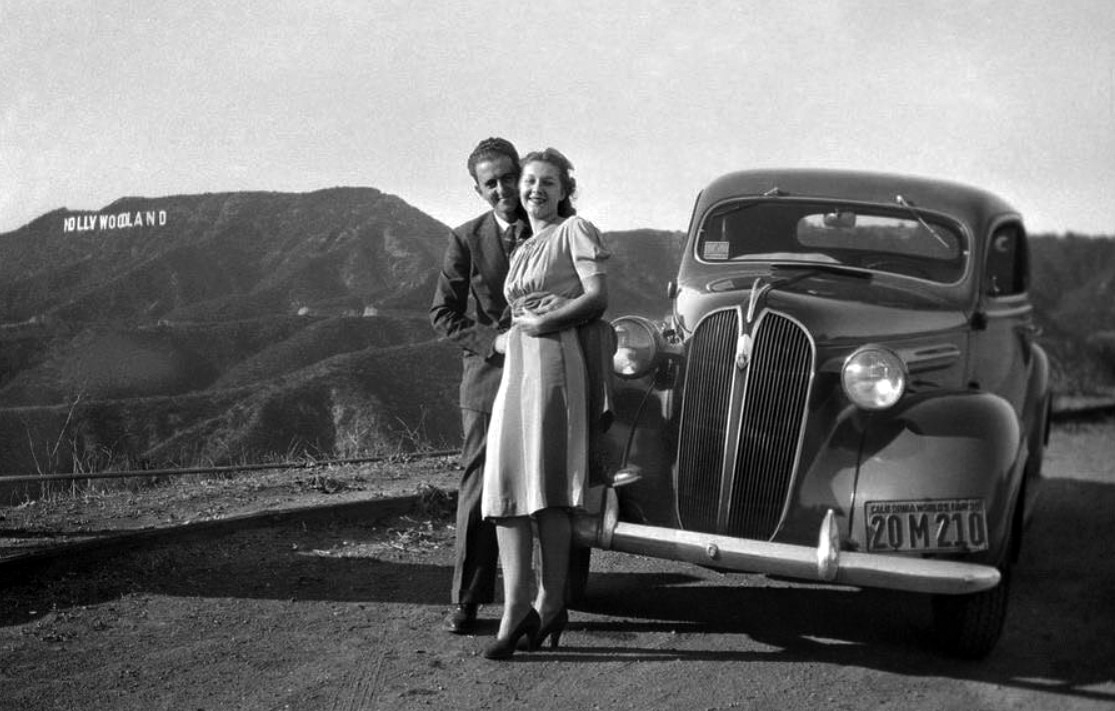 |
|
| (ca. 1937)* – A young couple poses for the camera in front of a 1937 Plymouth Coupe with the Hollywoodland Sign seen in the background. |
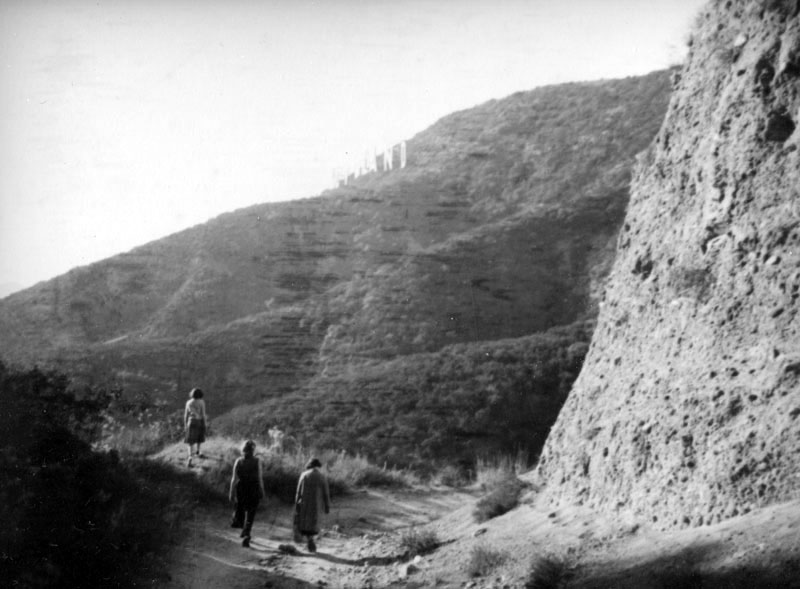 |
|
| (ca. 1938)* - Three women are seen hiking up the trail to the Hollywoodland Sign. Photo by Herman J. Schultheis |
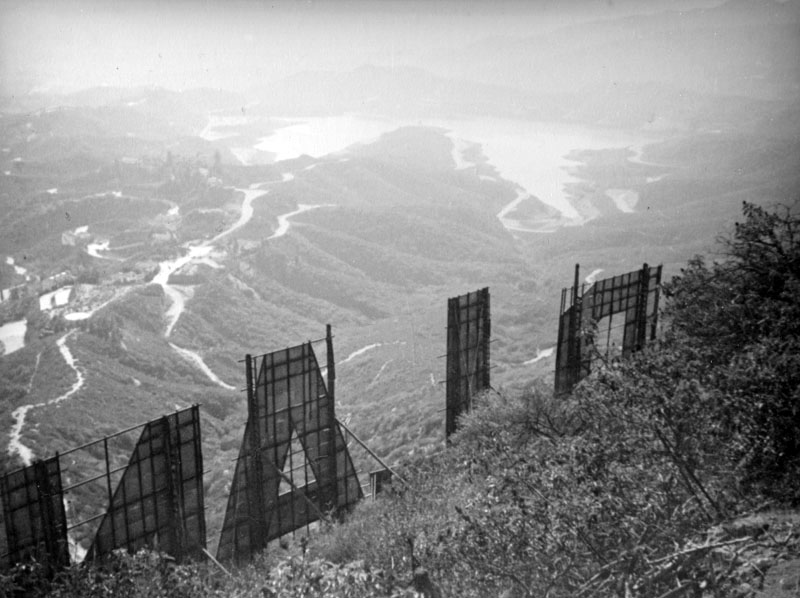 |
|
| (ca. 1938)* - This panoramic view taken from behind the Hollywoodland Sign captures the structure of the letters as well as Lake Hollywood on the right. Click HERE to see more Early Views of Lake Hollywood and Mulholland Dam. |
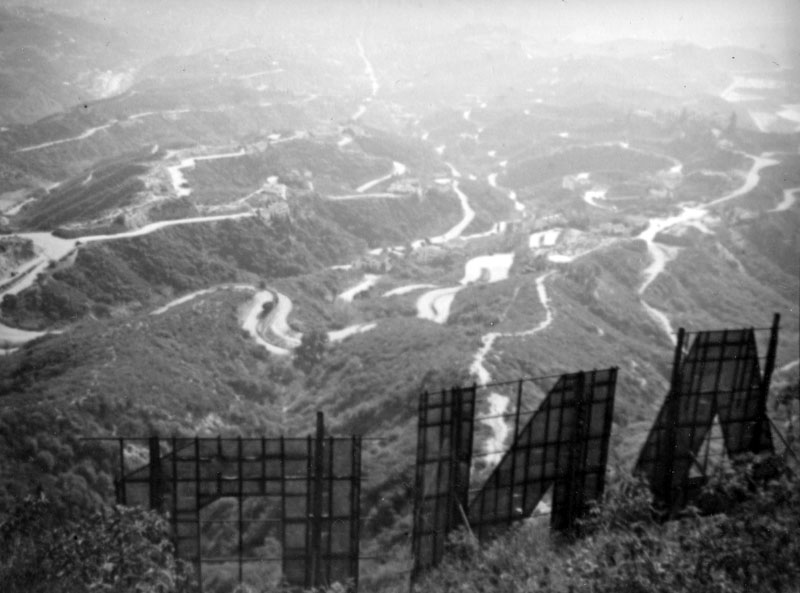 |
|
| (ca. 1938)* - View of the back of the Hollywoodland Sign capturing the structural supports of each individual letter and the curving mountain roads below. |
* * * * * |
Sunset and Gower (Gower Gulch)
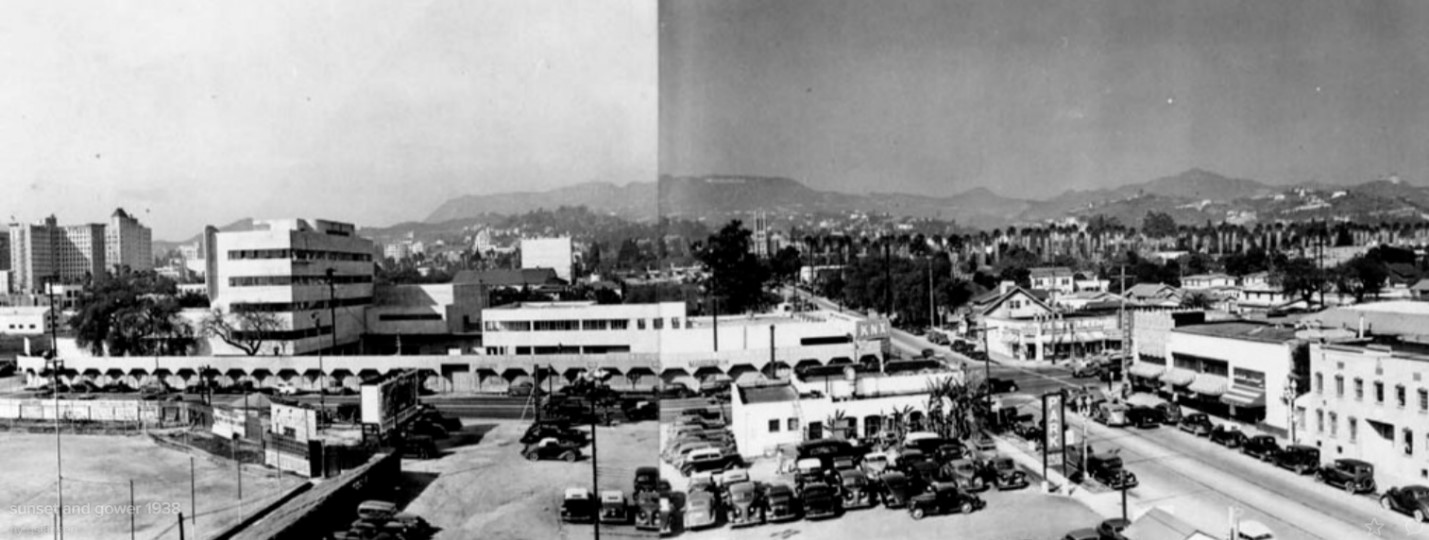 |
|
| (1938)^.^ – Panoramic composite view looking north toward the Hollyoowd Hills with the intersection of Sunset and Gower seen at right. The newly constructed Columbia Square is at left (prior to grand opening). The Hollywood Sign can be seen in the distance. |
Historical Notes Beginning in the 1930s, Gower Street earned the nickname "Gower Gulch" because of the many extras in Westerns who would dress in their cowboy costumes at home, then walk south to Paramount and RKO studios, which were all located just off Gower Street south of Sunset Boulevard. Today, a strip-mall named "Gower Gulch", built to resemble a Western set, sits on the southwest corner of Sunset and Gower as a reminder of that era. The phrase "Gower Gulch" is painted on an actual chuck wagon that sits on the site of the old "Copper Skillet" coffee shop, where the cowboys used to have their breakfast.^ |
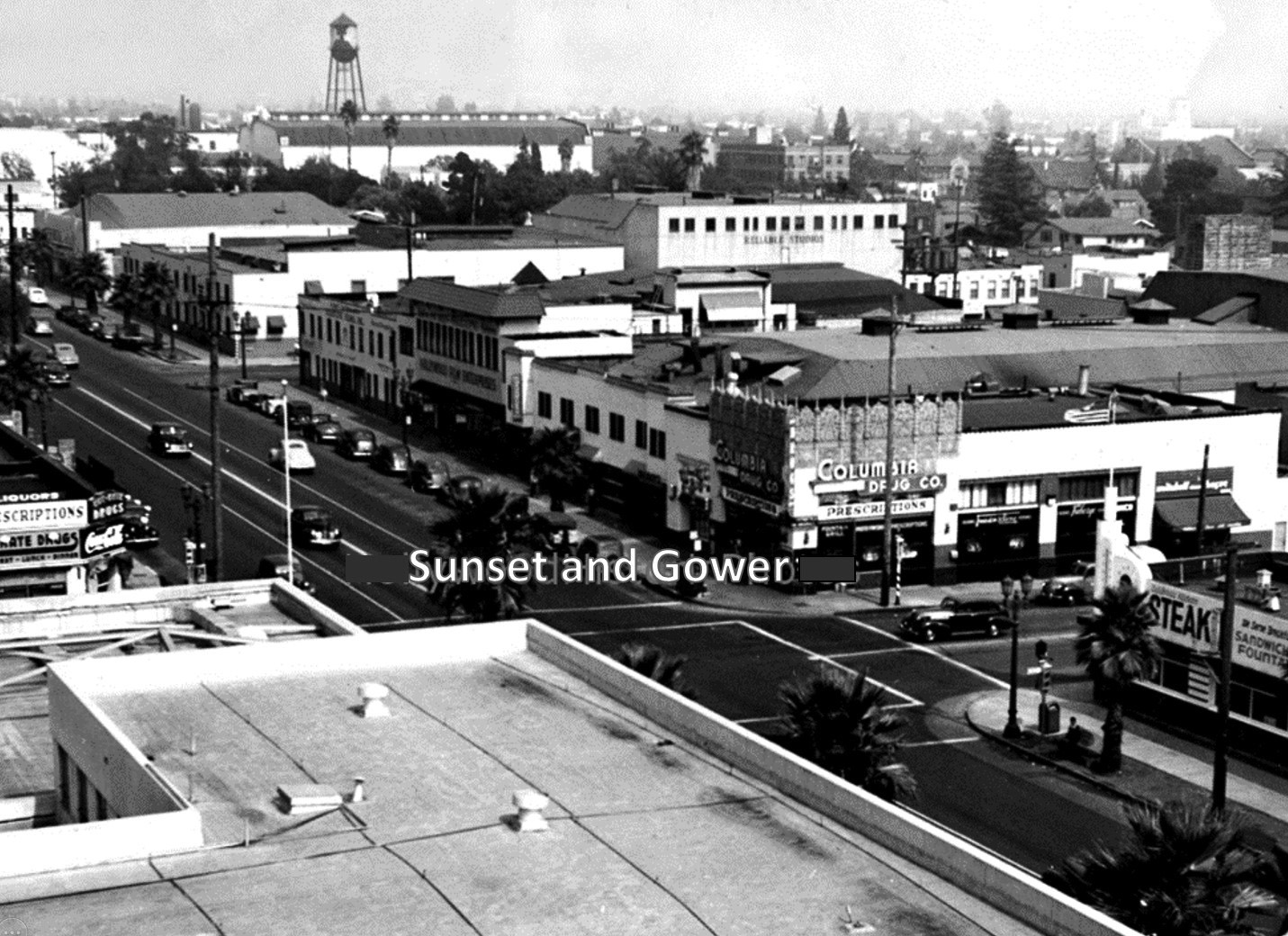 |
|
| (ca. 1940)** – View looking SE toward the intersection of Sunset and Gower as seen from the roof of Columbia Square. Two drug stores are seen at this famous intersection, one on the NE corner and the other on the SE corner (Columbia Drug Co.). A restaurant stands on the SW corner on the right with sign reading “Steaks, Sandwiches, and Fountain”. Studios are seen in the distance. |
Historical Notes Since the days of silent film, the surrounding area had contained several movie studios, including the Christie Studios (on the northwest corner) during the 1920s, then later, Columbia and Republic Studios to the south along Gower Street. Western films at both studios were extremely popular, especially from the 1930s through the 1950s, and actual working cowboys would come to Hollywood hoping to find work in the movies. They would congregate at that particular street corner, which is how it acquired its nickname. The Columbia Drug Store, which stood on the southeast corner for several decades, was a hangout for many western film extras in hopes of finding work, knowing the casting agents from the studio could reach them there. Indeed, John Wayne, Gene Autry, and Roy Rogers all got their start in this neighborhood, as did director John Ford. Columbia Studios was filming western films about every ten days for a time.* |
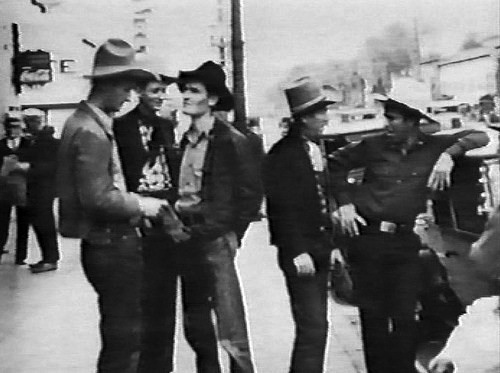 |
|
| (1933)** - View showing cowboy "extras" standing in front of Columbia Drug Store on the SE corner of Sunset and Gower. |
Historical Notes It was on this spot that movie "extras" lingered and waited for that lucky call from Columbia Studios casting office who turned out western movies about every 10 days. The cowboy extras were already dressed in their hats, chaps, and bandanas, prepared to act in a crowd scene in a saloon, or as a member of a posse, or a ranch hand. Pay was usually $5 a day, $10 for a speaking part. Hollywoodites later called it "Gower Gulch." * |
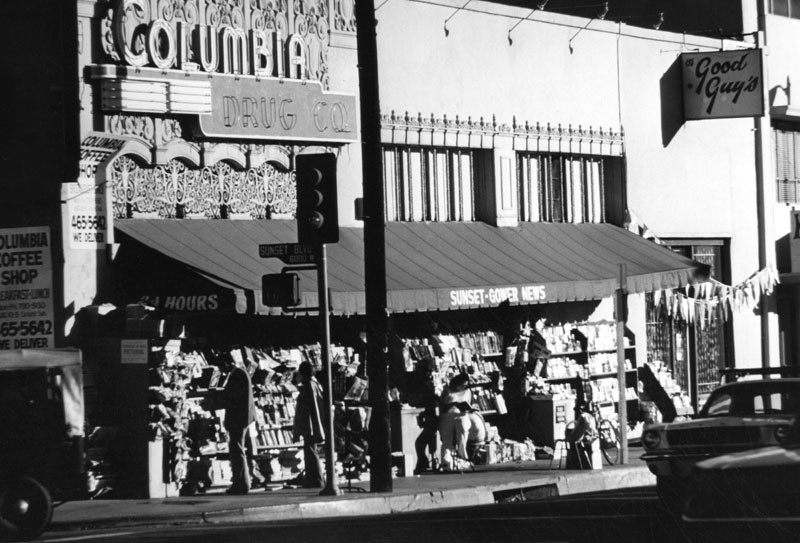 |
|
| (1977)* – Close-up view showing the Sunset-Gower Newstand in front of Columbia Drug Store, SE corner of Sunset and Gower. |
Historical Notes Drugstore cowboys awaited movieland employment at the corner of Sunset and Gower, where the manager of the Columbia Drug Co. let would-be extras use the phone booth. By the time of this photograph, in 1977, Sunset-Gower news had set up shop.^ |
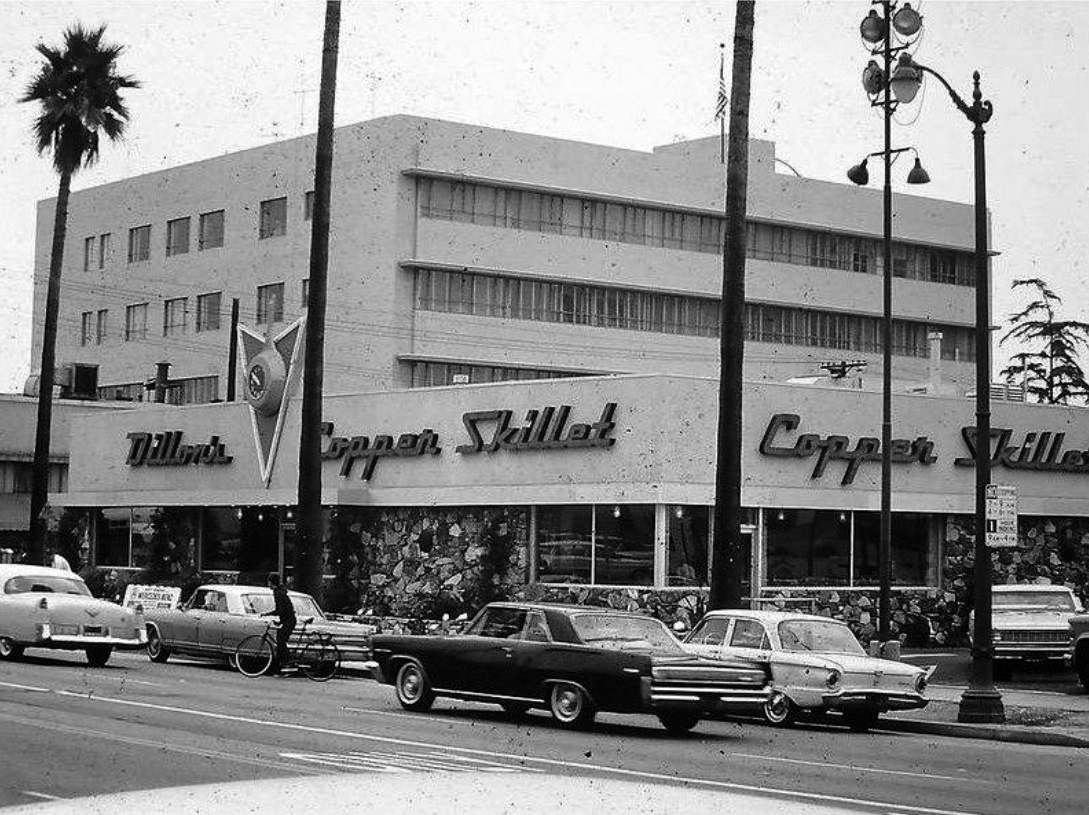 |
|
| (ca. 1965)^.^ – View showing Dillon’s Copper Skillet Coffee Shop located on the SW corner of Sunset and Gower. Today, a Denny’s sits at this location. |
Historical Notes The Copper Skillet at Sunset and Gower was a popular place, open ‘til midnight, a movie cowboy’s hangout. |
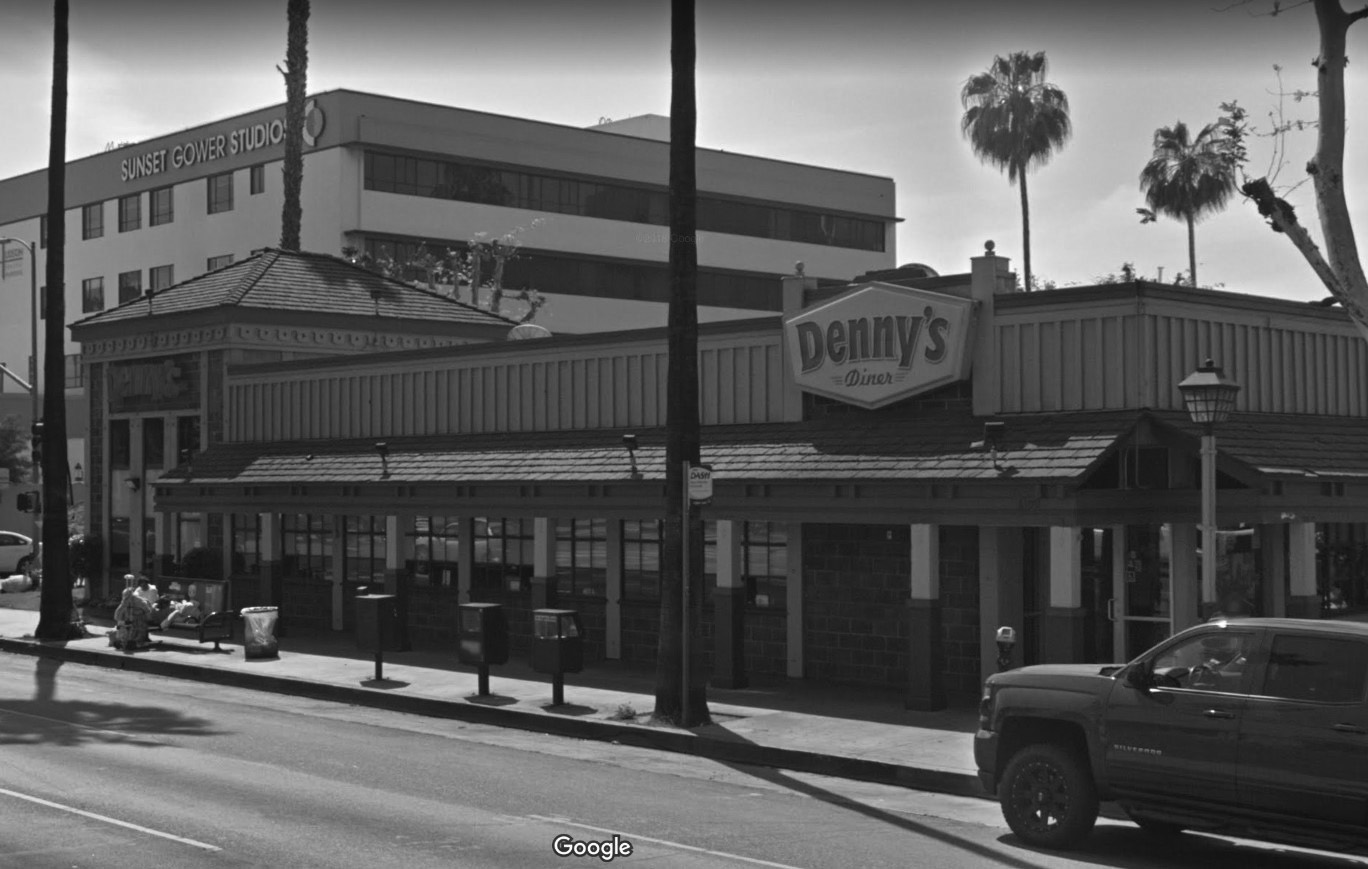 |
|
| (2019)^ – Google street view showing Denny’s Restaurant located on the SW corner of Sunset and Gower, where the Copper Skillet Coffe Shop once stood. |
Then and Now
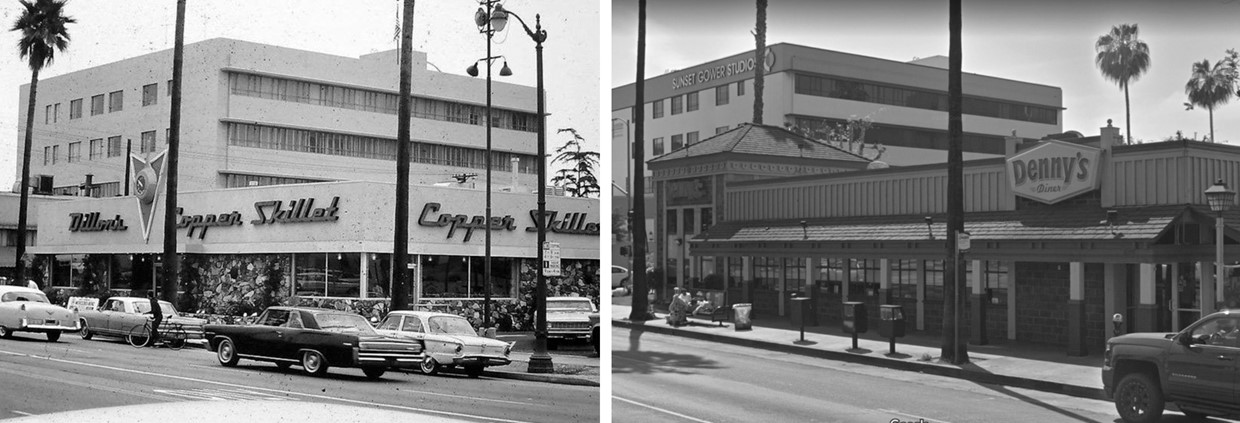 |
|
| (1965 vs 2019) - Looking at the SW corner of Sunset and Gower - Gower Gulch. |
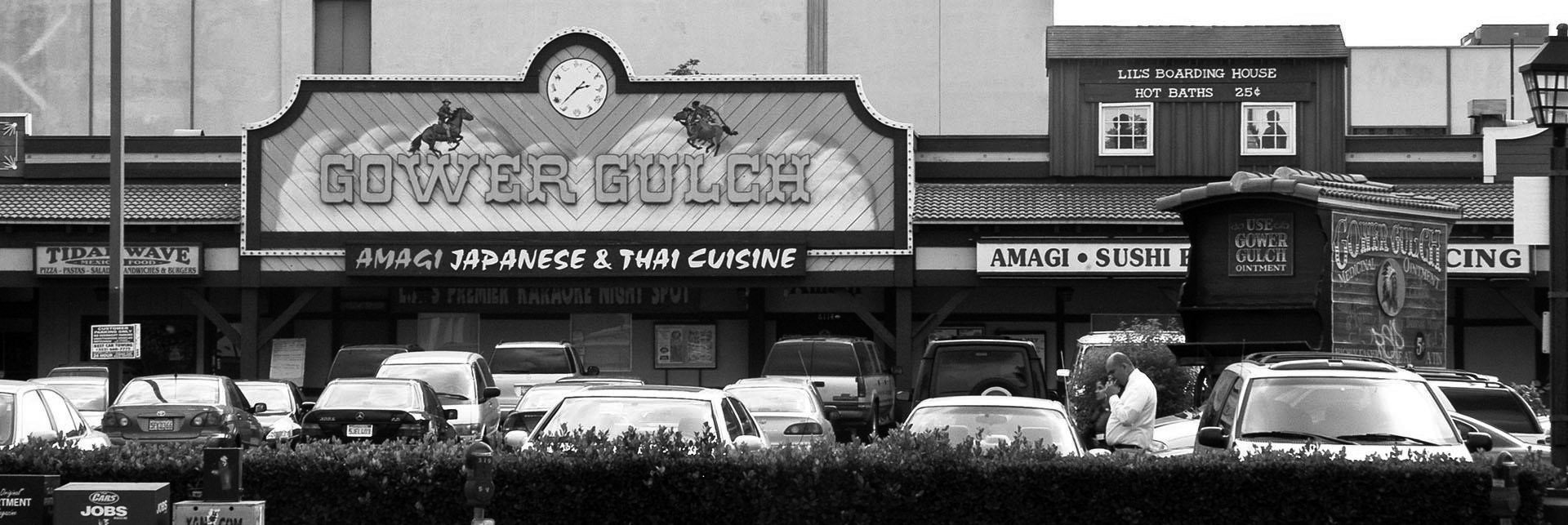 |
|
| (2016)^^ – Panoramic view looking south showing Gower Gulch. Denny’s is to the left out of view. |
Historical Notes A strip mall "paying homage to the past" and designed in the style of an Old West backlot was built in 1976 on the southwest corner of Sunset and Gower. The name "Gower Gulch" is painted on the side of a vintage western medicine show wagon. The strip mall remains unchanged as of 2016 and has been described as "Old West kitsch".^ |
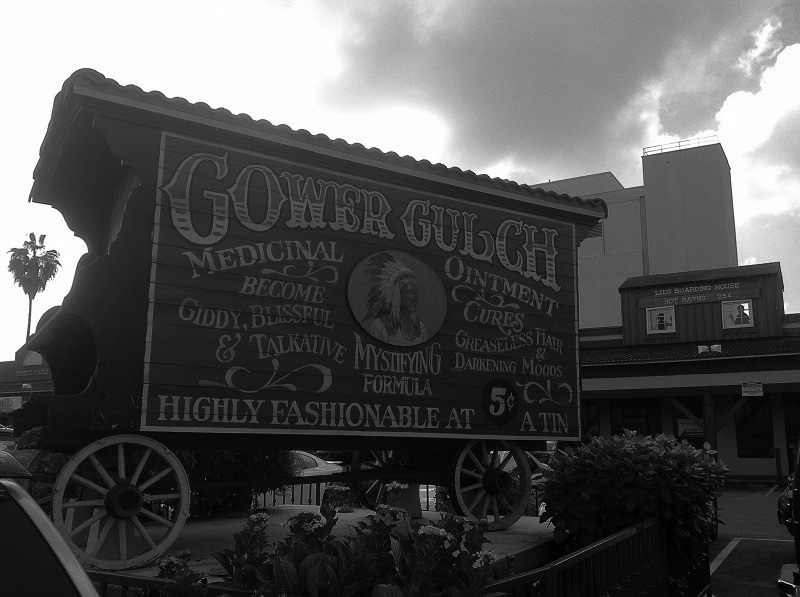 |
|
| (2012)*– Close-up view of a vintage western medicine show wagon in the parking lot of the Gower Gulch strip-mall. |
* * * * * |
CBS Columbia Square
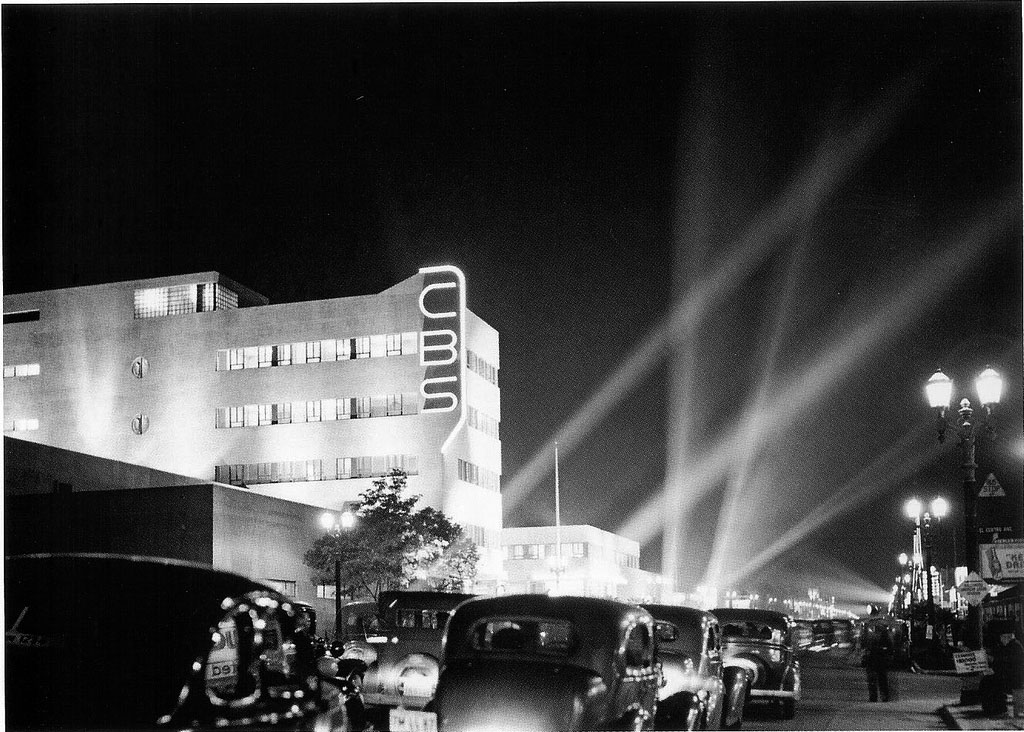 |
|
| (1938)* - Grand Opening of CBS West Coast Headquarters on Sunset Boulevard. Photo: Gregory P. Williams / The Cliff Wesselmann Collection. |
Historical Notes CBS Columbia Square, opened on April 30, 1938, was built for KNX and as the Columbia Broadcasting System's West Coast operations headquarters on the site of the Nestor Film Company, Hollywood's first movie studio. The Christie Film Company eventually took over operation of Nestor Studios and filmed comedies on the site, originally the location of an early Hollywood roadhouse. Prior to moving to Columbia Square, KNX had been situated at several Hollywood locations. |
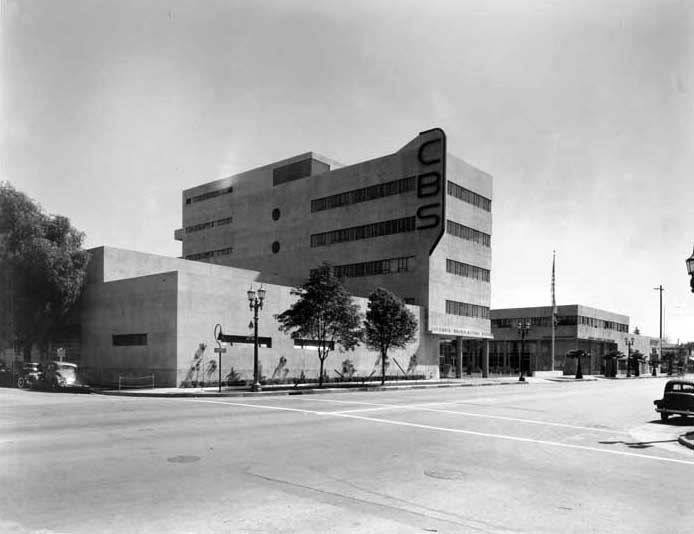 |
|
| (1938)* - Daytime view looking toward the northeast corner of El Centro Ave and Sunset Boulevard showing the newly constructed CBS Columbia Square. |
Historical Notes CBS Columbia Square was designed by Swiss-born architect William Lescaze in the style of International Modernism and built over a year at a cost of two million dollars — more money than had ever been spent on a broadcasting facility. |
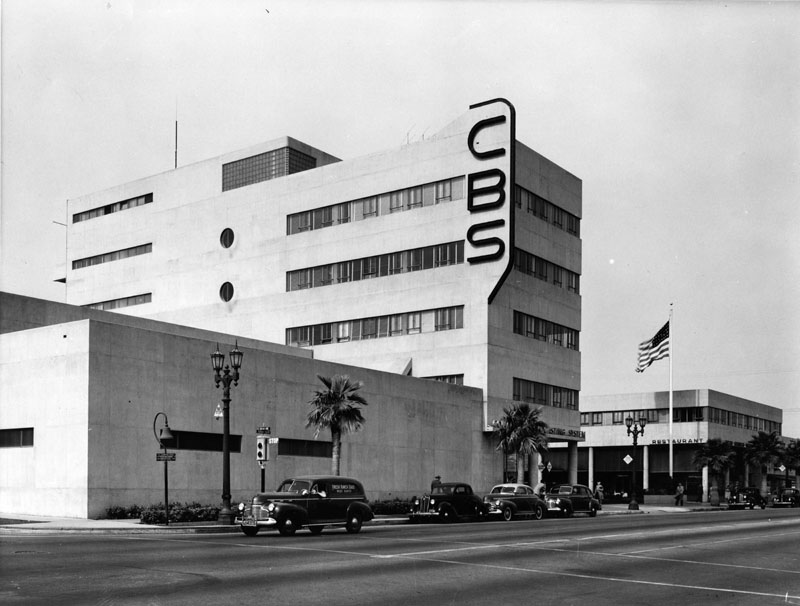 |
|
| (ca. 1938)* - CBS Columbia Square building, located at 6121 Sunset Boulevard. |
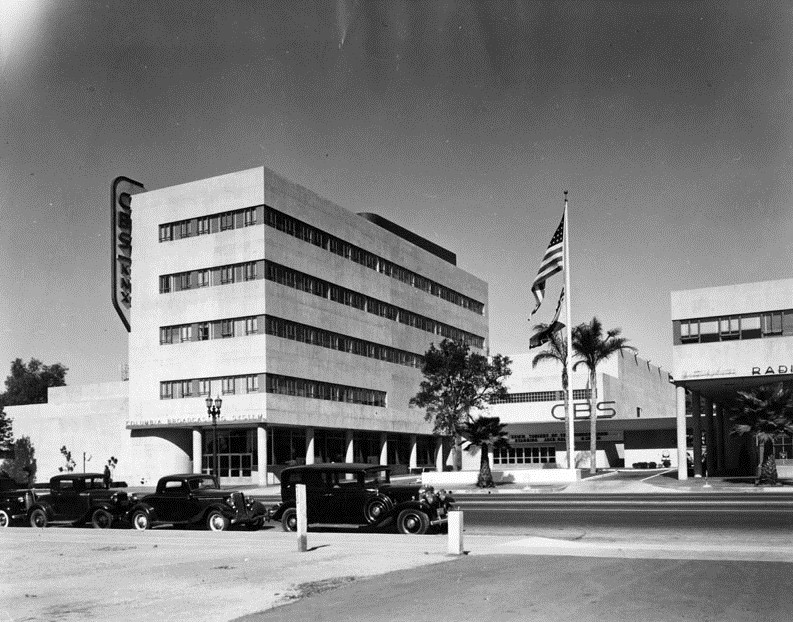 |
|
| (1939)* - Exterior view of the CBS Columbia Square building located at 6121 Sunset Boulevard. It was built on the site of the Nestor Studios, the first movie studio in Hollywood. |
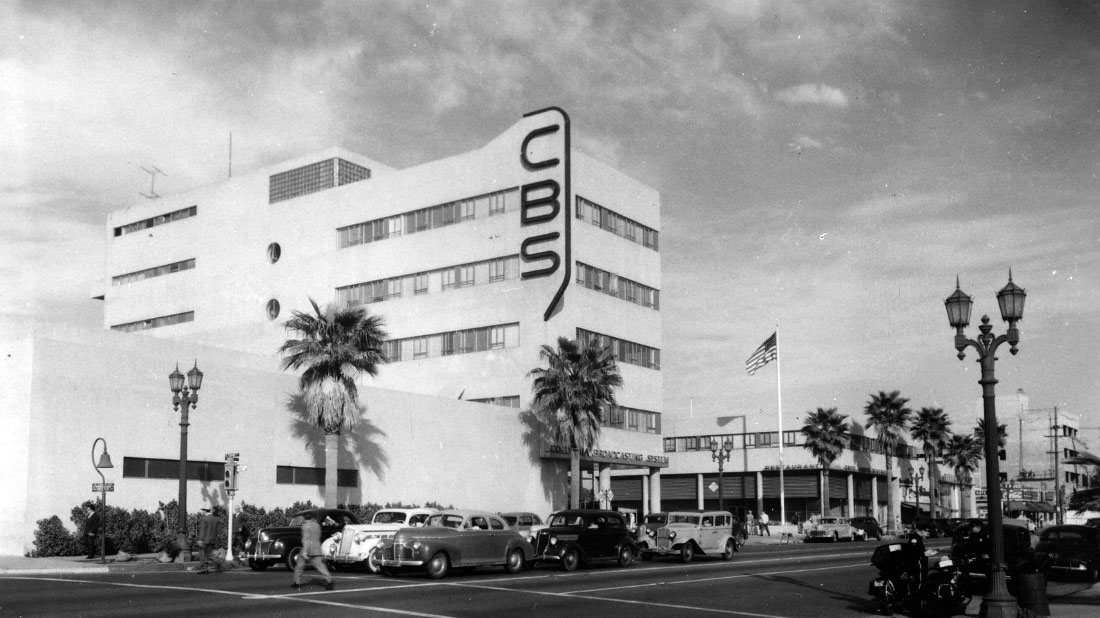 |
|
| (1939)* – View looking northeast from the intersection of El Centro and Sunset Boulevard showing Columbia Square. Note the El Camino Real marker on the corner at left. Click HERE for contemporary view. |
Historical Notes In early 2009, CBS Columbia Square Studios were designated as a historic-cultural monument by Los Angeles Cultural Heritage Commission. |
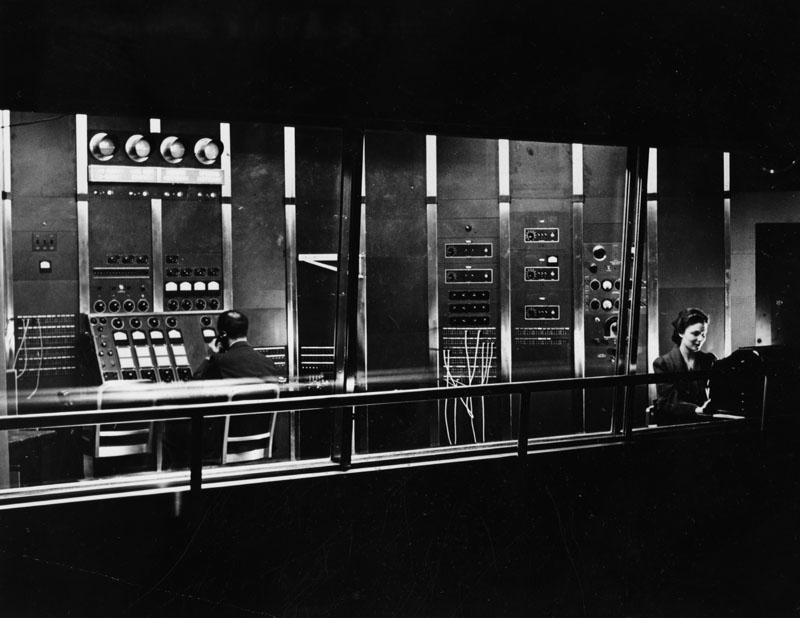 |
|
| (ca. 1939)* - Man sitting at the master control point of CBS, Hollywood Radio Center. Woman is operating the teleplex, an electric typewriter. |
Historical Notes The five-story CBS Columbia Square complex was home to radio stations KNX 1070 and KCBS 83FM, as well as CBS Channel 2 television station. |
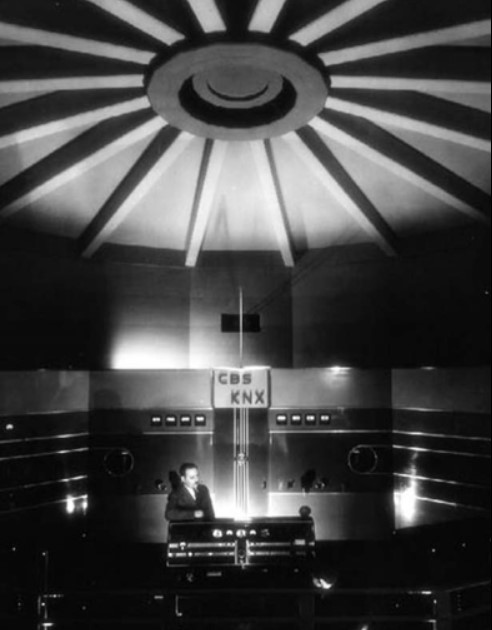 |
(ca. 1939)* - KNX Radio Control Room at CBS Columbia Square
. |
Historical Notes Radio broadcasts had studio audiences. They presented engineers and performers in a theatrical environment including lighting. The CBS studio was lit for atmosphere. |
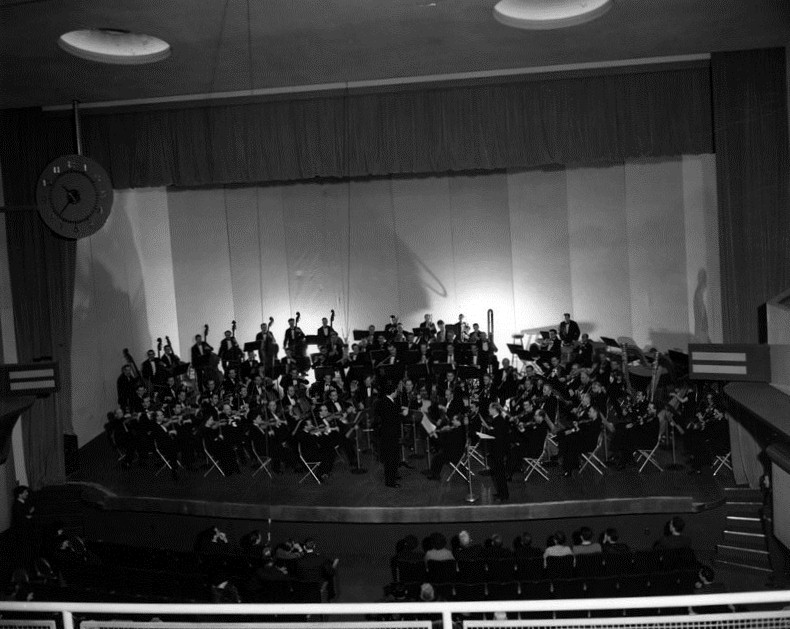 |
|
| (1939)* - The Los Angeles Philharmonic Orchestra performs on a stage to an audience at the CBS Columbia Square building for a KNX radio broadcast. |
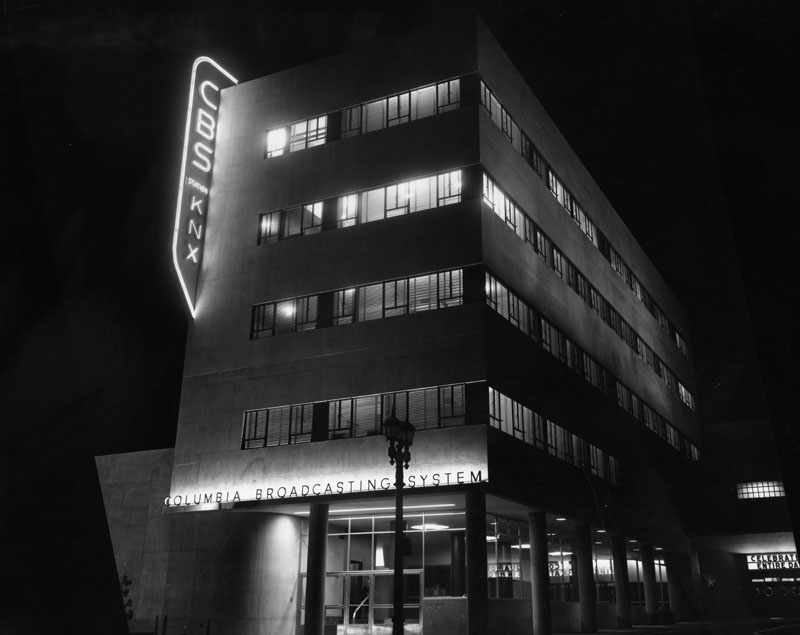 |
|
| (1939)* - A night view, with neon signs lit, of the exterior of the studio of CBS radio and its L.A. affiliate KNX. |
Historical Notes In 2005, KNX moved into new studios in the Miracle Mile neighborhood on L.A.'s Wilshire Boulevard which it shares with CBS Radio stations KFWB, KTWV, and KRTH. KNX was the last radio station to operate in Hollywood. In 2007, KCBS-TV and KCAL-TV also left the building and moved their operations to the CBS Studio Center in Studio City, thus ending Columbia Square's status as a broadcast facility. |
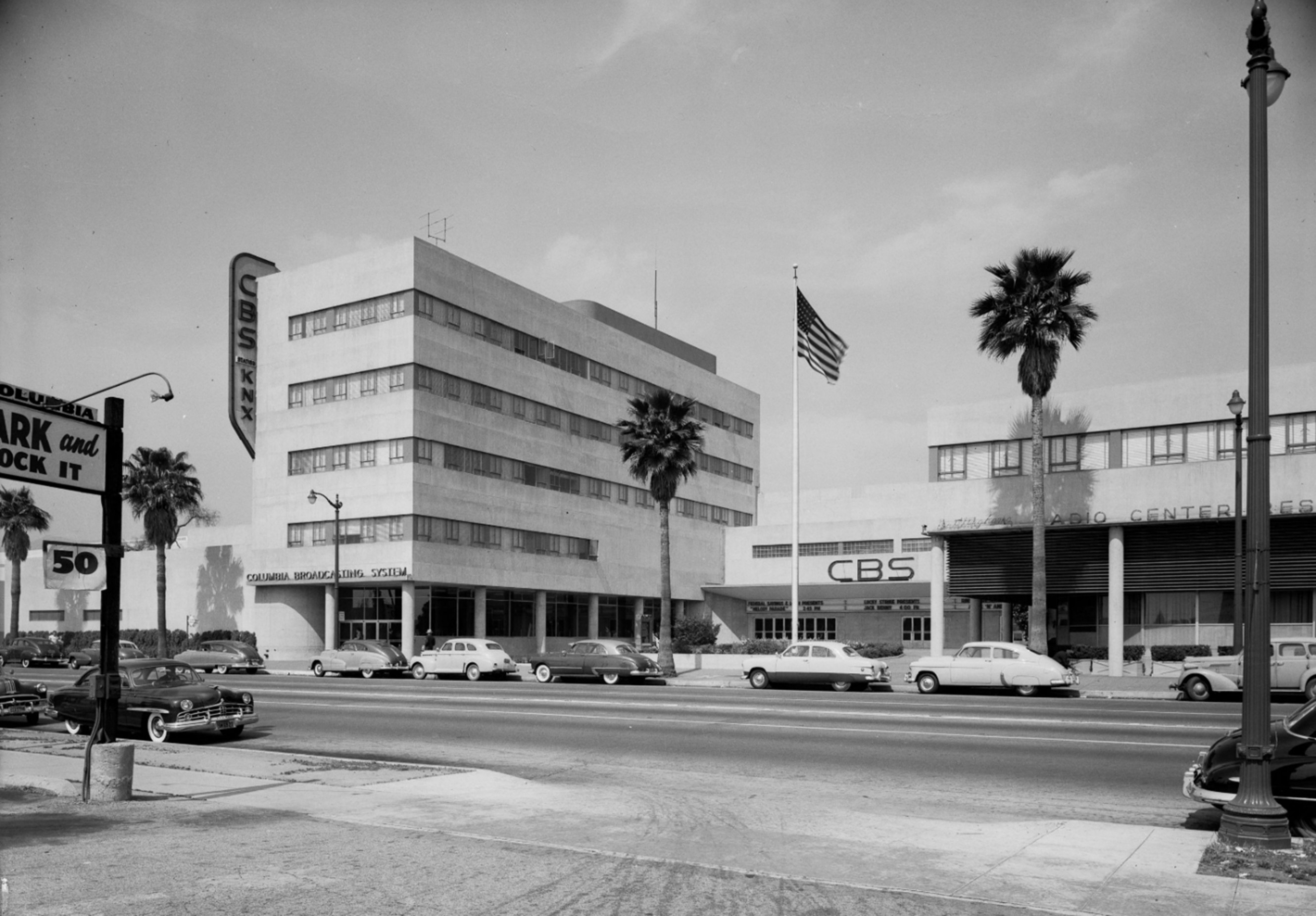 |
|
| (ca. 1949)* – CBS Columbia Square at 6121 Sunset Boulevard in Hollywood, seen from the driveway of Gower Gulch. The complex—home to KNX and other CBS radio and television operations—features distinctive Streamline Moderne architecture. A variety of late-1940s automobiles are parked along both sides of Sunset Boulevard, framed by tall palm trees and a prominently flying American flag. Photo by Bob Plunkett. |
Historical Notes By 1949, CBS Columbia Square was in its prime as the beating heart of West Coast radio. With eight studios—some added in 1940 to accommodate live audiences—the complex produced many of the most iconic programs of the era, including The Jack Benny Program, Burns and Allen, Edgar Bergen and Charlie McCarthy, Red Skelton, Suspense, and Gunsmoke. Musical legends like Bing Crosby, Doris Day, and Rosemary Clooney recorded here, while live broadcasts of big band music streamed from nearby venues like the Hollywood Palladium. Visitors could tour the studios for 40 cents, grab lunch at Brittingham's Radio Center Restaurant, or even bank on-site at the in-house Bank of America branch—all while brushing shoulders with stars in the lobby or forecourt. |
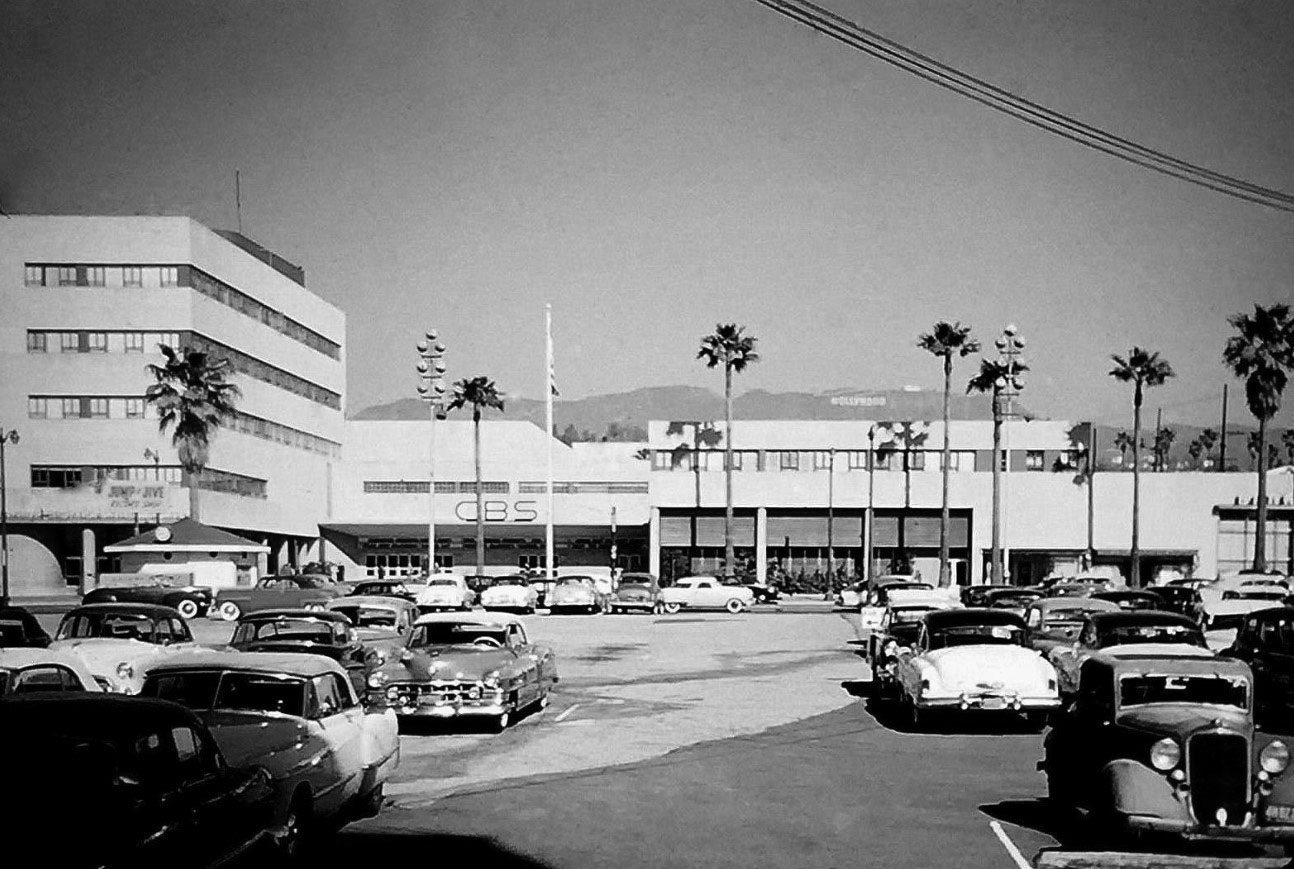 |
|
| (ca. 1951)* – View of CBS Columbia Square looking north from the Gower Gulch shopping center, close to where Denny’s currently is at Sunset and Gower. The Hollywood Sign is seen in the distance. Photo courtesy of Richard Wojcik / Vintage Los Angeles. |
Historical Notes By 1951, Columbia Square had become a pioneering center not just for radio but for the emerging world of television. Stage A—originally Studio A—had hosted the groundbreaking Ed Wynn Show in 1948, the first West Coast-based network variety program, and it was here in 1949 that Lucille Ball made her first national television appearance. A year later, the pilot for I Love Lucy was filmed on the same stage. The facility also housed the first tape recording and editing system for a national radio program, developed for The Bing Crosby Show, setting new production standards. With stars on the air and fans filling the courtyard, Columbia Square was a place where innovation met celebrity—cementing its place in broadcast history just before the rise of CBS Television City in 1952. |
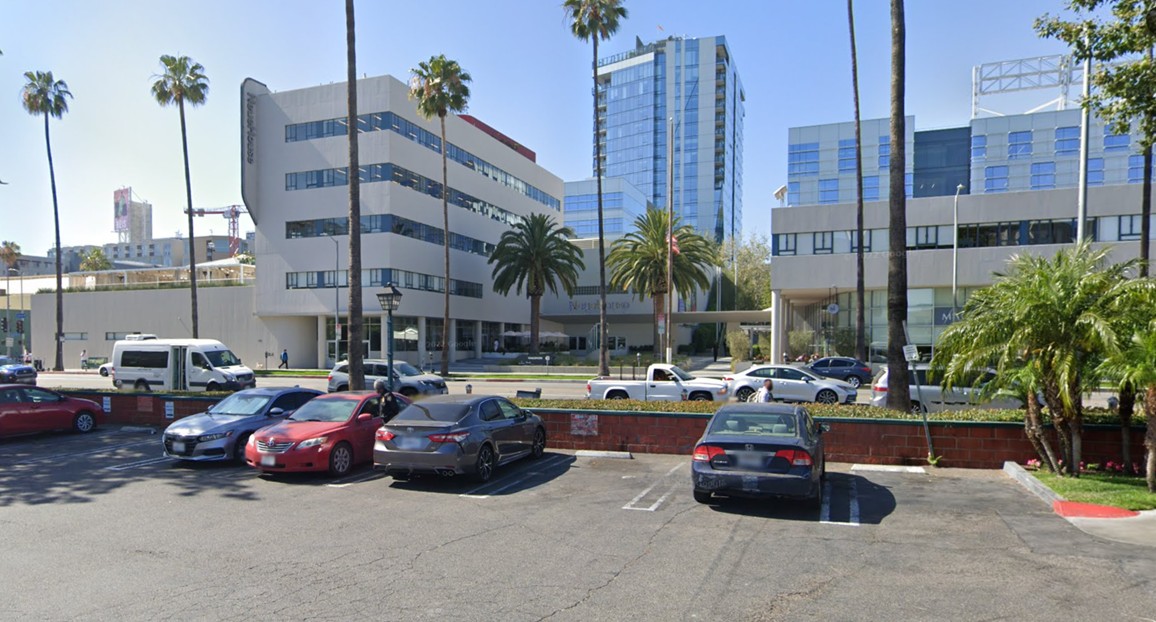 |
|
| (2022)* - Contemporary view of CBS Columbia Square looking north from the Gower Gulch shopping center, |
Historical Notes Today, CBS Columbia Square has been transformed into a modern, mixed-use campus that still honors its historic past. The original studio buildings have been carefully restored, while new office spaces, shops, and a 22-story apartment tower have been added. Major companies like Viacom and NeueHouse now work out of the site, which includes rooftop areas, a pool, gardens, restaurants, and places to relax or meet with others. Although it no longer hosts radio or TV broadcasts, Columbia Square continues to be an important part of Hollywood, showing how old landmarks can be successfully updated for new uses. |
Then and Now
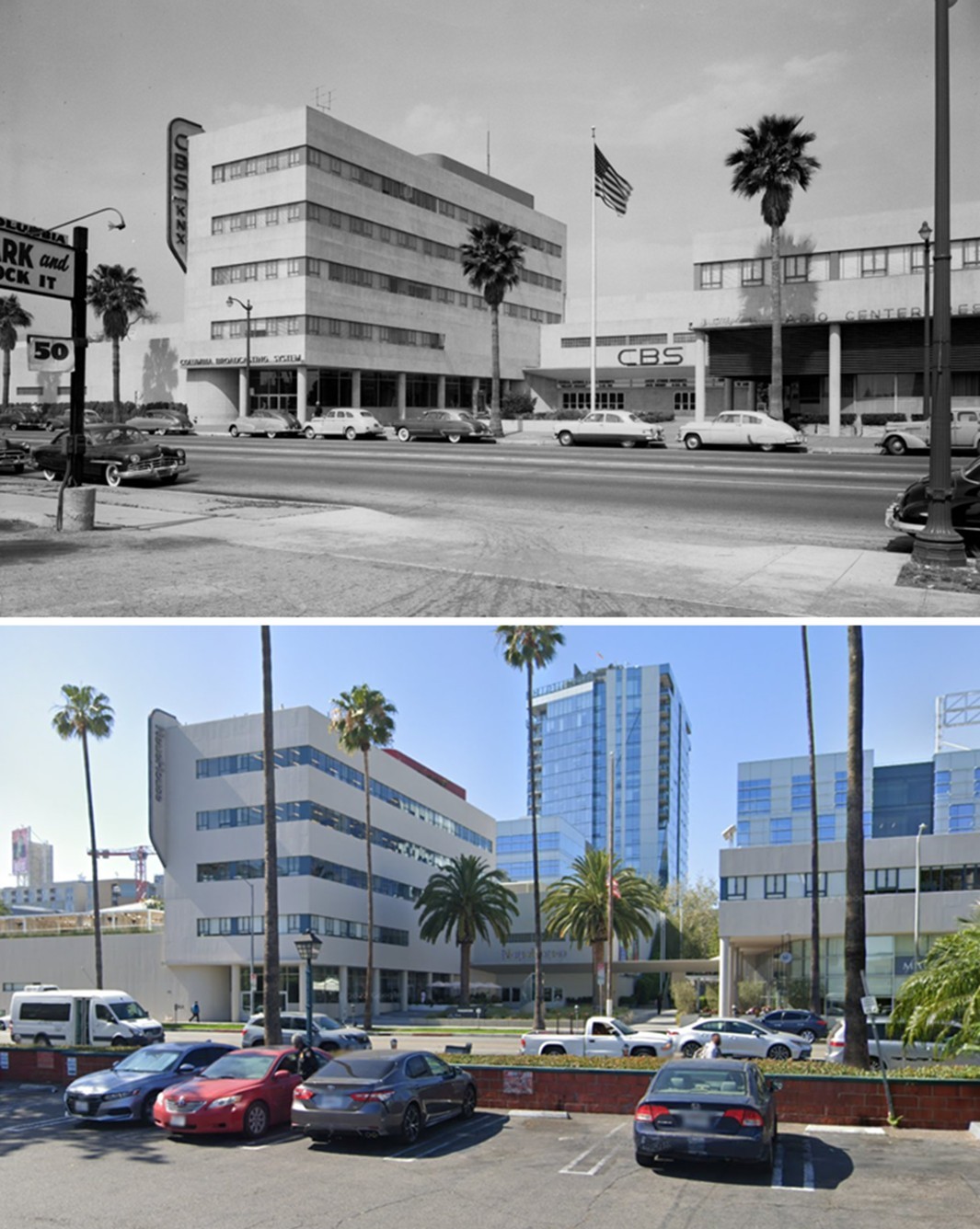 |
|
| (1949 vs. 2022)* – A ‘Then and Now’ view looking across Sunset Boulevard from the Gower Gulch parking lot toward CBS Columbia Square in Hollywood. The original CBS buildings, once home to some of the most famous radio and TV shows of the era, still stand today but have been carefully restored. The site is now part of a modern campus that includes new offices, shops, and a 22-story apartment tower behind the historic structures. Photo comparison by Jack Feldman. |
* * * * * |
NBC Radio City - Sunset and Vine
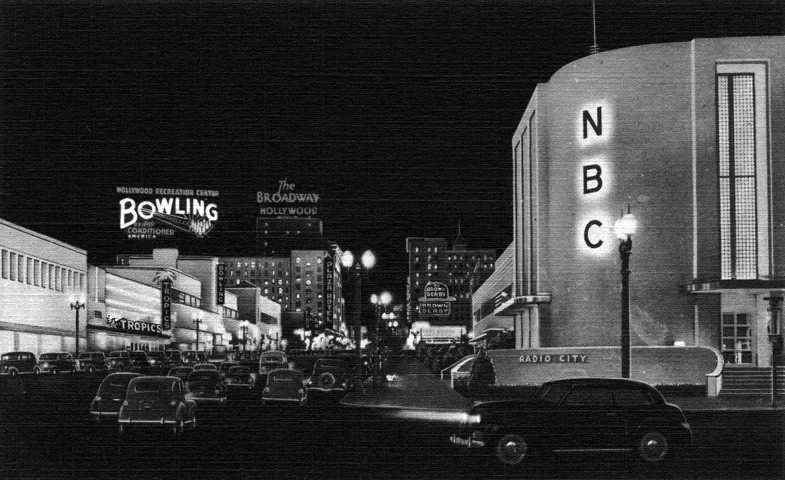 |
|
| (ca. 1938)* - Postcard view looking north on Vine Street at Sunset Boulevard. On the northeast corner stands the newly constructed NBC Radio City. Visible signs in the background include (L to R): Tropics, Hollywood Recreation Center Bowling, Plaza Hotel, The Broadway-Hollywood, Taft Building, and the Brown Derby. |
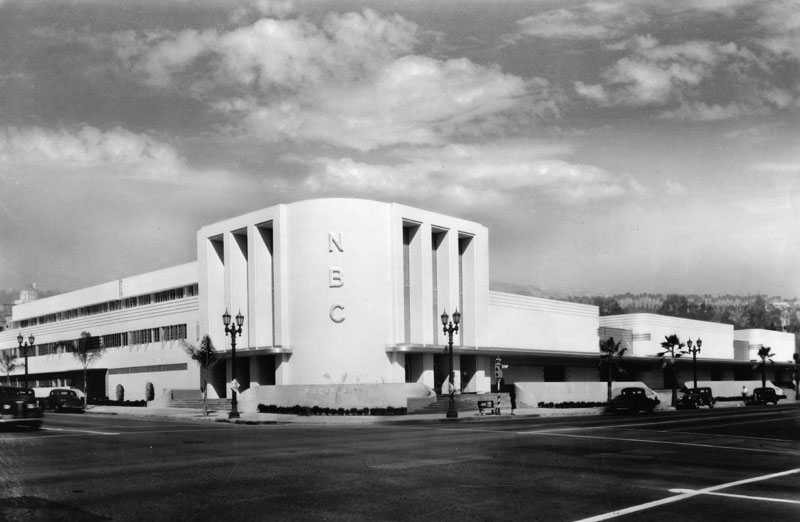 |
|
| (1938)* - An exterior view of NBC's studio, Hollywood Radio City, located in Hollywood on the northeast corner of Sunset Blvd. and Vine St. The art deco station was designed by John Austin and built in 1938. |
Historical Notes The West Coast Radio City opened in 1938, the same year as the CBS Columbia Square. It served as headquarters to the NBC Radio Networks' (Red and Blue) West Coast operations and replaced NBC's radio broadcast center in San Francisco, which had been around since the network's formation in 1927. |
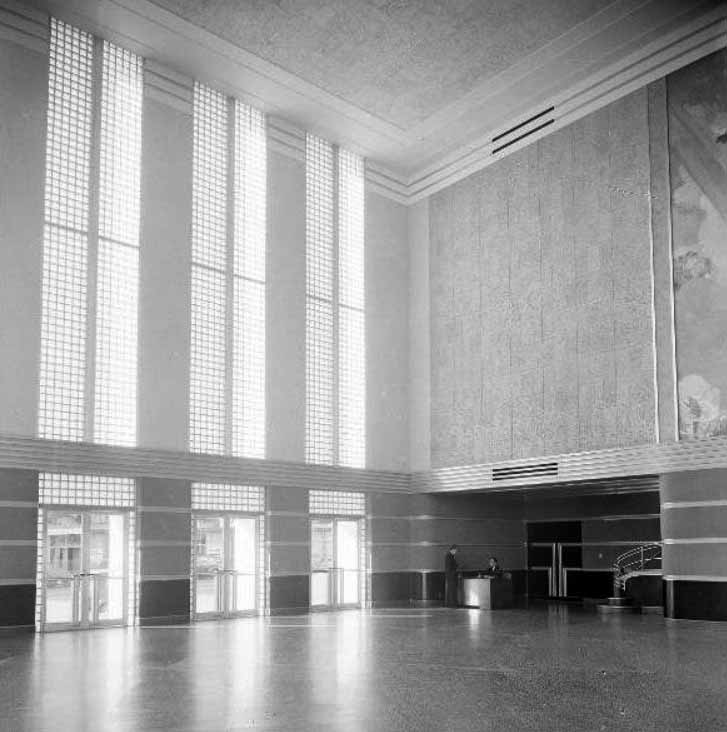 |
|
| (ca. 1940)* - Interior view of the front entrance to the studios at NBC Hollywood Radio City. The floor-to-ceiling glass tile windows allows natural light to fill the very large open spaced lobby. |
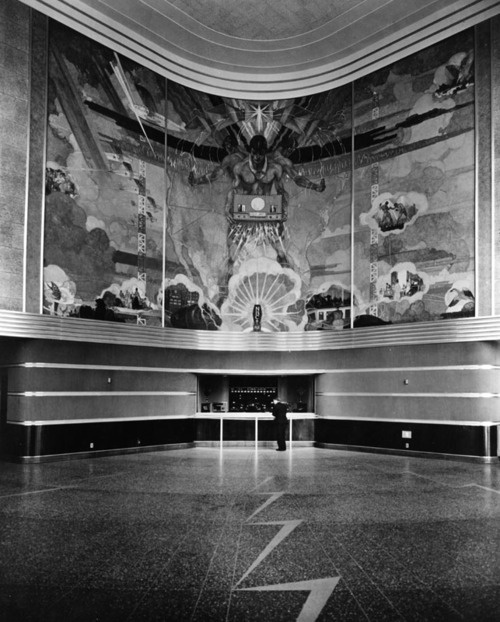 |
|
| (ca. 1938)* - View of the lobby of NBC’s Hollywood Radio City dominated by 25 x 40 ft. mural painted by Ed Trumbull of New York. Beneath mural is the master control room. |
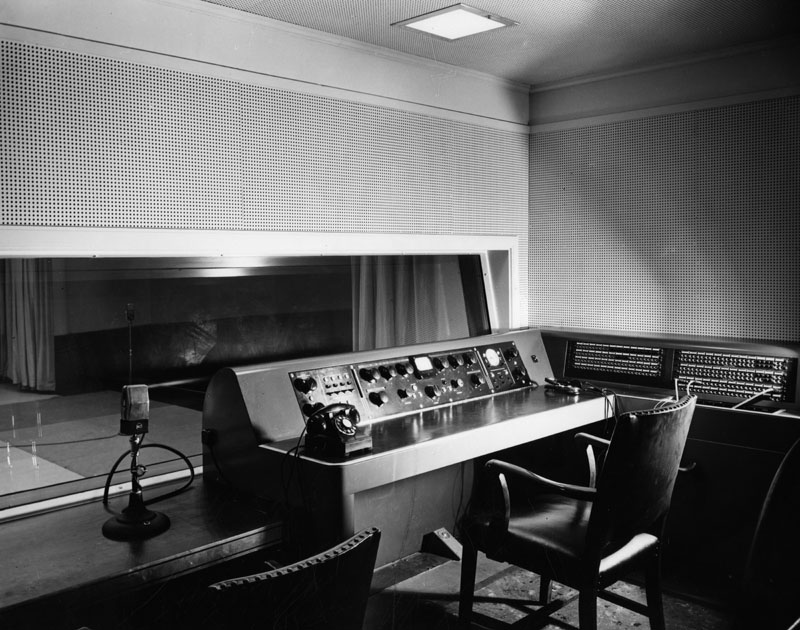 |
|
| (1938)* - Engineer's control room in NBC's Hollywood Radio City. |
Historical Notes NBC’s West Coast Radio City building had 8 large individual studios, four of which had capacity for several hundred people. The technical facilities included the most modern RCA equipment. |
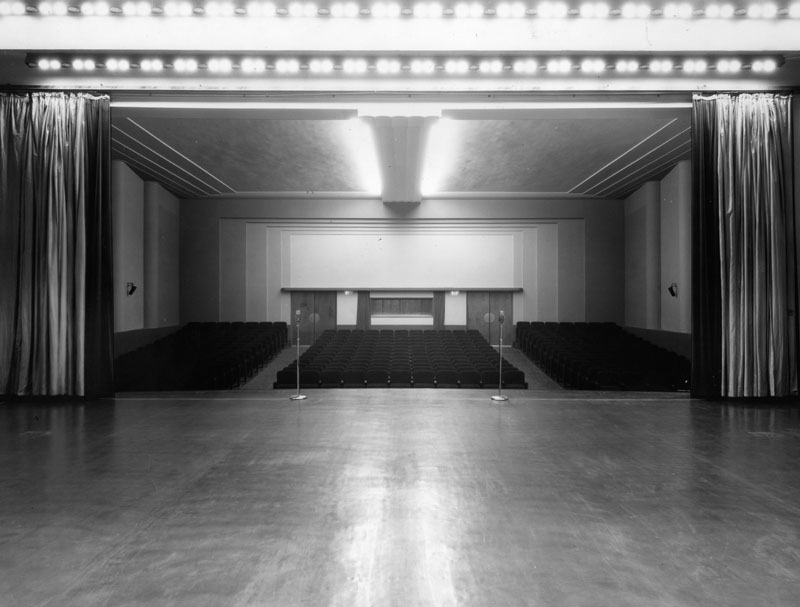 |
|
| (1939)* - Studio "D" in NBC's Hollywood Radio City viewed taken from the back of the stage facing the auditorium. |
Historical Notes In the 1930’s, 40’s, and 50’s the NBC studio complex, coupled with CBS Columbia Square (located just down the street), was home to all the major radio studios that broadcast coast to coast. It’s where the great personalities of the day, including Bing Crosby, Bob Hope, Jack Benny, Burns and Allen, Al Jolson and many more assembled to entertain America. |
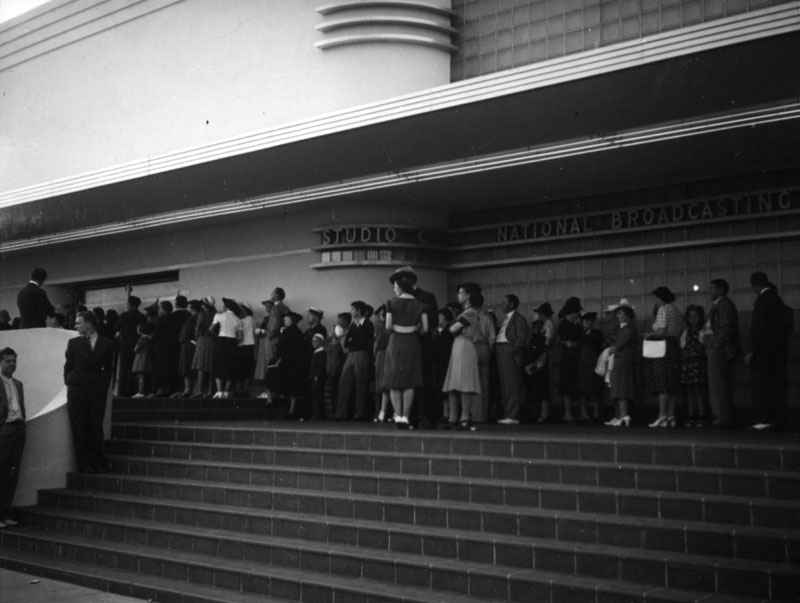 |
|
| (ca. 1939)* - A crowd stands in line waiting to attend the taping of a program at the huge NBC studio complex, located on the northeast corner or Sunset Boulevard and Vine Street. |
Historical Notes The National Broadcasting Company originally used the phrase Radio City to describe their studios at Rockefeller Center in New York City. When NBC opened their new Hollywood studios at Sunset and Vine in 1938, they placed the words Radio City prominently on the front of their new building. However, the area between Hollywood Boulevard and Sunset Boulevard on Vine Street became known as Radio City for tourists and locals alike who visited the many radio studios and radio themed cocktail lounges and businesses in the area. |
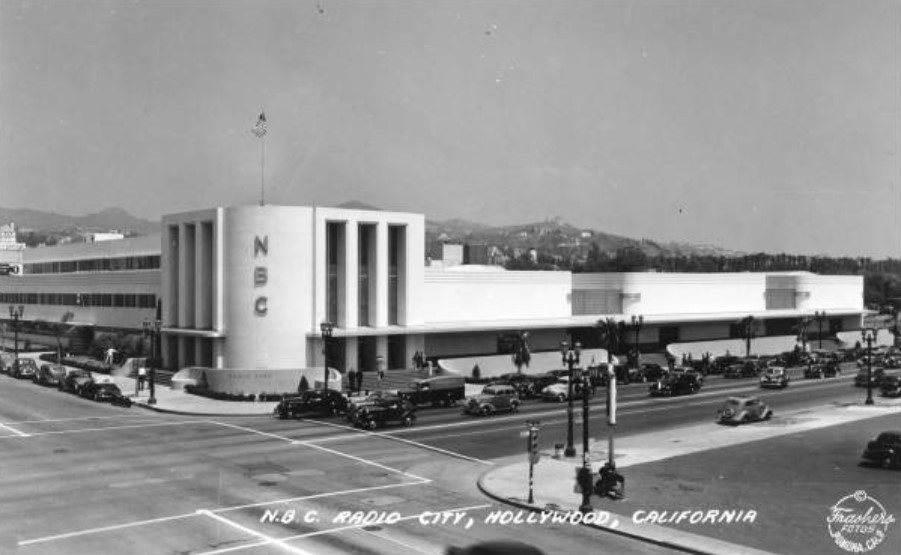 |
|
| (1939)* – Postcard view looking at NBC Radio City on the northeast corner of Sunset and Vine, Hollywood. |
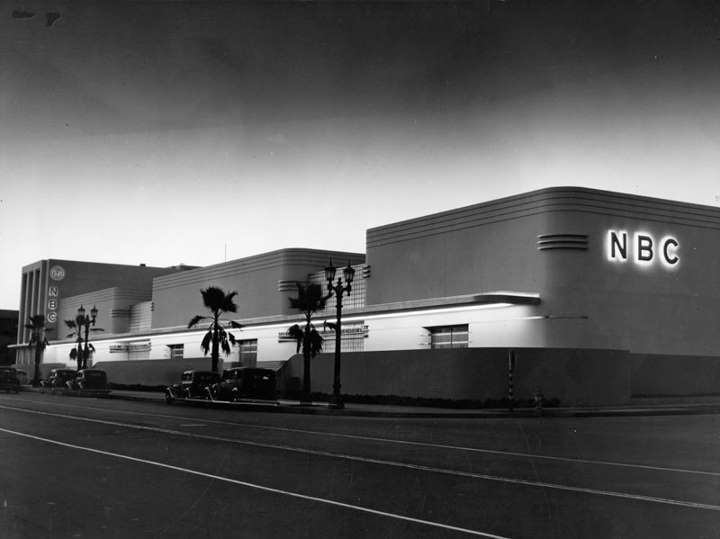 |
|
| (1940s)* - Dusk view looking at the northwest corner of Sunset and Argyle Avenue showing a lit-up NBC Hollywood Radio City building. |
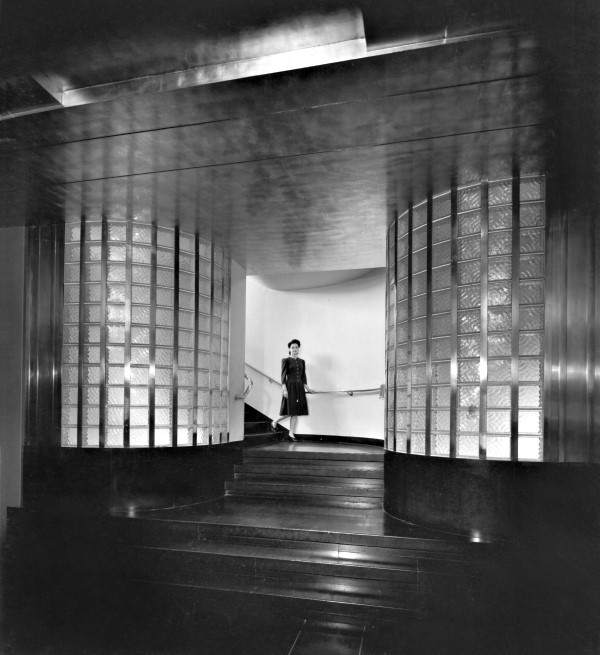 |
|
| (1940s)* - NBC interior staircase. |
 |
|
| (1940s)* - View of a man walking on Sunset Blvd toward Vine St in front of the Streamline Moderne NBC Radio City building. |
Historical Notes The beautiful Streamline Moderne building was designed by Architect John C. Austin, who also designed many other impressive buildings including City Hall, Griffith Observatory, Hollywood Masonic Temple, and the Shrine Auditorium. |
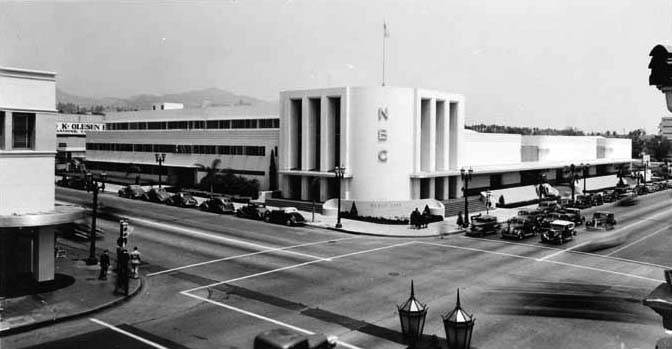 |
|
| (ca. 1939)* - View looking northeast at the intersection of Sunset Boulevard and Vine Street. NBC's Radio City stands on the corner. Note the ornate dual-lamp streetlight at the bottom of photo. Click HERE to see more in Early Views of LA Streetlights. |
* * * * * |
Sunset and Vine
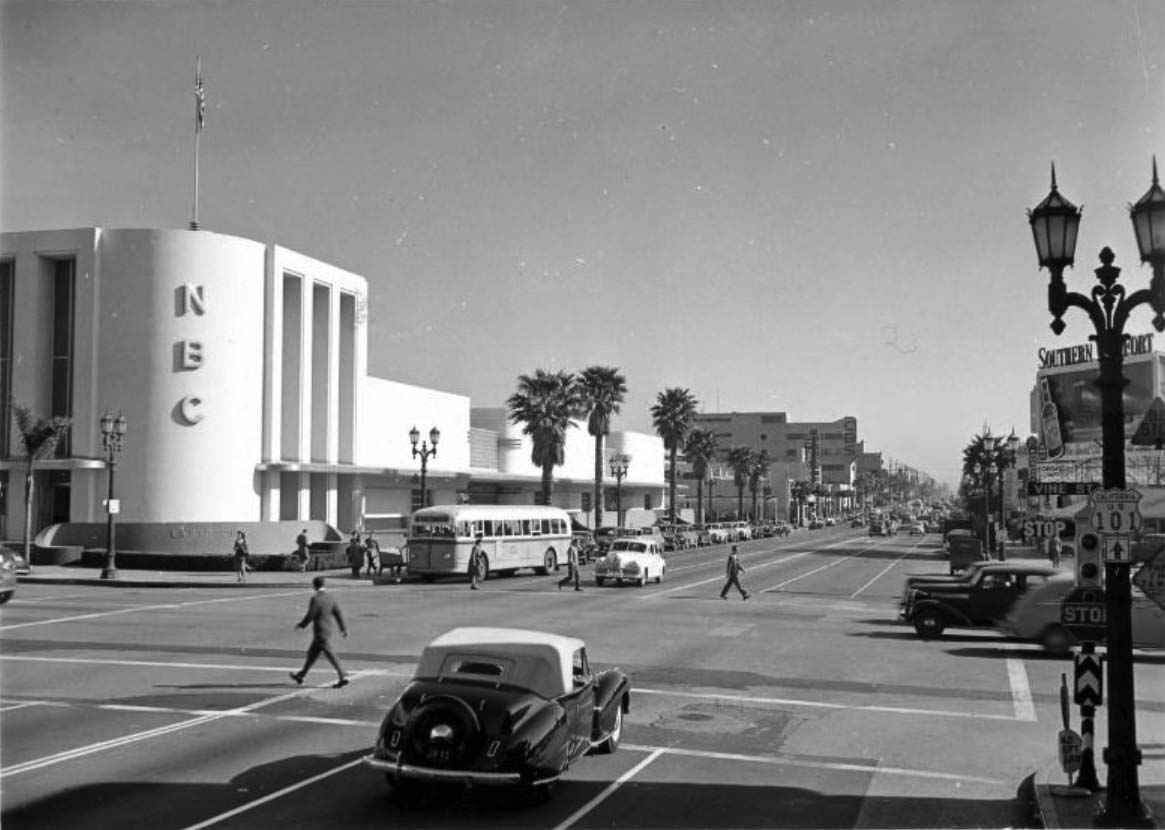 |
|
| (ca. 1940)* – View looking east on Sunset Boulevard at Vine Street with NBC's Radio City on the N/E corner with California US 101 sign seen on the lampost at right. |
Historical Notes The original surface alignment of US Route 101 was signed in Los Angeles during 1930 following Boyle Avenue, Plesant Avenue, Macy Street, Main Street, Sunset Boulevard, Cahuenga Boulevard and Ventura Boulevard. |
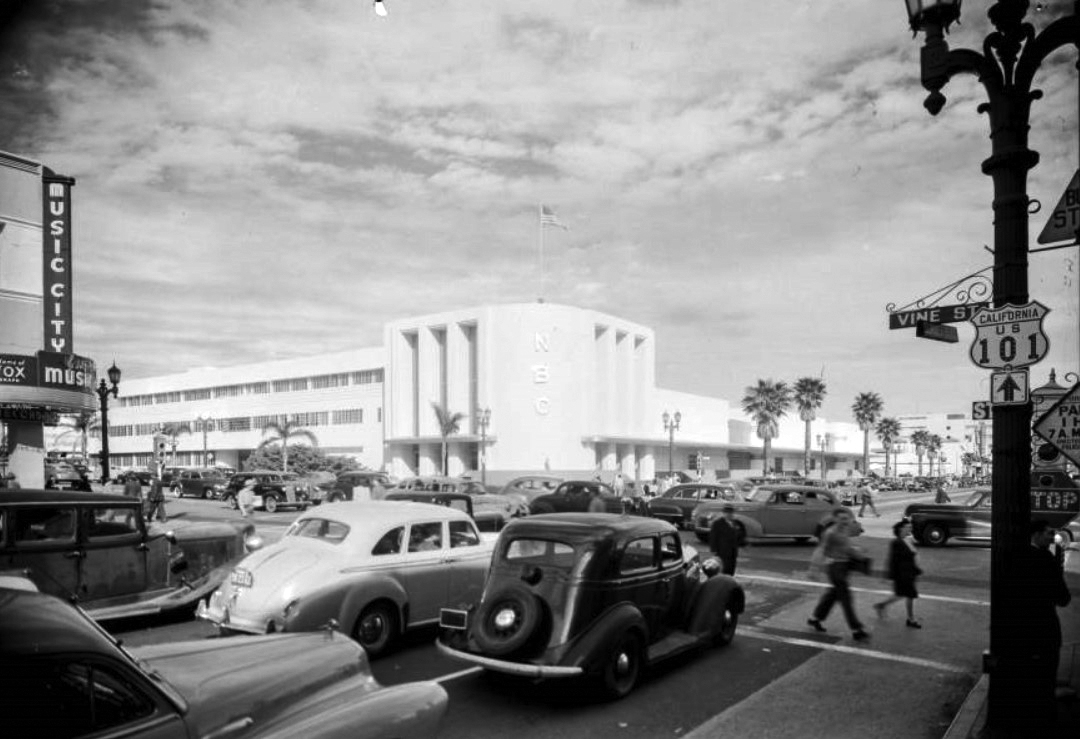 |
|
| (1940s)* – View showing heavy traffic at the intersection of Sunset Boulevard and Vine Street with the Radio City NBC studio at center and the Wallichs Music City record store at left. Signs for "Vine St." and "California US 101" are seen at far right. |
Historical Notes Music City record store opened in 1940 on the N/W corner of Sunset and Vine. |
 |
|
| (1947)* – Postcard view looking north on Vine Street from in front of NBC Radio City at Sunset Boulevard. Photo: Bob Plunkett. |
Historical Notes In 1947, Vine Street between Sunset Boulevard and Hollywood Boulevard was a bustling hub of Hollywood’s entertainment industry, heavily influenced by radio and television production. Landmark buildings like NBC’s Hollywood Radio City at Sunset and Vine and the newly constructed Mutual-Don Lee Studios at 1313 Vine Street solidified the area’s reputation as a center for media innovation. Tom Breneman’s Restaurant, famous for hosting live broadcasts of Breakfast in Hollywood, drew crowds eager to experience the glamour of live radio. Nearby businesses, such as Coffee Dan’s and local tailors and stationers, added to the vibrant commercial atmosphere. |
 |
|
| (2024)* – Looking north on Vine Street from the sidewalk in front of the Chase Bank parking lot near Sunset Boulevard. |
Historical Notes Vine Street between Sunset and Hollywood boulevards has changed dramatically since 1947. Once the vibrant heart of Hollywood’s entertainment scene—lined with radio studios, Art Deco landmarks, neon-lit nightclubs, and spots like the Pantages Theatre and Owl-Rexall Drug Store—it buzzed with celebrities, tourists, and a sense of glamour. Today, while a few historic icons remain, Vine Street has shifted toward tourism, luxury development, and digital media, with high-rises, Netflix offices, and improved streetscapes that include wider sidewalks and bike lanes. Though still a popular destination thanks to the Hollywood Walk of Fame, the area now faces challenges such as homelessness and the loss of some historic venues. Vine Street continues to evolve as a modern, mixed-use corridor, blending echoes of its golden past with ongoing revitalization. |
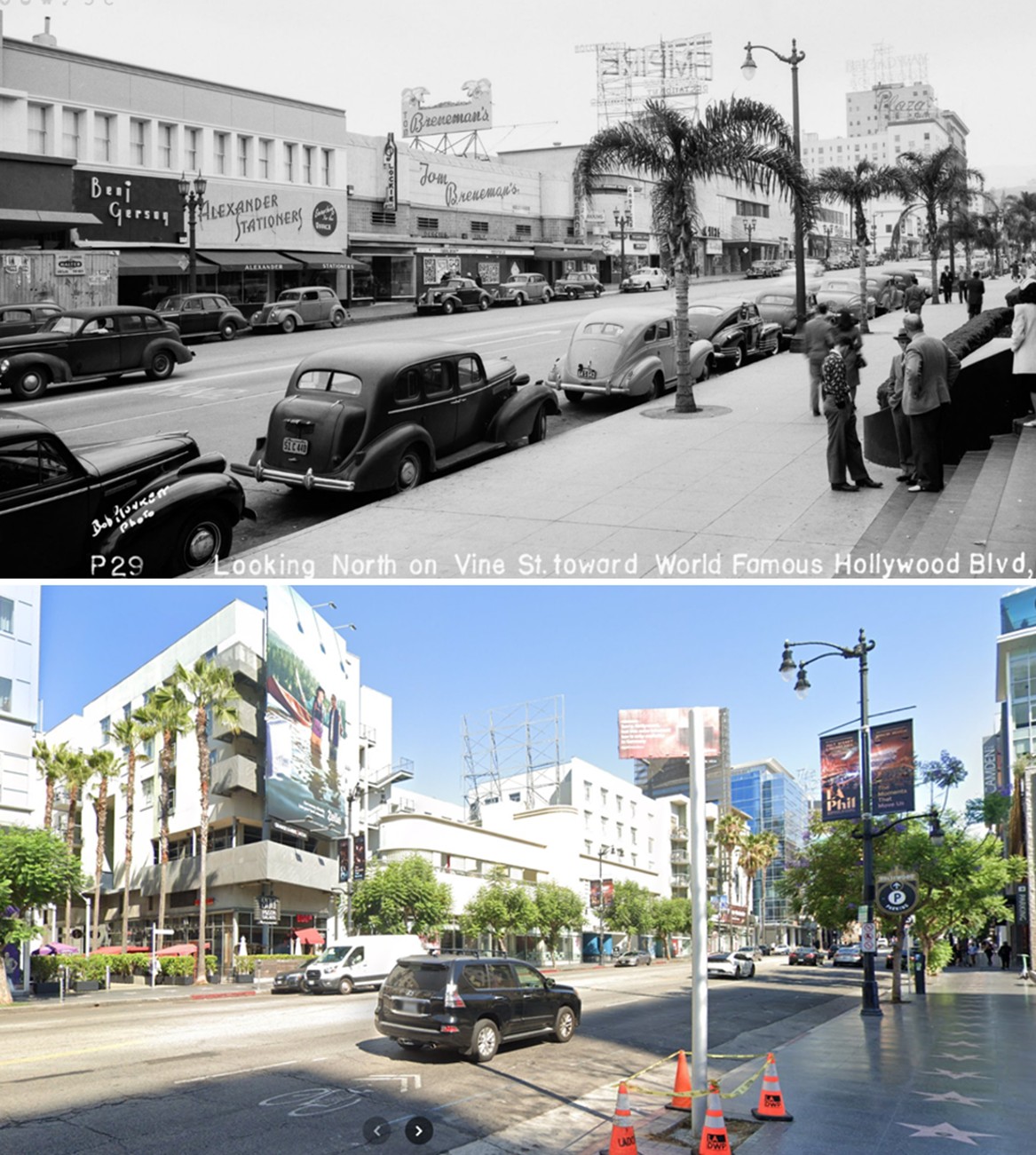 |
|
| (1947 vs. 2024)* – Looking north on Vine Street from in front of NBC Radio City, which once stood at the northeast corner of Sunset and Vine—now the site of Home Savings & Loan and its parking lot, just to the right of the contemporary image. Photo comparison by Jack Feldman. |
* * * * * |
Semaphore Traffic Signals
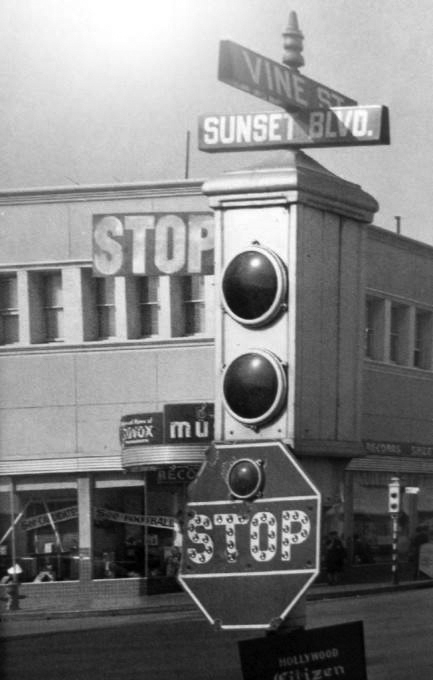 |
|
|
| (1942)* – View showing a STOP/GO Semaphore traffic signal at the corner of Sunset and Vine in the heart of Hollywood, with what looks like a half-chewed stop sign at the bottom, and a glimpse of Wallichs Music City in the background. |
Historical Notes Los Angeles installed its first automated traffic signals in the 1920s. These early signals, manufactured by the Acme Traffic Signal Co., paired "Stop" and "Go" semaphore arms with small red and green lights. Bells played the role of today's amber or yellow lights, ringing when the flags changed—a process that took five seconds. |
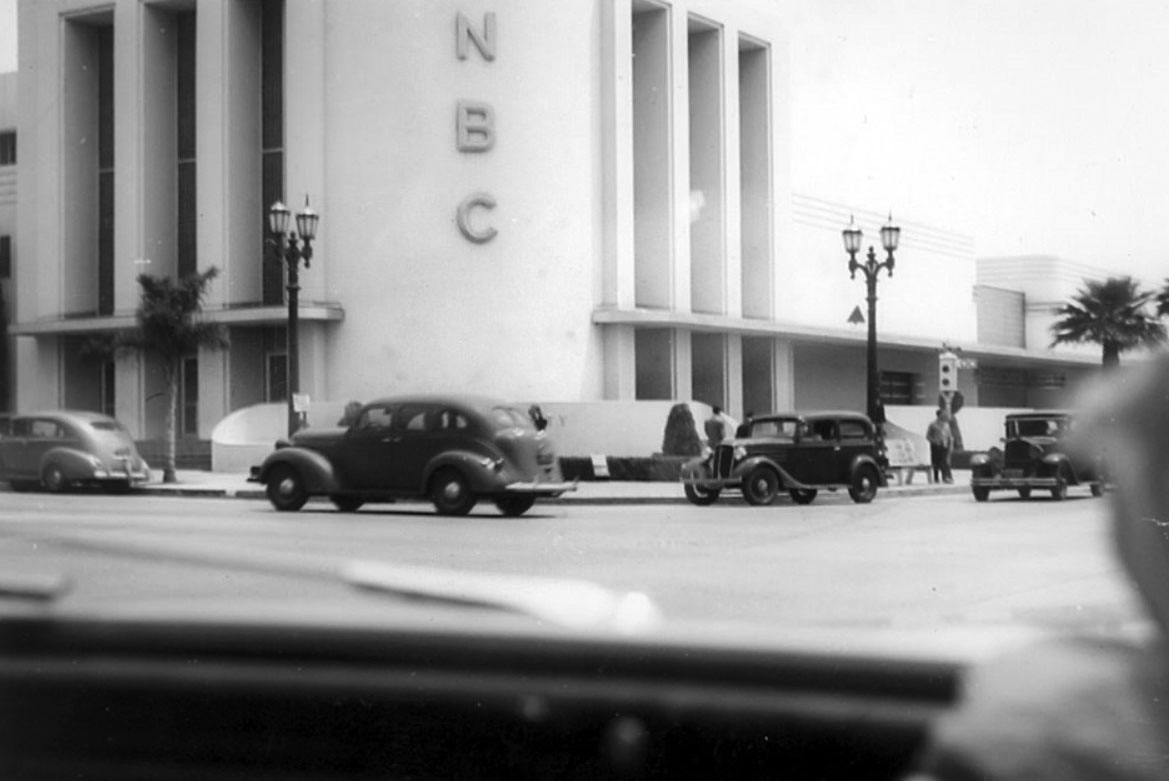 |
|
| (1942)* - Looking northeast across the intersection of Sunset Boulevard and Vine Street with a 1937 Plymouth crossing the intersection and the NBC Studio in the background. |
 |
|
| (1940s)* - View looking north on Vine Street at Sunset Blvd showing the NBC studio complex located at the northeast corner. In the background can be seen: The Hollywood Recreation Center Bowling Alley, Broadway-Hollywood, Hollywood Plaza Hotel, and the Taft Building can be seen in the background. |
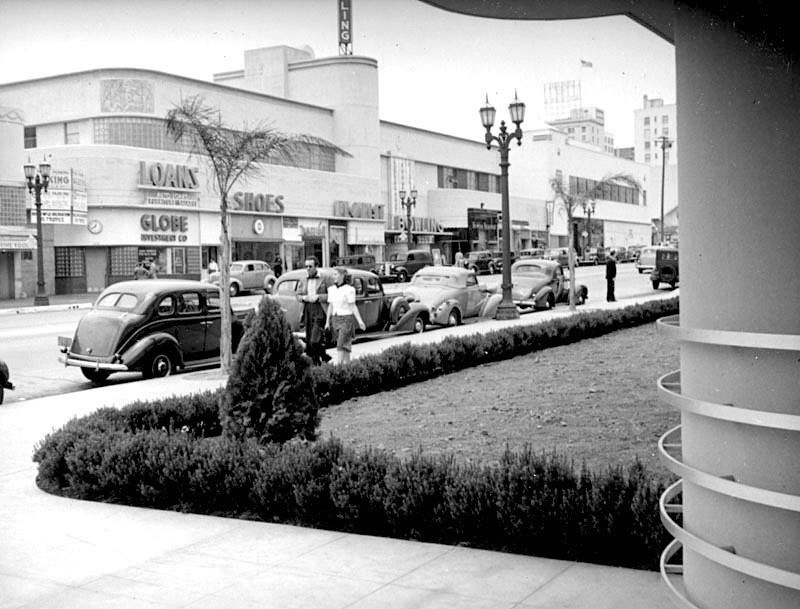 |
|
| (1940s)* – View looking northwest on Vine Street from the front entrance to NBC radio studios. Some of the businesses seen along the west side of Vine include: the Tropics restaurant, the Globe Investment Company (1529 Vine), the Health Spot Shoe Shop (1531 Vine), the Travelknit Shop (1533 Vine), Ambassador Florists (1535 Vine) and the Hollywood Recreation Center Bowling Alley (1539 Vine). |
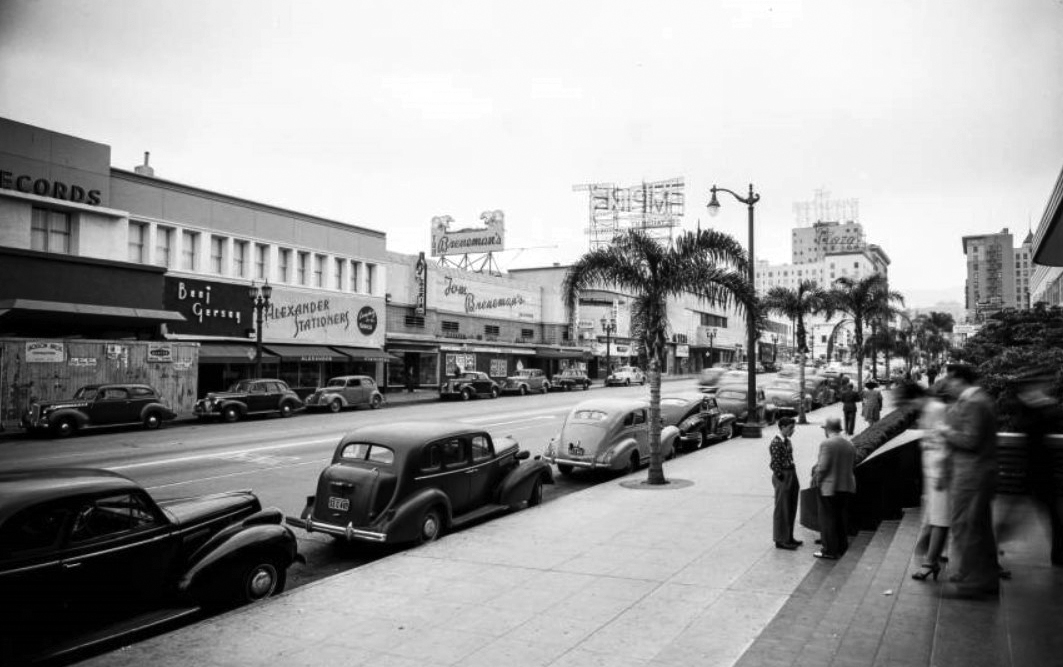 |
|
| (1947)* – View looking toward Hollywood Boulevard showing the stores along the west side of Vine Street as seen from the front of the NBC studio complex. Business signs on Vine Street read Beni Gerson, Alexander Stationers, Tom Breneman's Restaurant (at 1539 North Vine Street), Hollywood Empire Restaurant, with the Plaza Hotel and the Broadway Building visible at the intersection of Hollywood and Vine. Note how the streetlights have changed (see prrevious photos). |
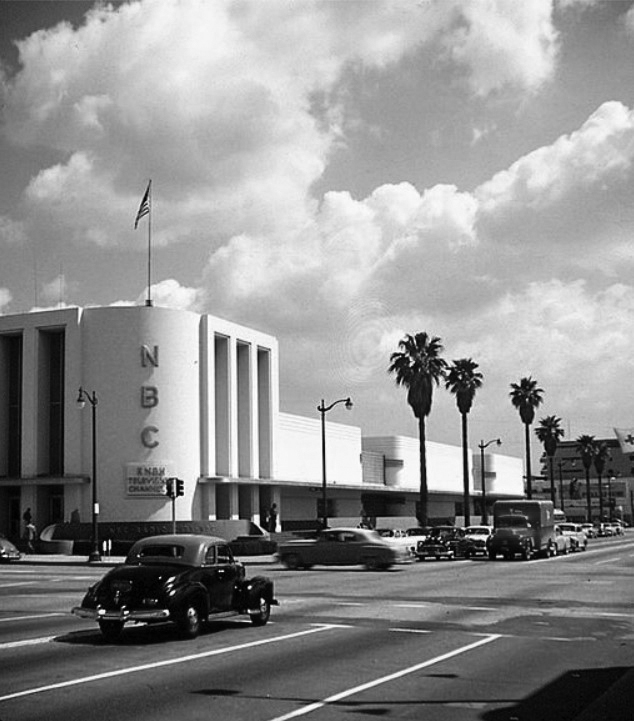 |
|
| (1949)* - View looking east on Sunset Boulevard at Vine Street showing the NBC radio studios on the southeast corner. |
 |
|
| (ca. 1950)* - NBC Studios at the corner of Sunset and Vine. Note the U.S. Air Force recruitment sign. Also, note the 'suicide doors' on the 1949 Studebaker on the left. |
Historical Notes The NBC studio complex stood until 1964 and then demolished to make room for a Home Savings and Loan bank (now Chase Bank). |
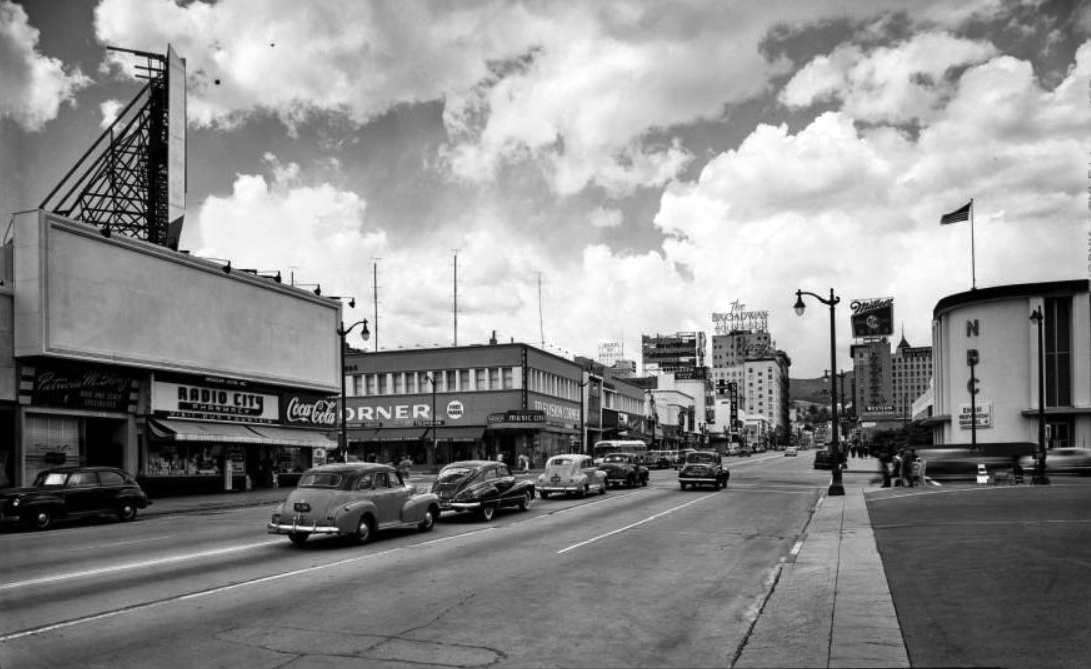 |
|
| (1949)* – View looking north on Vine Street toward Sunset Boulevard with the NBC Radio City studio for KNBH television channel 4 on the corner. Also visible are the Hollingsworth Taft Building, Broadway-Hollywood Building, Plaza Hotel, ABC Studio, and Music City television corner, and Radio City Pharmacy. Signs read "Miller High Life Beer" and "Coca-Cola." |
Historical Notes KNBH Television was launched by NBC in 1949 and the change of the call letters KNBH to KRCA in 1954. |
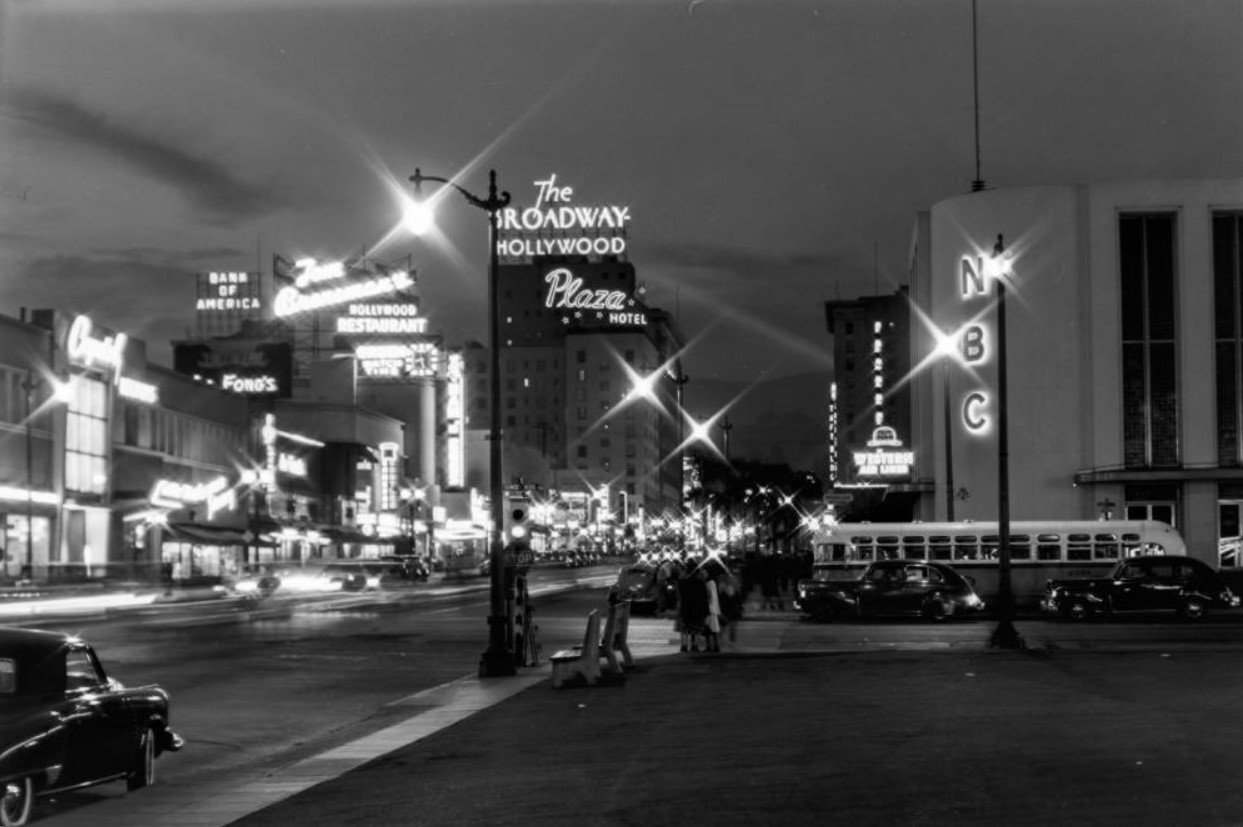 |
|
| (1948)* – Panoramic nighttime view looking north on Vine Street with the intersection of Sunset Boulevard in the foreground. Visible buildings include Radio City NBC Studio, Brown Derby, Western Air Lines, Capitol Records, Tom Breneman's Restaurant, the Broadway-Hollywood department store building, and Plaza Hotel. |
* * * * * |
Carpenter’s Drive-in Restaurant
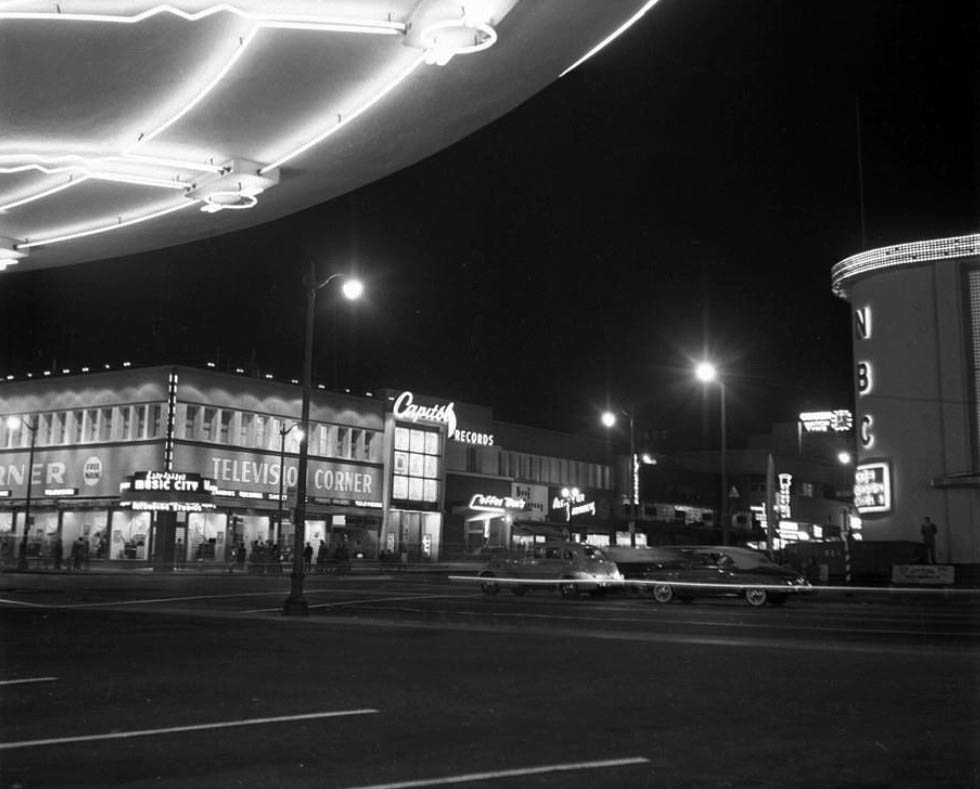 |
|
| (1940s)* – View looking northwest toward the intersection of Sunset and Vine from the front of Carpenter’s Drive-in Restaurant located on the S/E corner. NBC Radio City is across the street on the N/E corner and Wallich's Music City is on the N/W corner. |
Historical Notes Originally located near the northeast corner of Sunset and Vine (6265 Sunset Blvd), Carpenter’s would be torn down to make room for the new NBC Radio City building, constructed in 1938. Shortly thereafter, Carpenter’s was reincarnated across the street on the southeast corner of Sunset and Vine (6290 Sunset Blvd). |
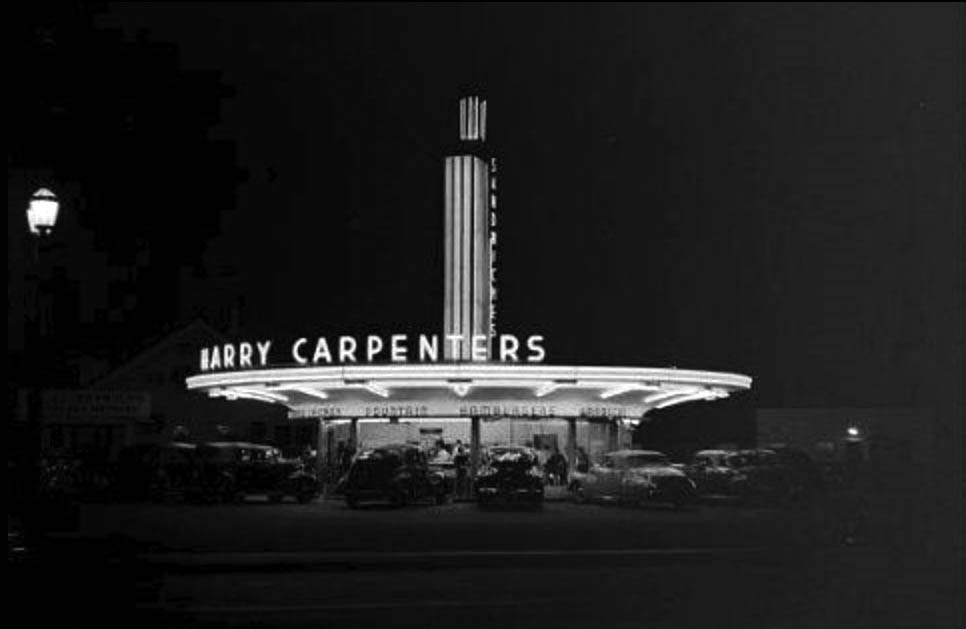 |
|
| (1940s)* – View showing cars parked at Harry Carpenter's Drive-in Restaurant on the southeast corner of Sunset and Vine, 6290 Sunset Boulevard. |
Historical Notes Harry B. Carpenter founded the Carpenter's chain with his brother Charles and operated many locations in Los Angeles including: Sunset and Vine, Wilshire and Western, Wilshire and La Cienega, Wilshire and Vine, Pico and Vermont, Silver Lake and Glendale and Sunset and Virgil. Click HERE to see more Early Views of LA Drive-in Restaurants. |
* * * * * |
Crossroads of the World
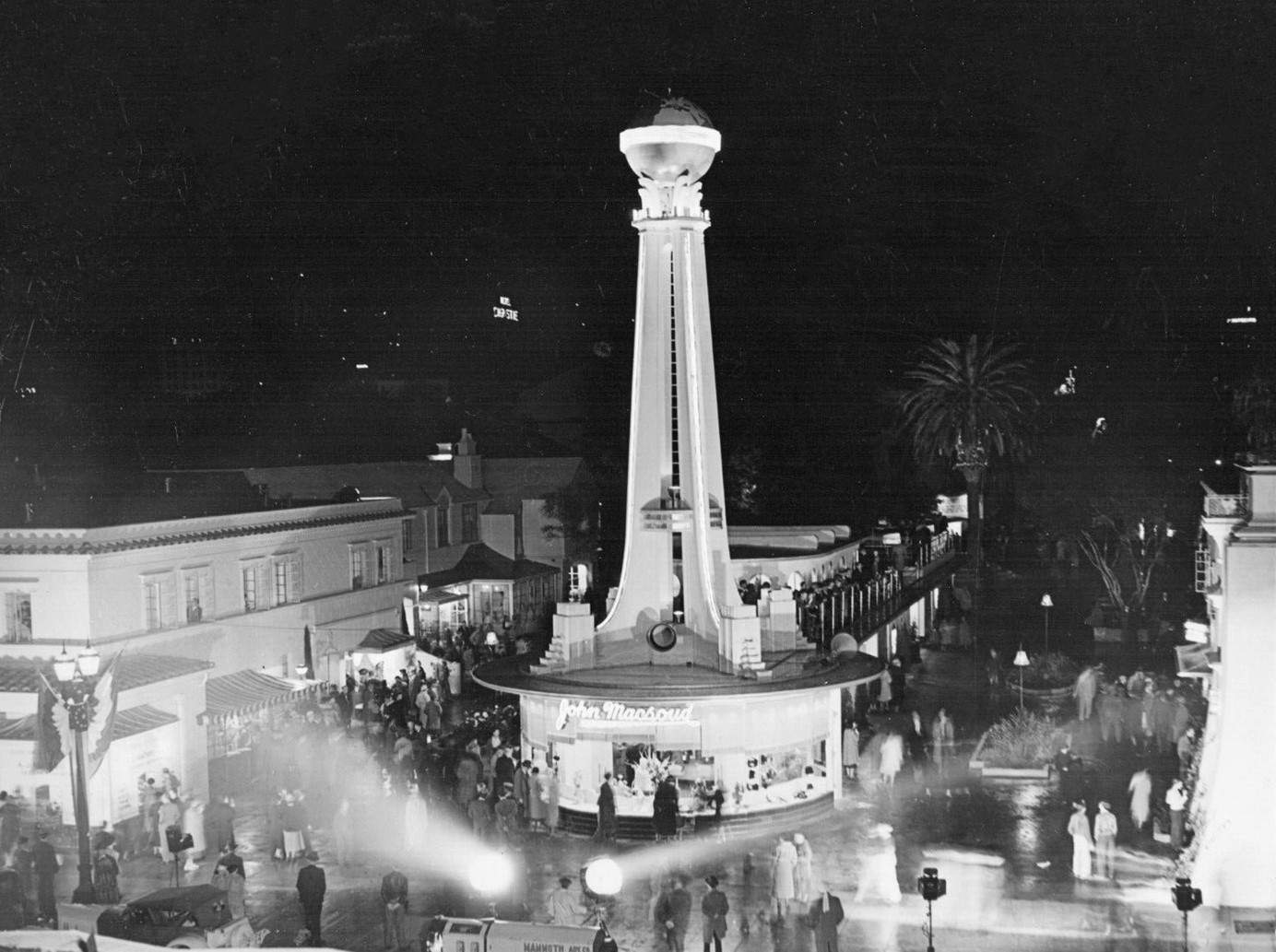 |
|
| (1936)* - Grand Opening of Crossroads of the World, the world’s first planned outdoor shopping mall located at 6671 Sunset Blvd. |
Historical Notes The Crossroads of the World was inaugurated on October 29, 1936. The new shopping center was not a full-blown success, but it became an excellent model for outdoors malls across the world. |
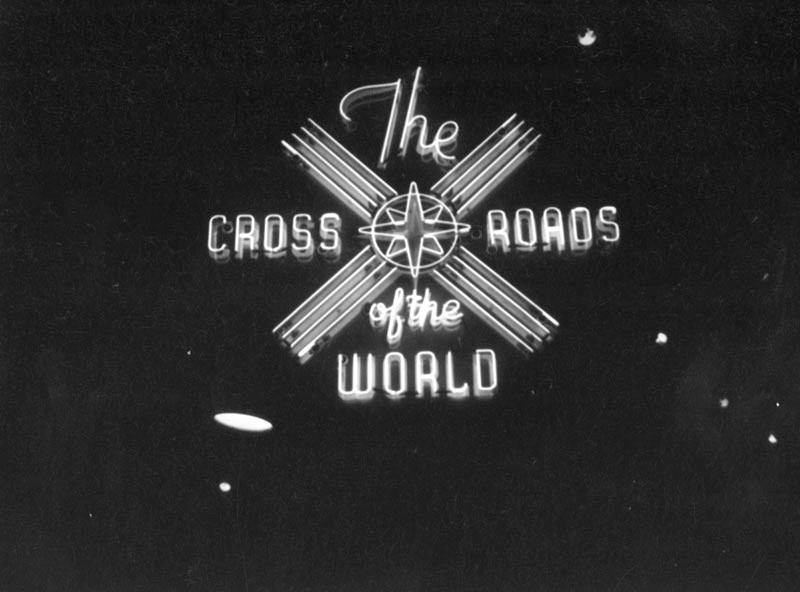 |
|
| (ca. 1937)* – View of the Cross Roads of the World neon sign located in front of the first outdoor mall in Hollywood. |
Historical Notes It has stood like a beacon on Sunset Boulevard at Las Palmas Avenue since 1936, welcoming visitors from all over the world. The massive 60-foot art deco tower with a blue and white globe turning slowly on its top, emblazoned with the words “Crossroads of the World,” is a well-known landmark to anyone traversing Hollywood. |
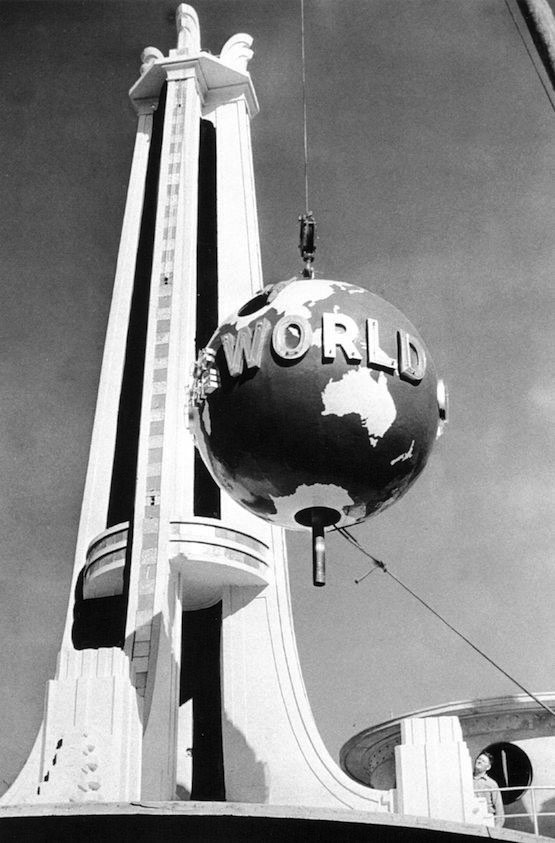 |
|
| (1936)* - World globe being hoisted into place on top of a tower at Crossroads of the Worlds. |
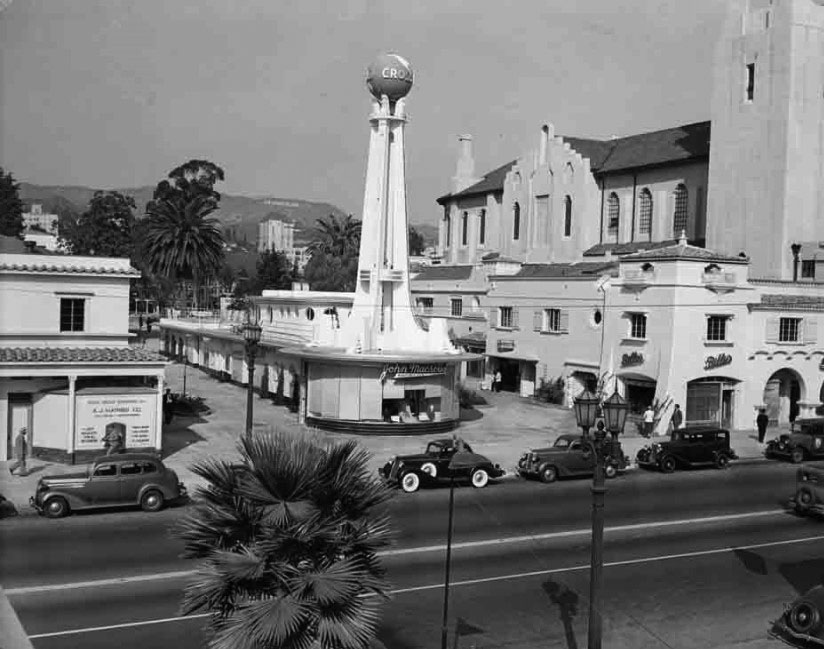 |
|
| (1936)* - Front view of Crossroads of the World, the world’s first planned outdoor shopping mall located at 6671 Sunset Blvd. |
Historical Notes Crossroads of the World has been called America's first outdoor shopping mall. Located on Sunset Boulevard and Las Palmas in Los Angeles, the mall features a central building designed to resemble an ocean liner surrounded by a small village of cottage-style bungalows. It was designed by Robert V. Derrah and built in 1936. |
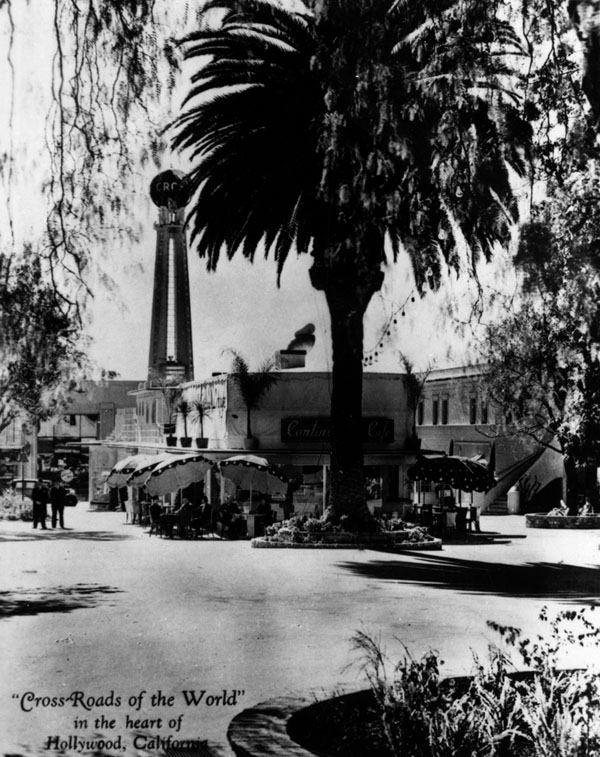 |
|
| (ca. 1939)* - Postcard view of Crossroads of the World in Hollywood. Shops at the other end of the building from the tower are in the Spanish Colonial, Tudor, and French Provincial architectural styles. |
Historical Notes Once a busy shopping center, the Crossroads now hosts private offices, primarily for the entertainment industry. It has been used for location shooting in many films, including L.A. Confidential and The Adventures of Ford Fairlane, in TV shows including Dragnet and Remington Steele, and in commercials by McDonald's, Ford and Mattel. A reproduction of Crossroads' iconic tower and spinning globe can be seen just inside the entrance to Disney's Hollywood Studios at Walt Disney World in Florida. |
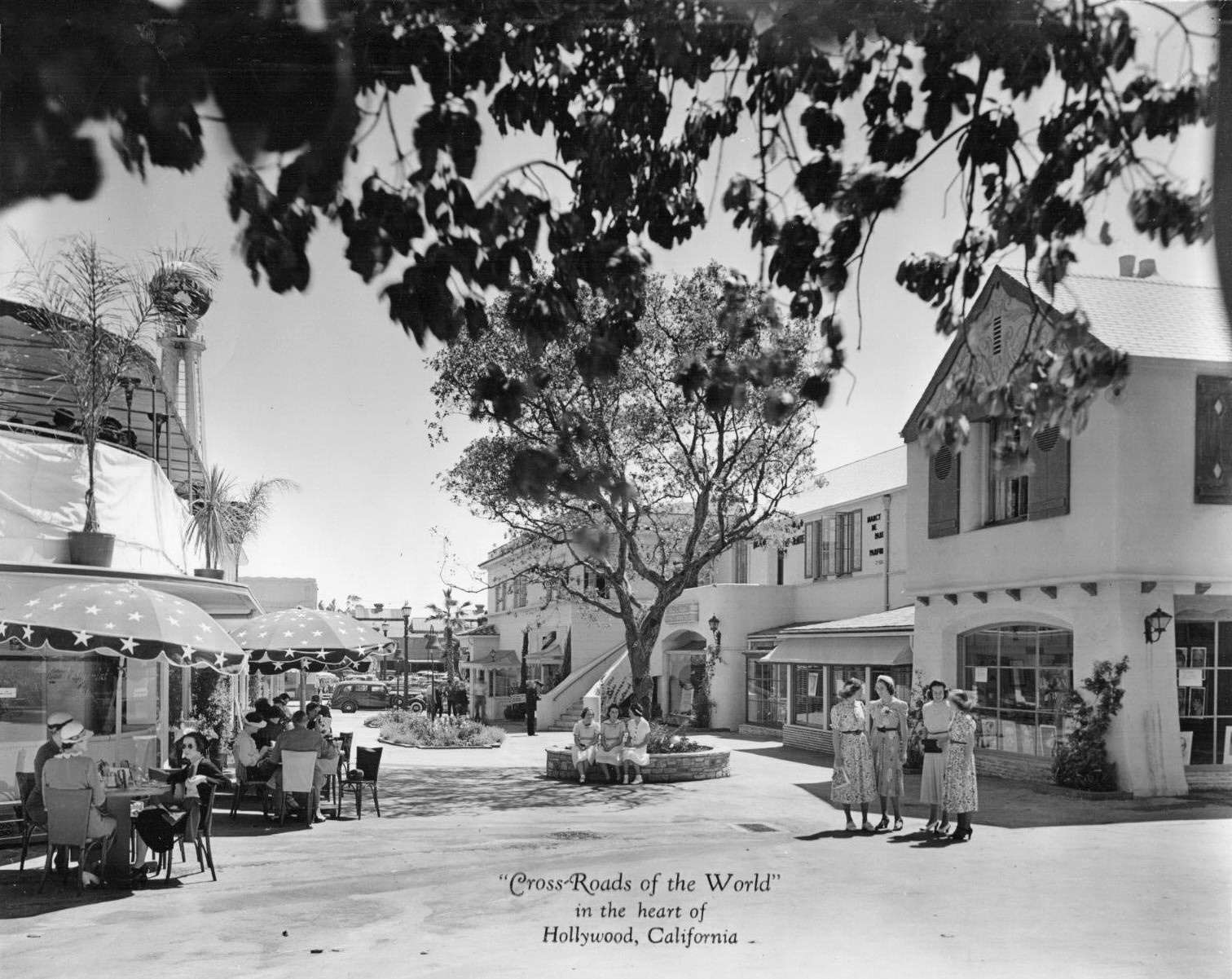 |
|
| (ca. 1939)* - Crossroads of the World, where you could shop and dine all in the same place. |
Historical Notes The complex originally held 57 shops and cafes, and 36 offices on the upper floors. |
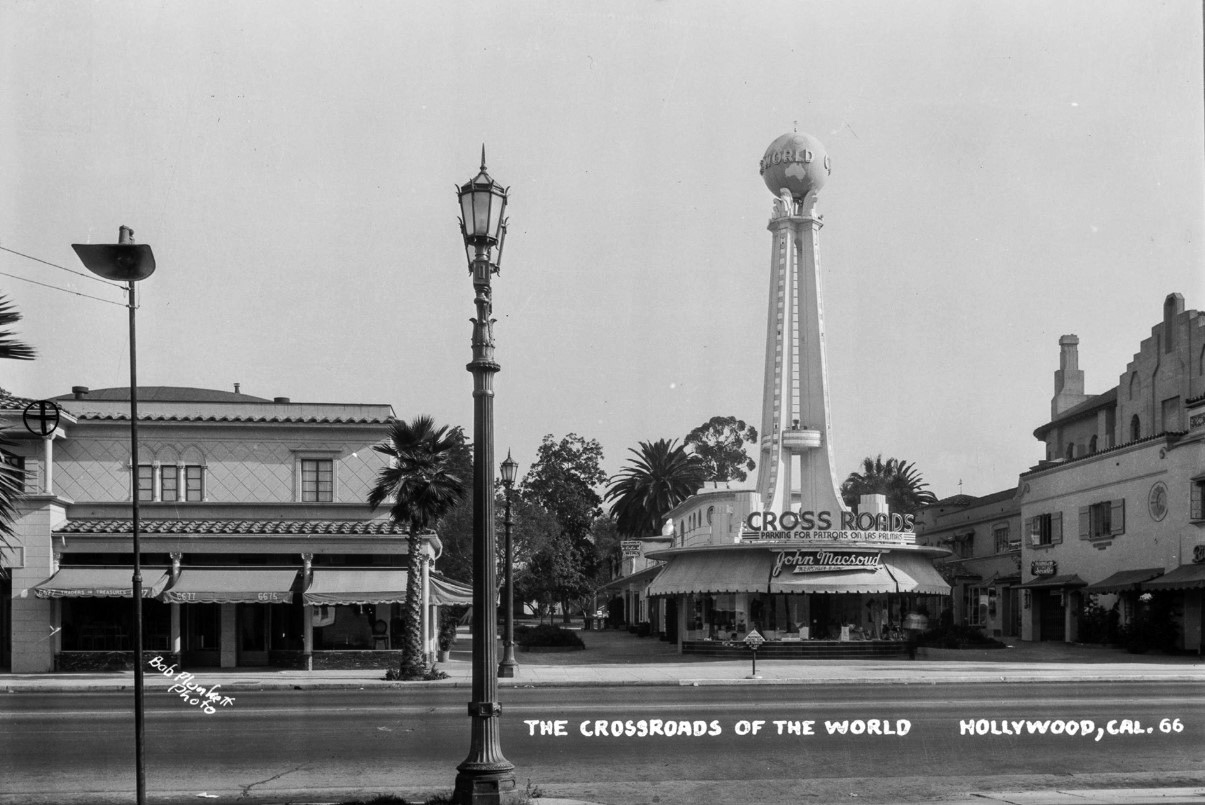 |
|
| (1936)* - Postcard view looking north across Sunset Boulevard showing Crossroads of the World. Photo Bob Plunkett |
Historical Notes Designed by local architect Robert V. Derrah, Crossroads of the World is one of Los Angeles' most recognizable properties. The Hollywood complex was completed in 1936 and conceived as a cosmopolitan shopping center featuring merchandize from around the globe. Oriented around a centralized Streamline Moderne structure, Crossroads of the World was envisioned as a hub of pedestrian activity. The complex features a programmatic nautical theme, paired with architectural styles found around the world. In addition to Crossroads, Derrah was responsible for a number of significant commissions in Los Angeles during the 1930s. Many of his buildings were designed in the Streamline Moderne style, including the Coca-Cola Building (1939). He also designed an addition to John and Donald Parkinson's Southern California Gas Company Complex (1942) and contributed to the Fairfax Farmers Market (1934). In the 1940s and '50s, Crossroads began its transition from shopping center to office complex, housing such tenants as the Screen Actors Guild, Standard Oil, and American Airlines. (Los Angeles Conservancy) |
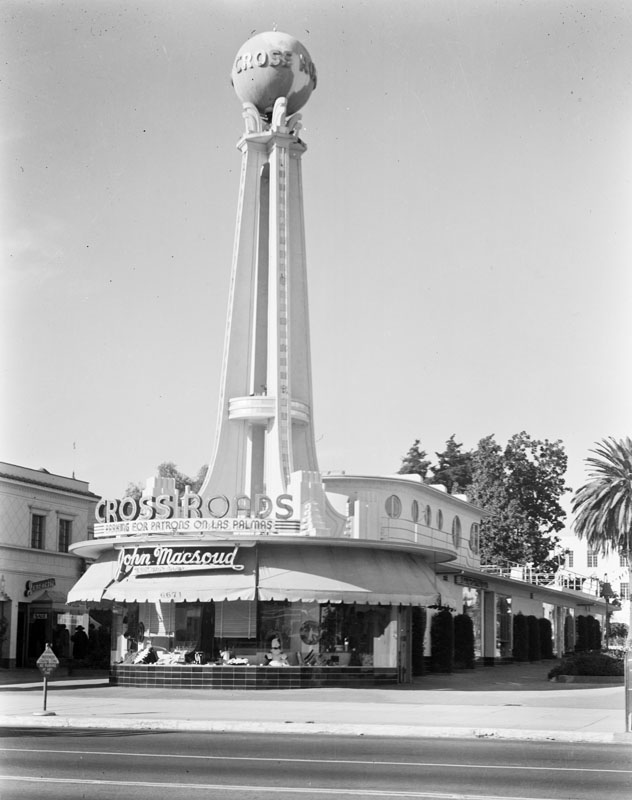 |
|
| (1939)* - Entrance to the Crossroads of the World shopping center designed to look like a Streamline Moderne ship. It has a tall, open tower that is topped with a lighted globe. In the foreground is the John Macsoud shop, located at 6671 Sunset Boulevard in Hollywood. |
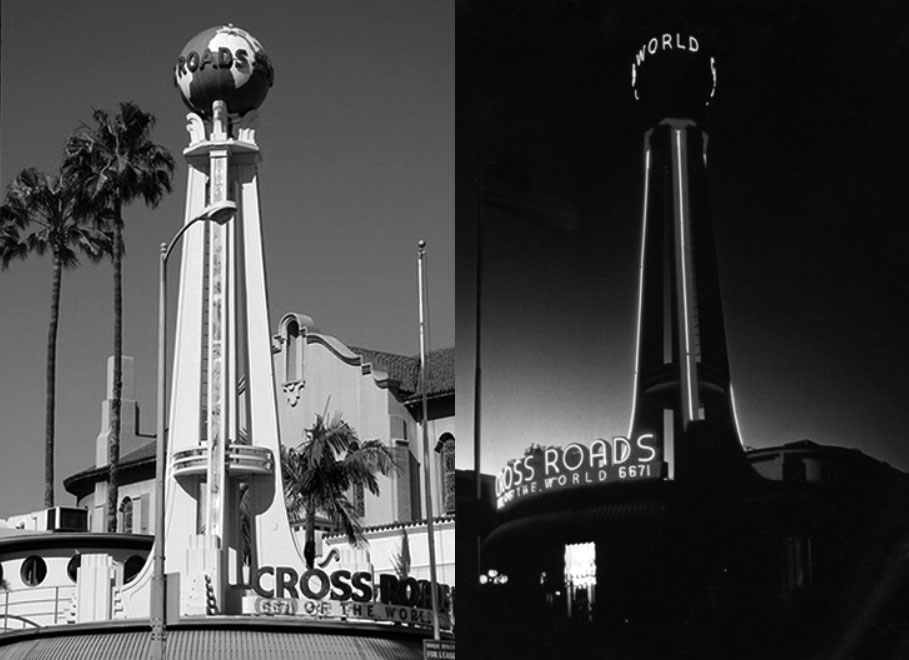 |
|
| (n.d.)* - Day & Night view of the Cross Roads globe tower. |
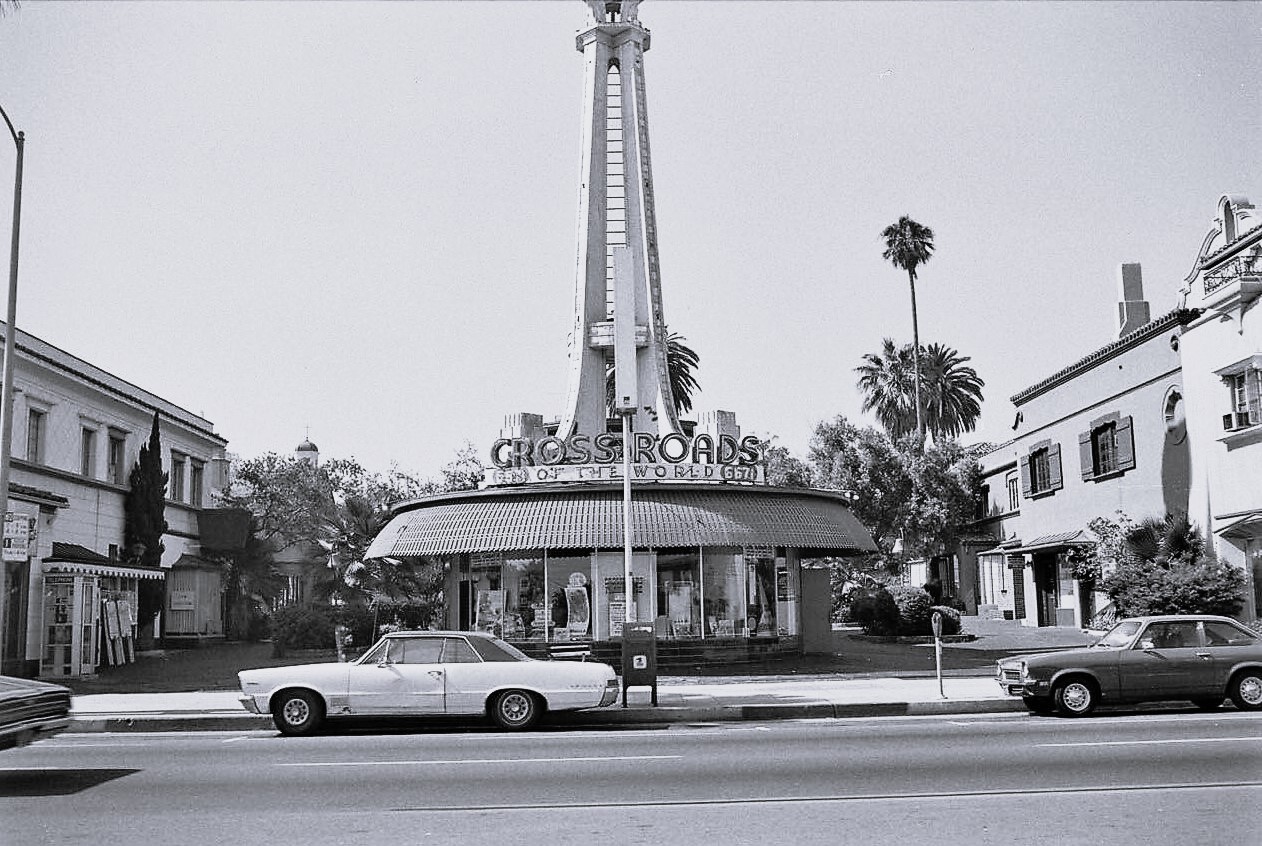 |
|
| (1973)* - Crossroads of the World at 6671 Sunset Boulevard. Source: Getty Images/Photo by Ed Ruscha. |
Historical Notes The property was purchased in 1977 by the real estate investor Mort La Kretz and restored. On June 1, 1985, Michael Perricone founded Interlock Studios, an audio post production facility, which was located in Bungalow 1522 of the complex, until 1998, when it relocated to 6520 Sunset Boulevard, and was sold to Rick Larson a few years later, who renamed it Larson Studios. |
 |
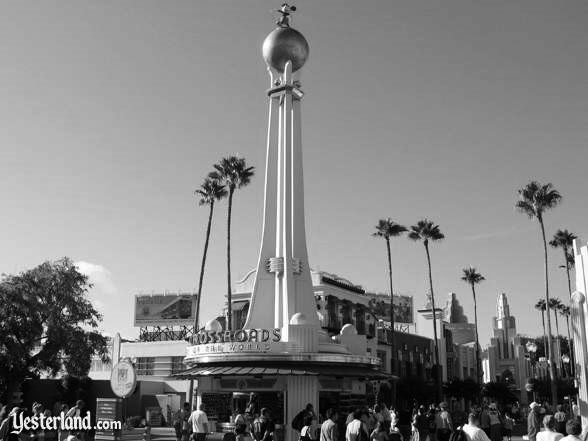 |
|
| (2004)* - View showing Crossroads of the World located at 6671 Sunset Boulevard in Hollywood, now a buisness office complex. | (2008)* - View showing the entrance to Crossroads of the World at Disney’s Hollywood Studios near Orlando. Note the eye-catching tower is topped by Mickey Mouse |
Historical Notes The Crossroads can be seen in the 2012 movie Argo when Tony Mendez (Ben Affleck) and Lester Siegel (Alan Arkin) go to an office there to buy the script for the movie Argo. In 1974, Crossroads of the World was dedicated Los Angeles Historic-Cultural Monument No. 134 (Click HERE to see complete listing). Today, the real Crossroads is the creative home of a variety of music publishers and producers, television and film script writers, film and recording companies, novelists, costume designers, publicists and casting agencies. In January 2019, the Los Angeles City Council approved a project to revamp the Crossroads of the World in a move to revitalize the district. Three high-rise buildings are planned to bring 950 apartments and condos, a 308-room hotel, and 190,000 square feet of commercial space. Preservationists called the redevelopment project a "Manhattanization of Hollywood". Eighty-two Hollywood Regency garden apartments are to be demolished in the project.These rent stabilized apartments are occupied by a decades-old, tight-knit community of largely low-income, predominantly Latino residents. Over 100 apartments in the project will be set aside for very low-income families. |
* * * * * |
Max Factor Building
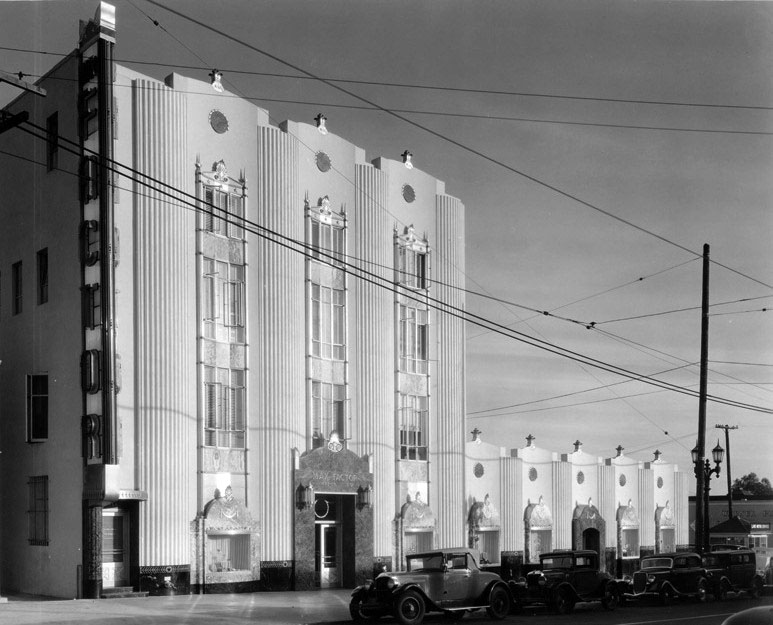 |
|
| (1930s) - Exterior view of the Max Factor Building, the "Jewel Box of the Cosmetic World", located at 1666 North Highland Avenue, in Hollywood. |
Historical Notes Max Factor & Company was founded during 1909 by Maksymilian Faktorowicz, Max Factor, a Polish-Jewish cosmetician from Poland. After immigrating to the United States in 1904 Max Factor moved his family and business to Los Angeles, seeing an opportunity to provide made-to-order wigs and theatrical make-up to the growing film industry. Besides selling his own make-up products he soon became the West Coast distributor of both Leichner and Minor, two leading theatrical make-up manufacturers. In 1928 Max Factor purchased the four-story Max Factor Building, formerly the Hollywood Fire Safe Building, known as the Jewel Box of the Cosmetic World and began manufacturing his world-famous make up on the upper floors while transforming the ground floor into a grand salon where fashionable women and celebrities came to see and be seen, as well as to purchase his make-up. |
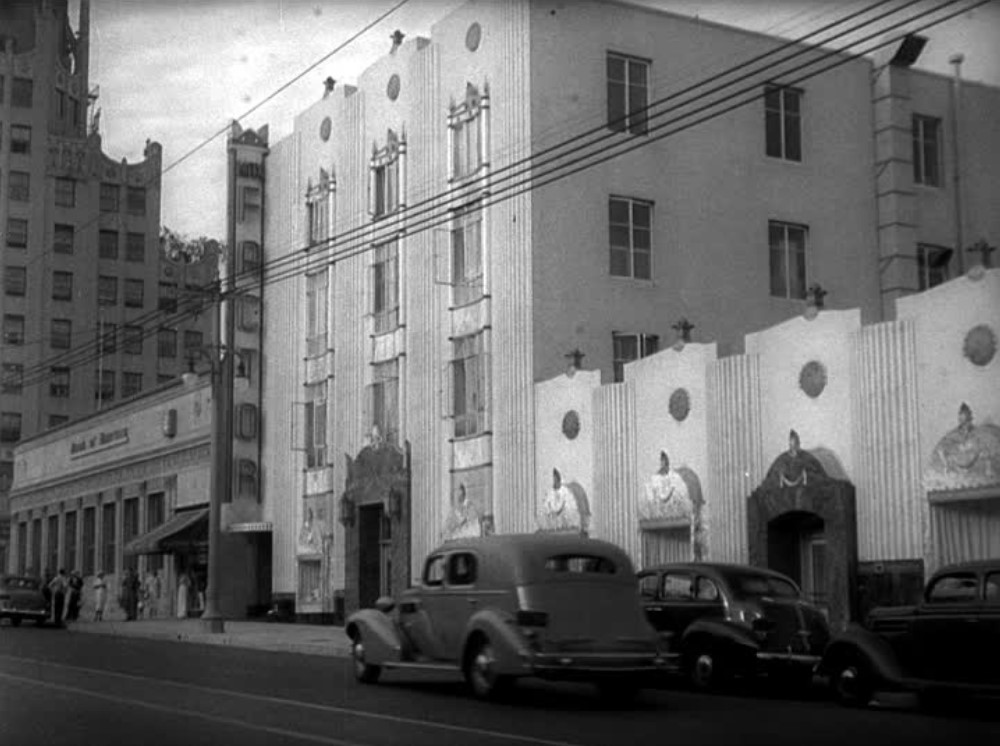 |
|
| (ca. 1938) – View showing the Max Factor Buildings on the west side of Highland. Hollywood First National Bank can be seen on the northeast corner of Hollywood and Highland. |
Historical Notes Famed architect S. Charles Lee designed the building in the so-called Hollywood regency art deco style. Lee was celebrated for his design of many of the grand motion picture theaters in Los Angeles as well as hotels and other signature buildings in the city and elsewhere in California and in Hollywood. |
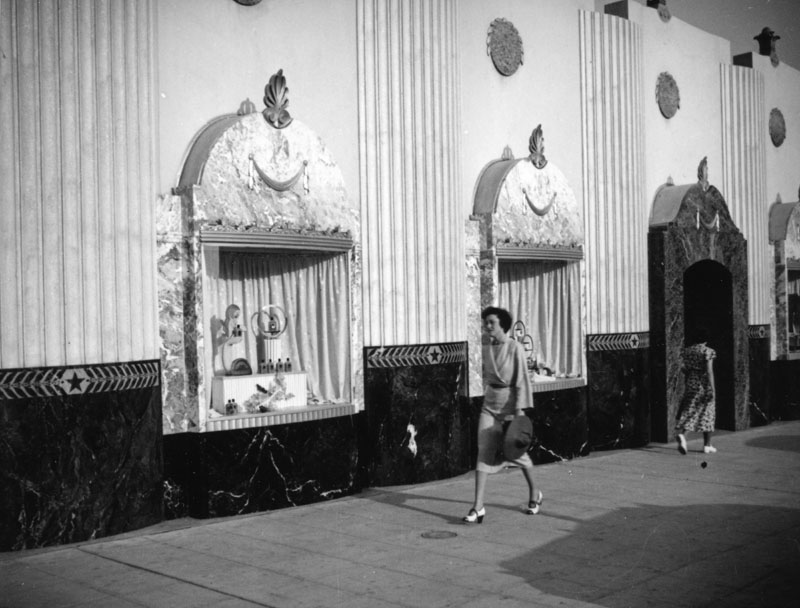 |
|
| (ca. 1939) - Two women are seen walking in front of the Max Factor Make Up Studio located on Highland Avenue just south of Hollywood Boulevard. |
Historical Notes In 1935, Max Factor opened the Max Factor Make Up Studio adjacent to his main four-story building. It was fondly nicknamed The Pink Powder Puff. |
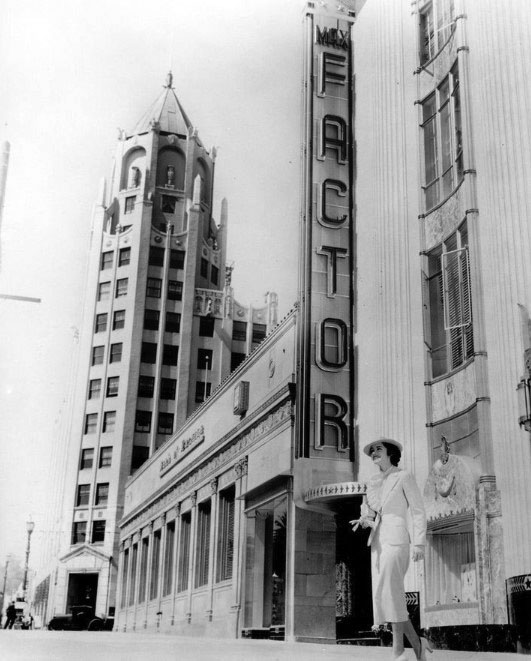 |
|
| (1930s) – View of a fashionably dressed woman walking in front of the Max Factor Building on the east side of Highland Avenue. The Hollywood First National Bank stands tall in the background on the northeast corner of Highland Avenue and Hollywood Boulevard. |
Historical Notes By 1914 Max Factor had perfected the first cosmetic specifically created for motion picture use — a thinner greasepaint in cream form, packaged in a jar, and created in 12 precisely-graduated shades. Unlike theatrical cosmetics, it would not crack or cake. It was worn for the first time by actor Henry B. Walthall, who served as the model for screen tests. In 1925 the company received its biggest order to date when it had to complete a rush order to supply 600 gallons of light olive makeup to the set of the movie "Ben-Hur" to ensure that the skin color of the extras used in filming undertaken in America would match that of the darker skinned Italian extras in the scenes filmed in Italy. |
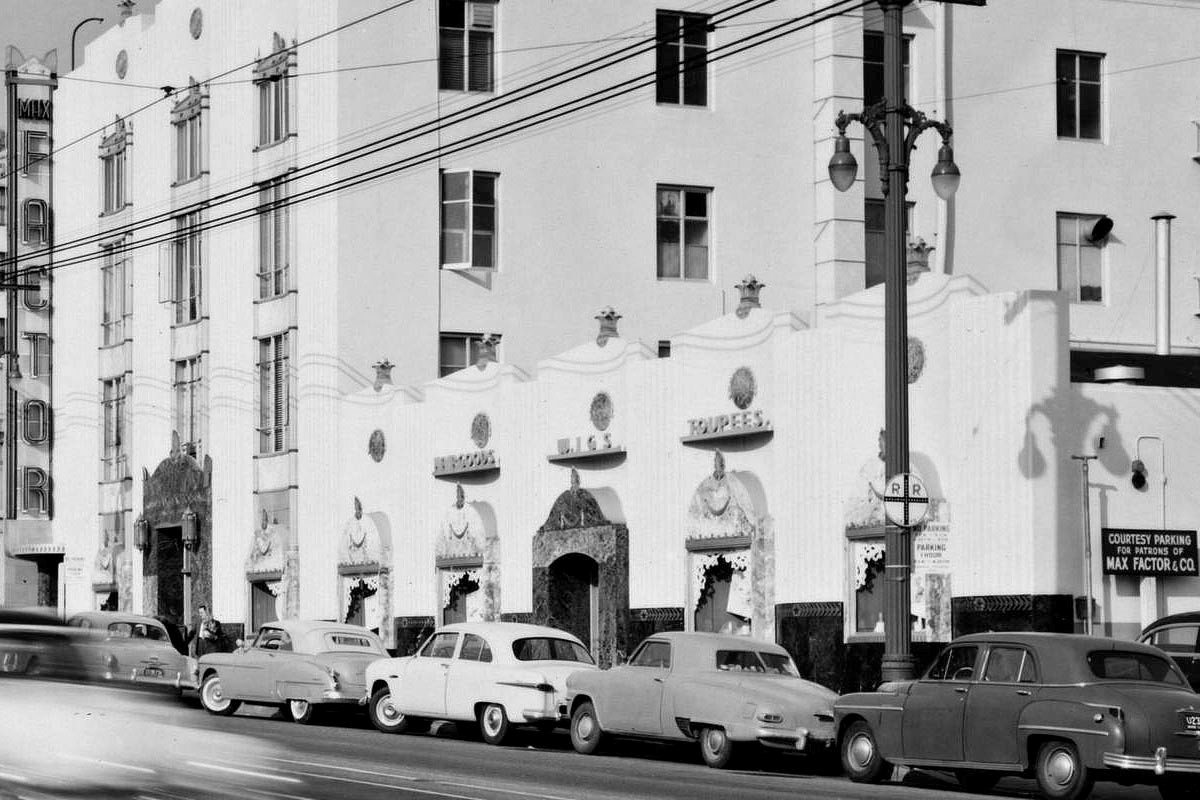 |
|
| (ca. 1950)* – View showing the Max Factor Building with signs in front reading: HAIRDRESS – WIGS - TOUPEES |
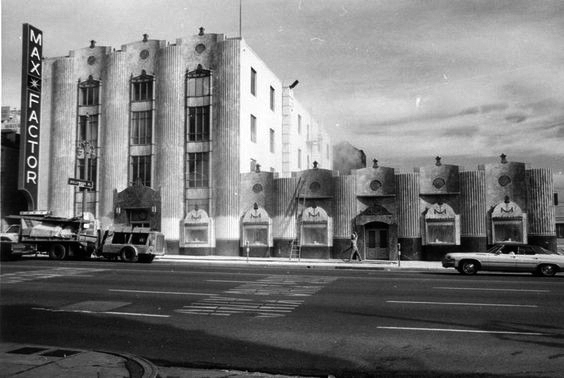 |
|
| (1975)* - View looking east across Highland Avenue showing the Max Factor Builidng. |
Historical Notes Today, the four-story Max Factor Building can be found at Universal Studios Orlando, while the one-story part has a counterpart at Disney’s Hollywood Studios. In the real Hollywood, the four-story part of the Max Factor Building is now Hollywood Museum, and the one-story part is now Mel’s Drive-In, a retro diner. Click HERE for contemporary view. |
 |
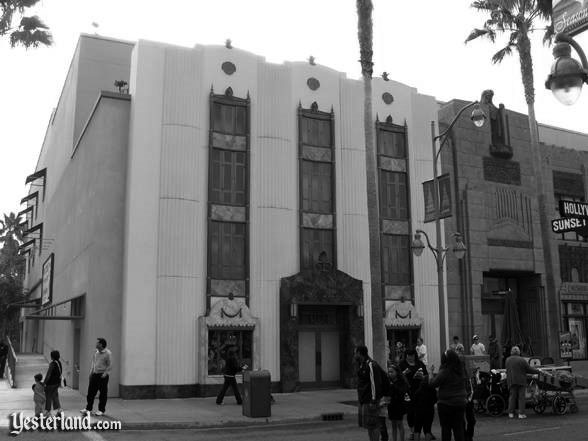 |
|
| (ca. 1930s) - View showing the Max Factor Building, the "Jewel Box of the Cosmetic World", located at 1666 North Highland Avenue, in Hollywood. | (2008)* - View showing a version of the four-story Max Factor Building found at Universal Studios Orlando. |
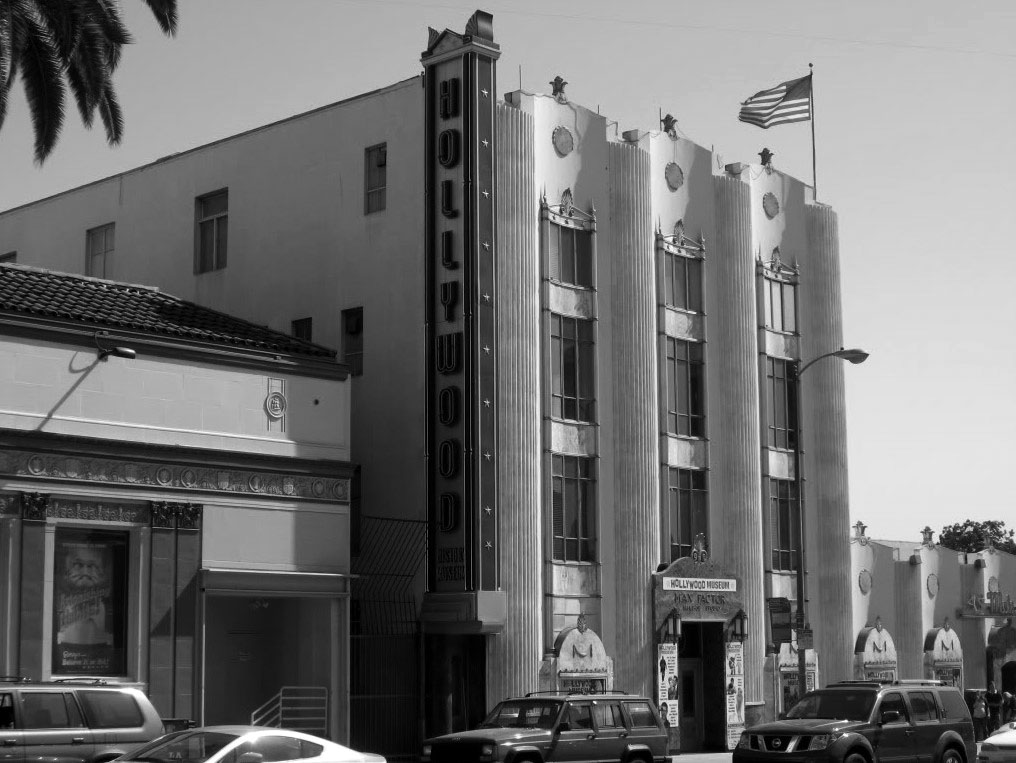 |
|
| (2010) - View of the landmark Max Factor Building, currently The Hollywood History Musum, located at 1666 N. Highland Avenue. |
Historical Notes Declared L.A. Historic Cultural Monument No. 593 on April 26, 1994, this building eventually became The Max Factor Museum of Beauty. It closed its doors in 1996 but reopened in 2002 as The Hollywood History Museum. It is located at 1666 N. Highland Ave. just one half-block south of Hollywood Boulevard. Click HERE to see complete listing of L.A. Historic Cultural Monuments. |
* * * * * |
Hollywood and Sycamore
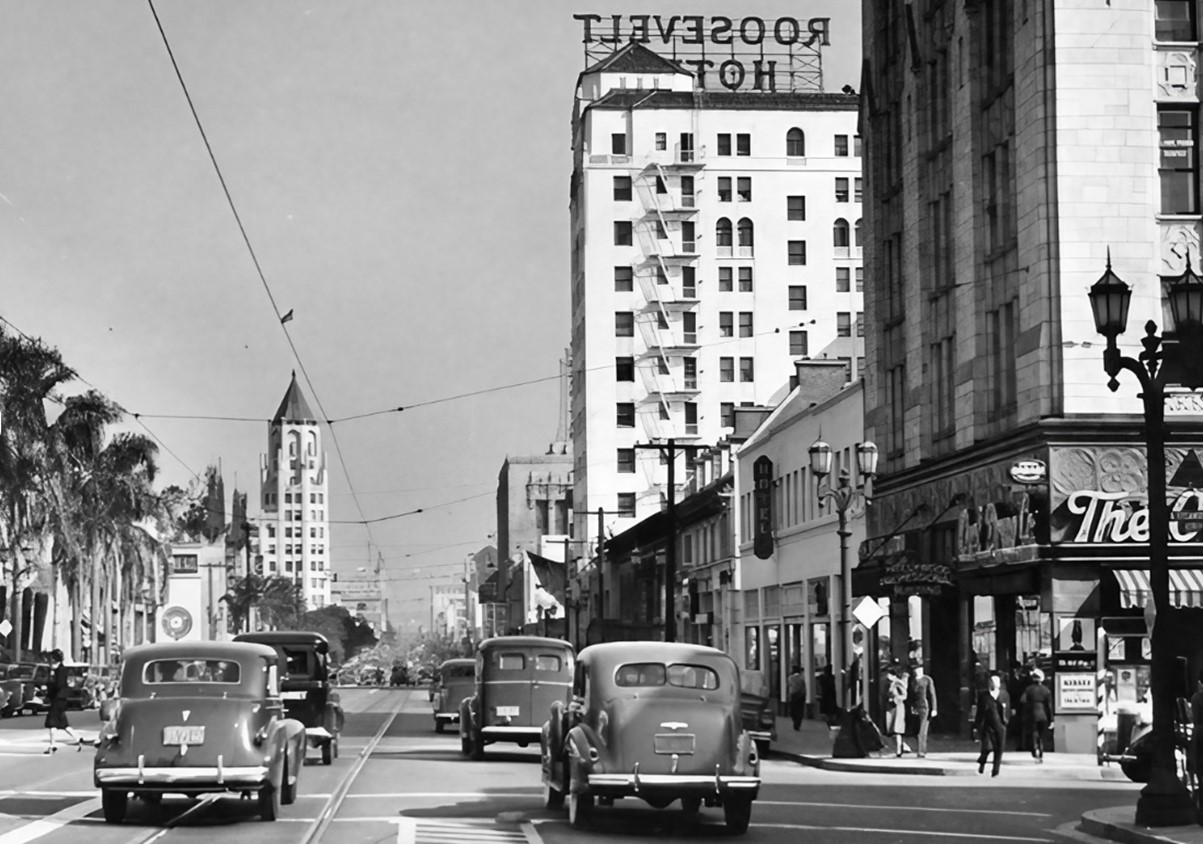 |
|
| (ca. 1937)* – Looking east along Hollywood Boulevard at Sycamore Avenue, with several iconic buildings in view. From left to right: the First National Bank Building (northeast corner of Hollywood and Highland), the Roosevelt Hotel (center), and the Hollywood Professional Building (right). |
Historical Notes The Hollywood Professional Building is where the Screen Actors Guild was located (8th floor). It's still there today. |
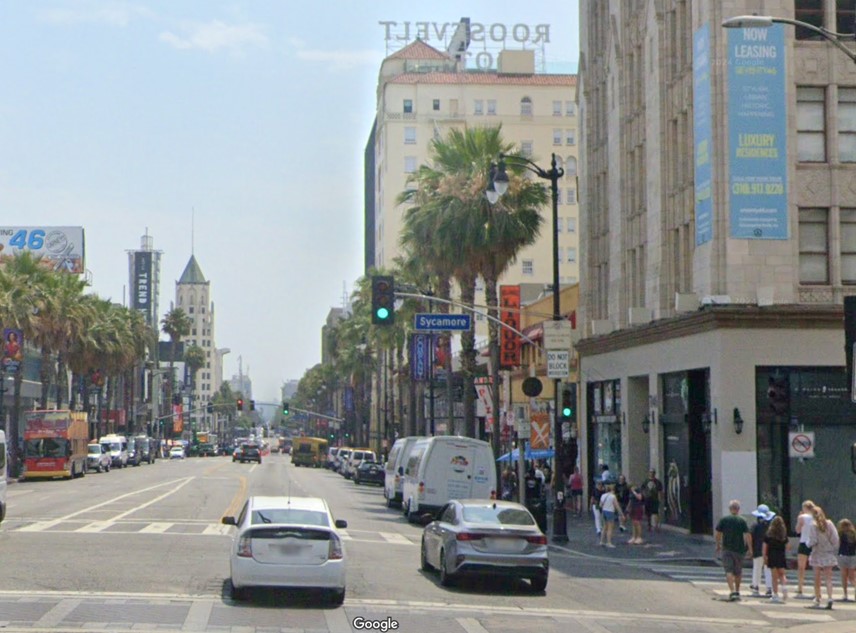 |
|
| (2024)* - Contemporary view looking east on Hollywood Boulevard from Sycamore Avene. |
Now and Then
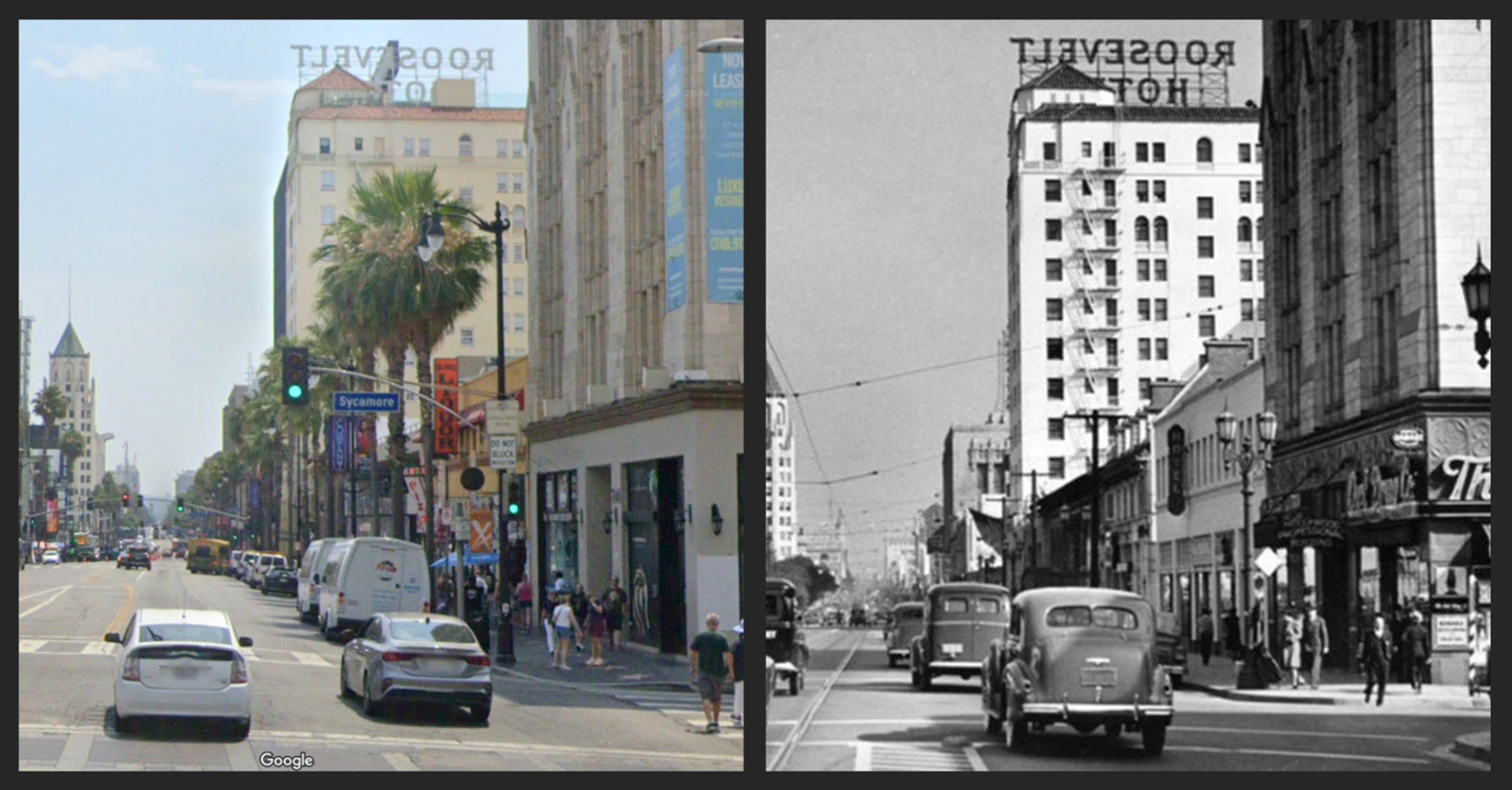 |
|
| (2024 vs 1937)*- Looking east on Hollywood Boulevard from Sycamore Avenue. |
* * * * * |
Hollywood Professional Building
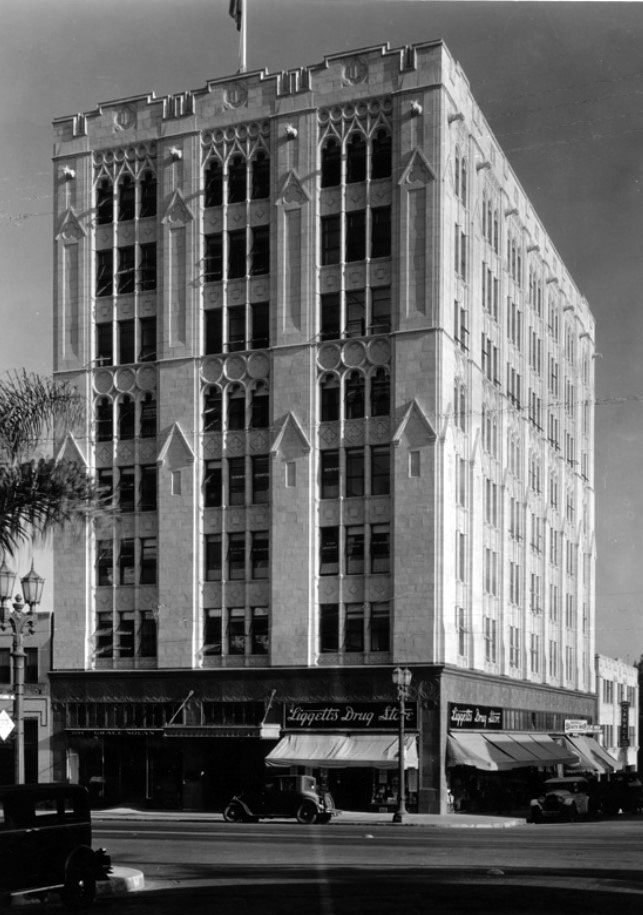 |
|
| (ca. 1925)^ – View looking at the southeast corner of Hollywood Blvd at Sycamore Ave showing the Owl Drug Co. store on the ground floor of the Hollywood Professional Building. |
Historical Notes Completed in 1925, the Gothic Revival-style Hollywood Professional Building was designed by Architect Richard D. King. For years it housed the headquarters of the Academy of Motion Pictures Arts and Sciences, and later the Screen Actors Guild. Ronald Reagan had an office in the building during his tenure as president of the Screen Actors Guild between 1947-1953. Louis Kroh Liggett was an American drug store magnate who founded L.K. Liggett Drug Company and then Rexall. He was later chairman of United Drug Company. |
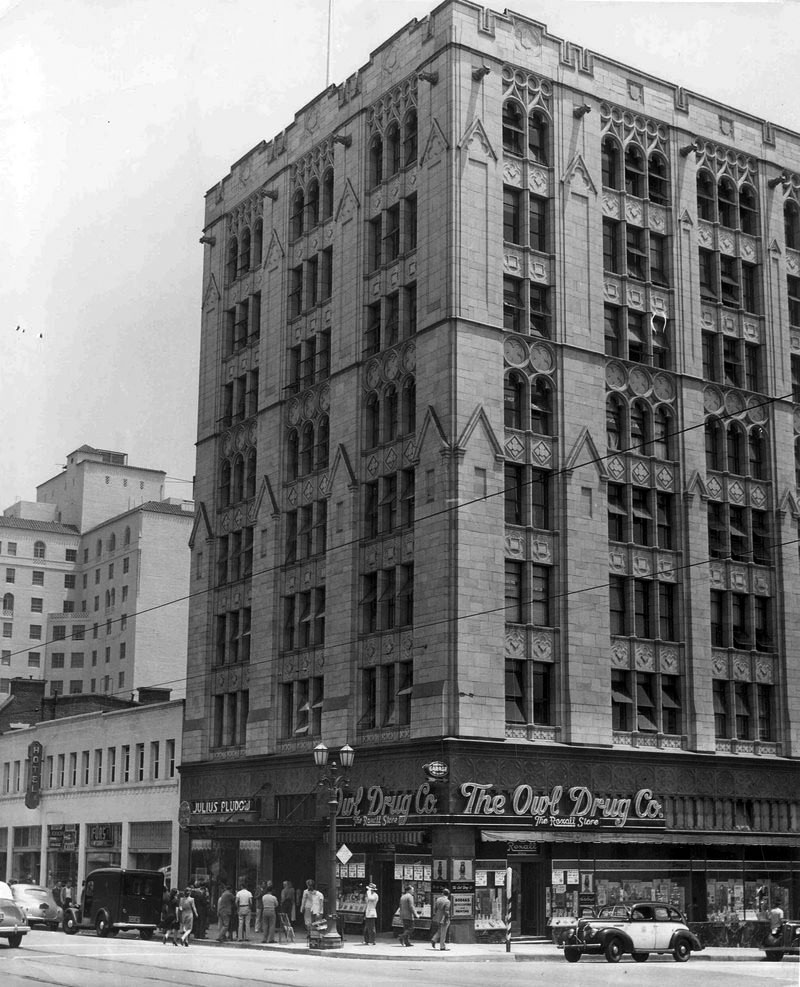 |
|
| (1941)* – View showing the Hollywood Professional Building on the SE corner of Hollywood and Sycamore. The drug store on ground floor is now The Owl Drug Co. |
Historical Notes In 2007 the Hollywood Professional Building was dedicated LA Historical Cultural Monument No. 876.Click HERE for contemporary view. |
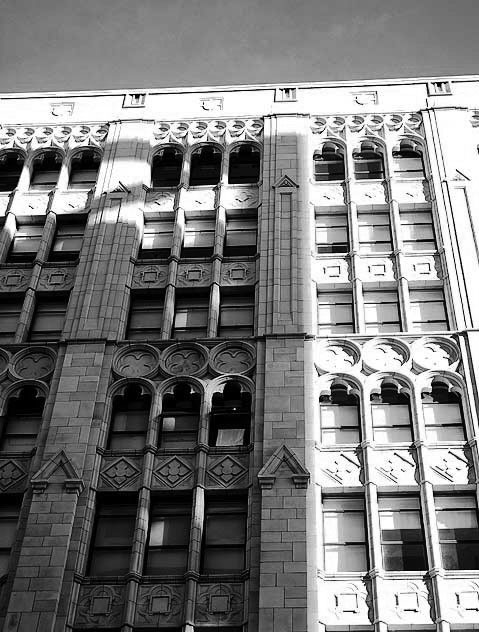 |
|
| (2008)^ – Close-up view showing design details on the face of the Gothic Revival Hollywood Professional Building. |
* * * * * |
The Owl Drug Co. (The Rexall Store)
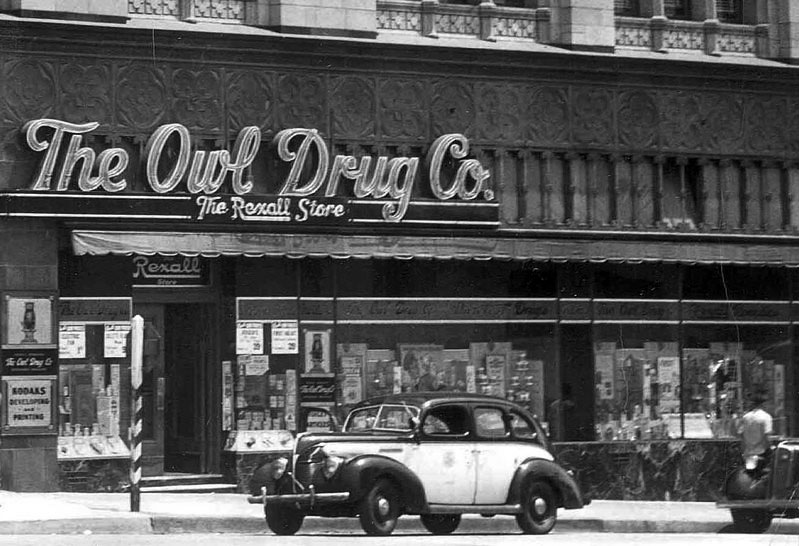 |
|
| (1941)** – Close-up view showing The Owl Drug Company drug store located at 7046 Hollywood Blvd on the SE corner with Sycamore. The store was located in the Hollywood Professional Building. |
Historical Notes The Owl Drug Company drug store was a subsidiary of Rexall stores at its peak in the 1920s through 1940s. In 1912, Owl opened its fourth location in Downtown Los Angeles at Spring and 5th streets. Later branches to open in Los Angeles suburban districts included 6380-84 Hollywood Boulevard (at Cahuenga Boulevard). By the late 1930s, the company had dozens of branches across the United States, operating in major cities like New York and Chicago, and especially in the Los Angeles area.^ |
* * * * * |
Gotham Deli
 |
|
| (ca. 1939)* – View looking at the southwest corner of Hollywood Boulevard and N. Sycamore Avenue showing the Gotham Delicatessen with the Sycamore Apartments on the 2nd floor. Buffalo Wild Wings Grill & Bar along with a 12-story office building stand on the site today. Click HERE to see contemporary view. |
Historical Notes The Gotham Delicatessen was a favorite spot for New York transplants ever since it opened in 1924. During the 1940s, when radio networks were located all throughout Hollywood, many of the radio stars would drop in for dinner. Across the street from Gotham’s was the Hollywood Professional Building where the Screen Actors Guild was located (8th floor). After late-night sessions at the Guild headquarters, Ronald Reagan and other board members would often walk over to Gotham to eat and drink and discuss Guild business. In Bob Thomas's biography on William Holden, actor Dana Andrews recalled one occasion when he joined Holden and Reagan for dinner at Gotham. "After a meeting, Bill, Ronnie and I went to the Gotham to continue our discussion. All three of us ordered drinks, and after we had talked for a while, the waiter came to the table and Bill and I ordered another round. Ronnie said with surprise, 'Why do you want another drink? You just had one.' See what happened: Bill and I became alcoholics and Ronnie became President of the United States." |
* * * * * |
Hollywood Boulevard
 |
|
| (ca. 1940)^##* – View looking east on Hollywood Boulevard at Ivar Avenue. On the corners can be seen Thrifty and Nancy's. In the distance, at Hollywood and Vine, is the Broadway-Hollywood. Click HERE to see contemporary view. |
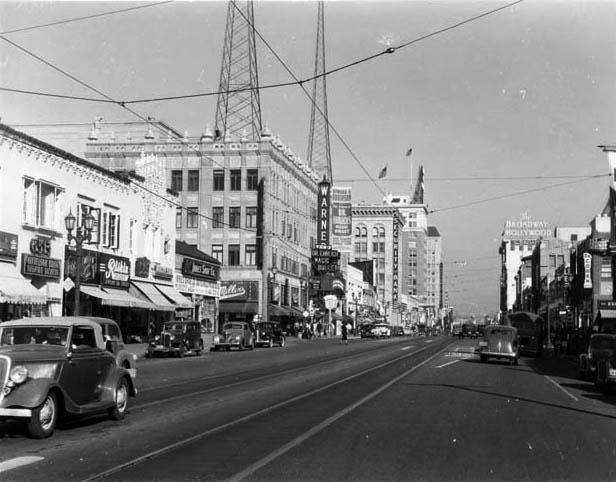 |
|
| (ca. 1940)^^^ - View looking east on Hollywood Boulevard. The Warner Bros. Theatre with its two KFWB roof-mounted transmitter towers can be seen on the northeast corner of Hollywood and Wilcox. |
Historical Notes The original KFWB studios and transmitter location were at the Warner Bros. Studios, which is now KTLA, at 5800 Sunset Boulevard. One of the two original towers still stands prominently out front. Due to RF interference getting into the movie studio's "talkies" sound equipment, the transmitter was moved in 1928 to the roof of the Warner Theater, now the Hollywood Pacific Theatre, at 6423 Hollywood Blvd. Eventually the studios were also moved to the Warner Theater. Those two towers are still there, as well.*^ |
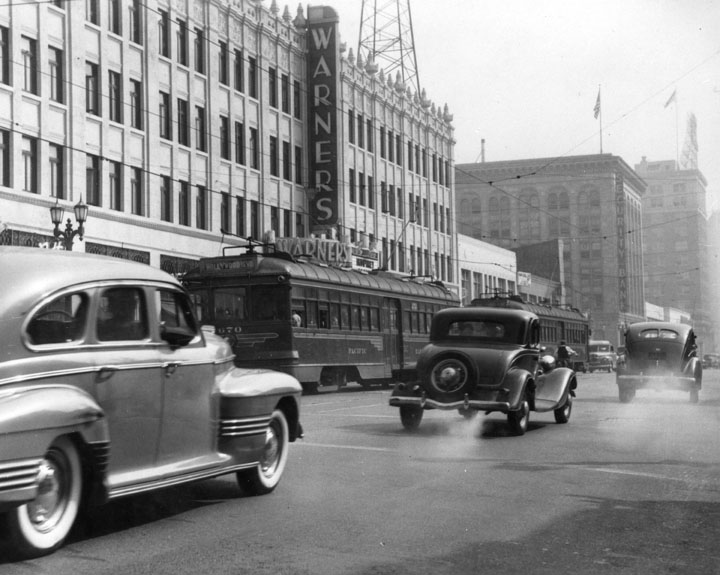 |
|
| (1940)* - BEFORE SMOG CHECKS - Three cars are driving east from Wilcox on Hollywood Blvd., while on the opposite side two streetcars are coming west past Warners movie theater. |
Historical Notes The first “Smog Check” program in California wasn't implemented until 1984. Click HERE to see more in Smog in Early Los Angeles. |
Then and Now
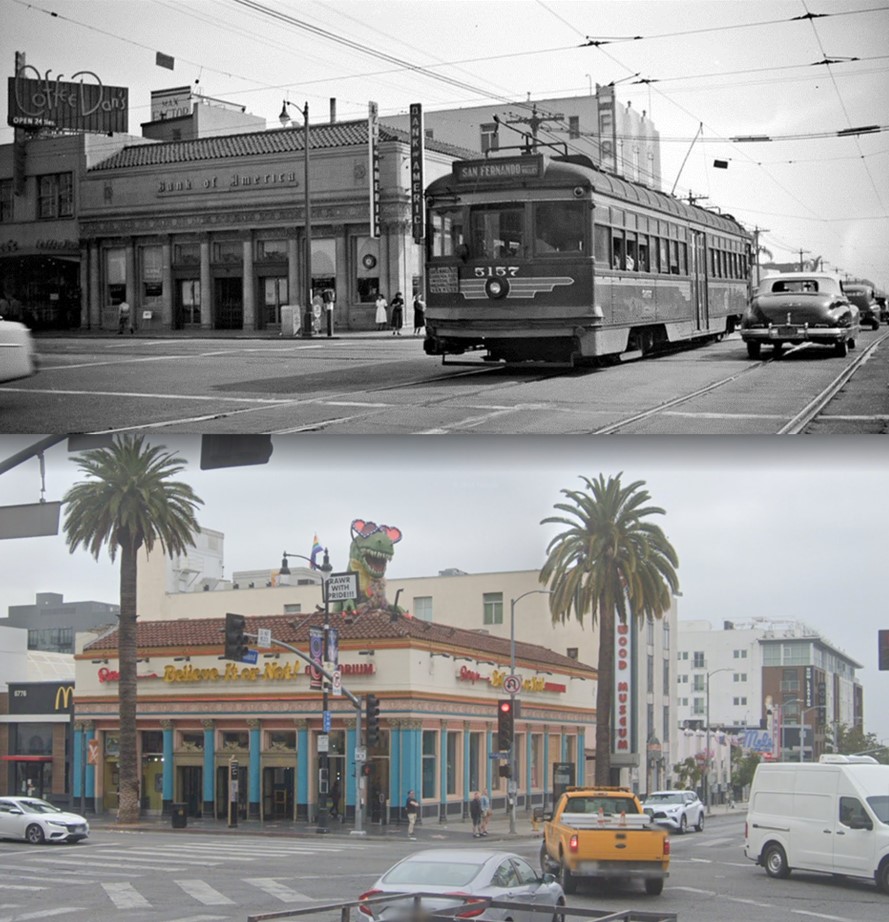 |
|
| Then and Now – Looking East on Hollywood Boulevard from Wilcox Avenue before catalytic converters (1940 vs. 2021). |
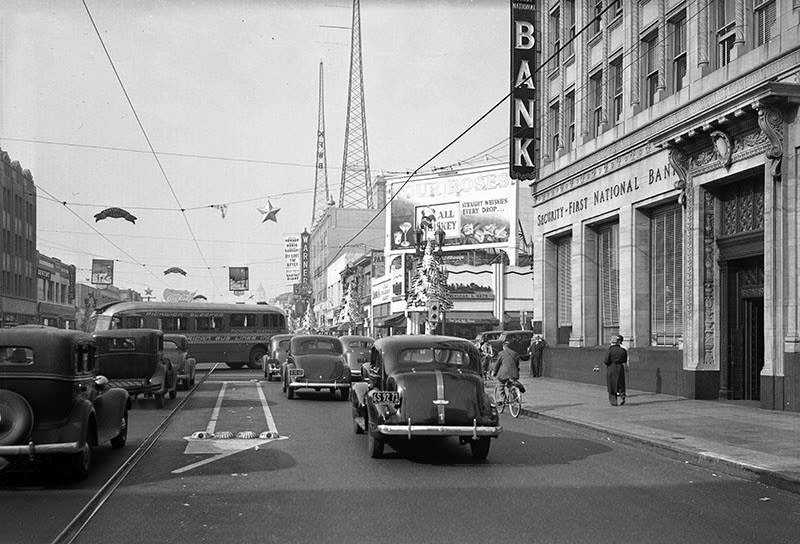 |
|
| (1940s)#**# – View looking west on Hollywood Blvd toward Cahuenga Blvd with the Security Trust and Savings Bank (Security Pacific Bank) at right (NE corner). The two KFWB roof-mounted transmitter towers can be seen in the distance. |
Historical Notes The rectangular area it the middle of the street (at center-left) is where you waited for the streetcar. It was called the “safety zone”. |
Highland Avenue
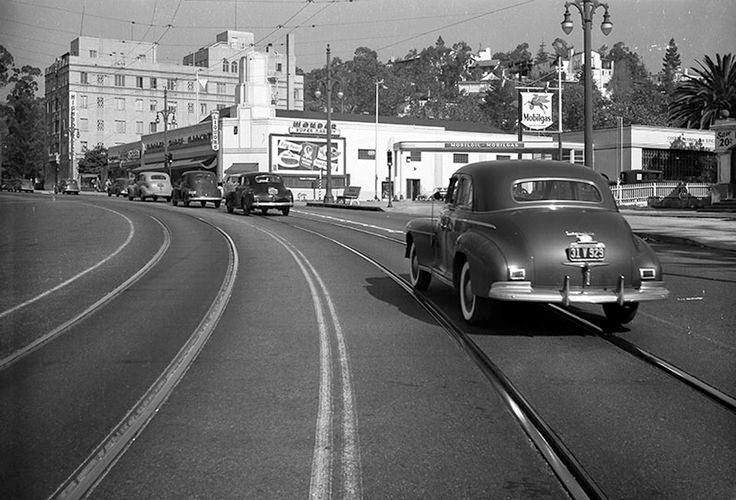 |
|
| (1944)* - Approaching Franklin while traveling north on Highland Avenue. Seen north of Franklin Avenue are the Highland Tower apartment building, an Art Deco commercial building (occupied by a cleaners, Wonder Super Market, and Cut Rate liquors), homes in the Hollywood Hills, and a Foster and Kleiser billboard for Sun Maid raisins; south of Franklin Avenue is a Mobil service station. |
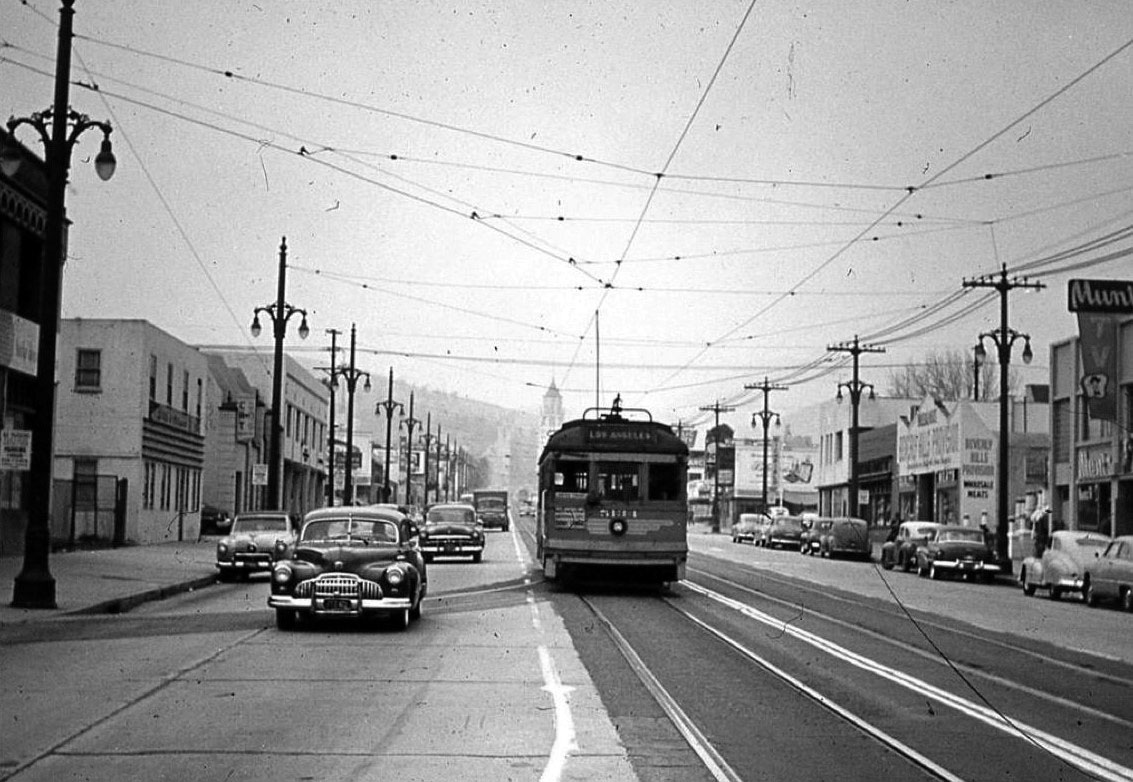 |
|
| (ca. 1940s)#**# – View looking north on Highland near Sunset Boulevard. In the distance, past the Red Car, you can see the tower of the Hollywood First National Bank Building on the Northeast corner of Hollywood Blvd at Highland. |
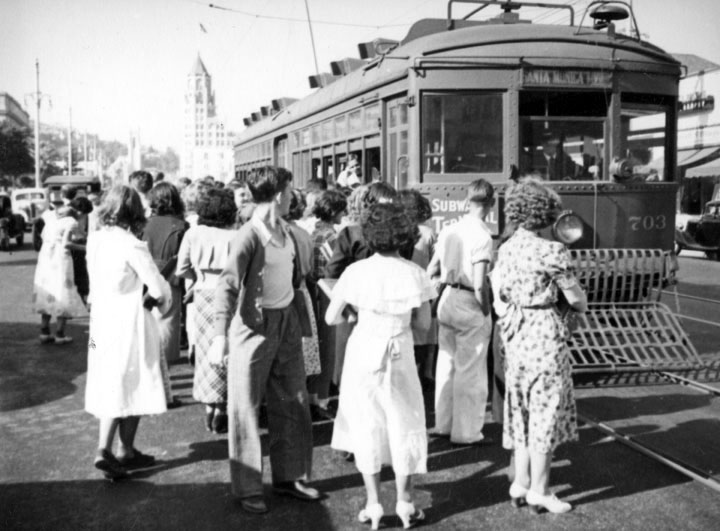 |
|
| (ca. 1940s)* - A group of people boarding the Pacific Electric Railway on Highland near Hollywood High School for the Subway Terminal Building via Santa Monica Boulevard. |
* * * * * |
.jpg) |
|
| (ca. 1940)* - Panoramic view of Hollywood looking northwest toward the Cahuenga Pass. The Hollywood Freeway and Cahuenga Pass are visible at the top of the photo, with the San Fernando Valley far off in the distance. |
Historical Notes The first segment of the Hollywood Freeway built was a one and a half mile stretch through the Cahuenga Pass. That segment opened on June 15, 1940. It was then known as the "Cahuenga Pass Freeway." Pacific Electric Railway trolleys ran down the center of this freeway until 1952.*^ The cluster of buildings in the middle portion of this urban jungle are: KNX and CBS Radio Playhouse (short, windowless building mid-photo); Plaza Hotel; Broadway-Hollywood; Hotel Knickerbocker - which are all along the left side of Vine St.; and the Taft Building - across the street on the right side of Vine Street. The three large white buildings running in an east/west direction along Sunset Blvd. are: CBS Television (long horizontal windows on lower right); the famous Hollywood Palladium (semi-domed white roof, lower middle); and NBC Studios (white building with three long, vertical windows) located on the corner of Sunset and Vine.* |
Hollywood Palladium
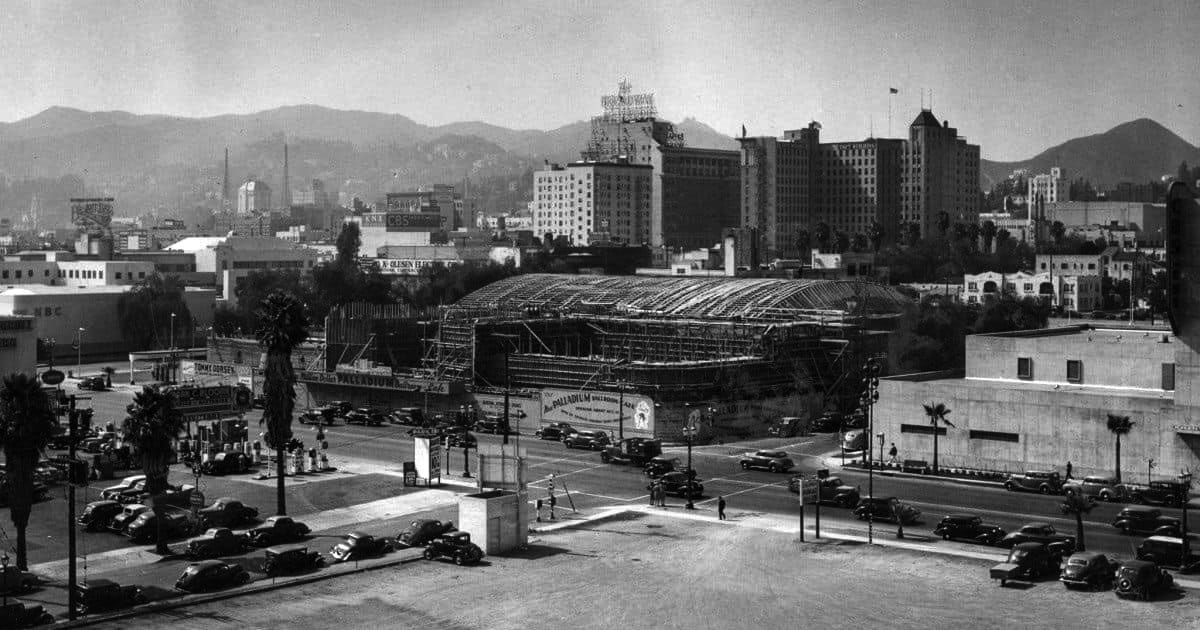 |
|
| (1940)* – View showing the Hollywood Palladium under construction on the NW corner of Sunset Boulevard and El Centro Ave. On the NE corner (on the right) is CBS Columbia Square, built 2-years earlier. The tall buildings in the distance are located at or near the intersection of Hollywood and Vine. Mark C. Bloome Service Station is seen on the left on the south side of Sunset. |
Historical Notes Los Angeles Times publisher Norman Chandler funded the construction of the art deco Hollywood Palladium at a cost of $1.6 million in 1940. It was built where the original Paramount lot once stood by film producer Maurice Cohen and is located between Argyle and El Centro avenues. ^ |
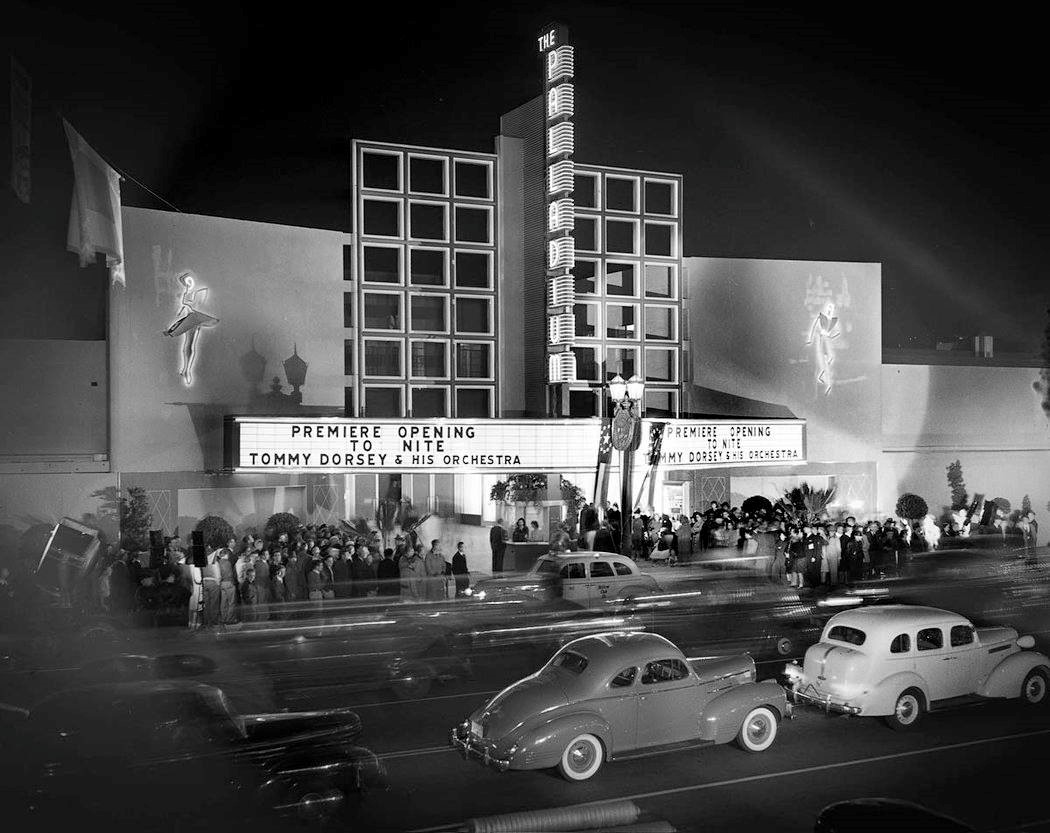 |
|
| (1940)* – Opening night of the Art Deco Hollywood Palladium. Photo by Gordon Wallace |
Historical Notes The Art Deco Hollywood Palladium opened on Halloween night, 1940. Built by film-producer Maurice Cohen, the building occupied the site of the original Paramount lot. The million-dollar ballroom-cafe, which can accommodate comfortably 7500 persons, was literally packed to the rafters with Band Leader Tommy Dorsey blew the first blast from his trombone and his orchestra let loose with some jive and swing music. |
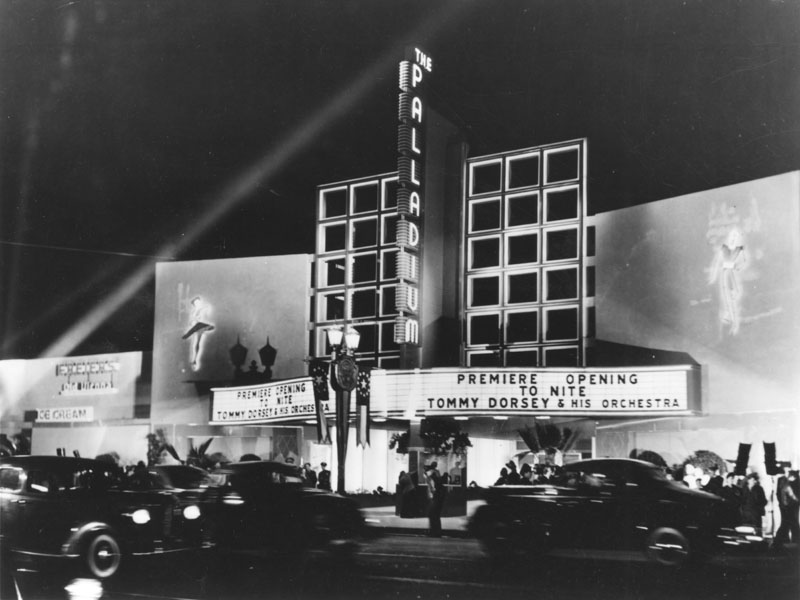 |
|
| (1940)* - Marquee at the Palladium shows premiere opening of Tommy Dorsey and his orchestra. The Palladium is located at 6215 W Sunset Boulevard in Hollywood. |
Historical Notes The ballroom opened October 31, 1940 with a dance featuring Tommy Dorsey and his Orchestra and band vocalist Frank Sinatra. It had six bars serving liquor and two more serving soft drinks and a $1 cover charge and a $3 charge for dinner.^ |
.jpg) |
|
| (1940s)* - Hollywood Palladium during WWII. The dance floor is fiilled to capacity. |
Historical Notes The style dance hall was designed by Gordon Kaufmann, architect of the Greystone Mansion, the Los Angeles Times building and the Santa Anita Racetrack in Arcadia. He was also the architect for the Hoover Dam and early Caltech dorms.^ During WWII, the Palladium hosted radio broadcasts featuring Betty Grable greeting servicemen’s' song requests. Big Band acts began losing popularity in the 1950s, causing the Palladium to hold charity balls, political events, auto shows, and rock concerts. In 1961, it became the home of the long-running Lawrence Welk Show.^ |
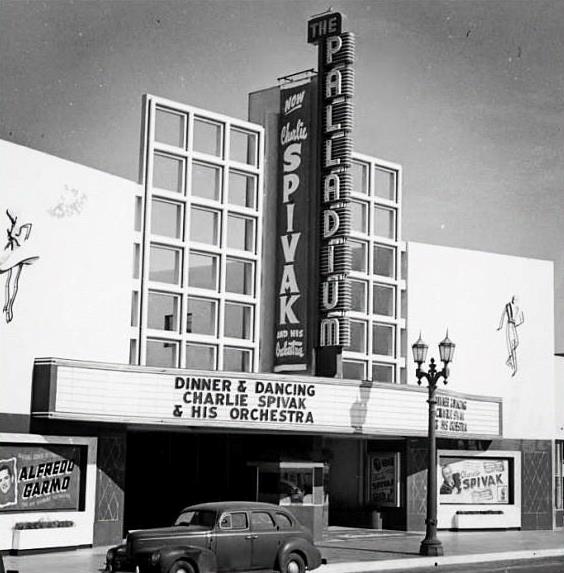 |
|
| (1940)* - View showing the Hollywood Palladium, located at 6215 West Sunset Boulevard. The marquee reads: Dinner & Dancing - Charlie Spivak & His Orchestra |
Historical Notes Charlie Spivak was an trumpeter and bandleader, best known for his big band in the 1940s.^ |
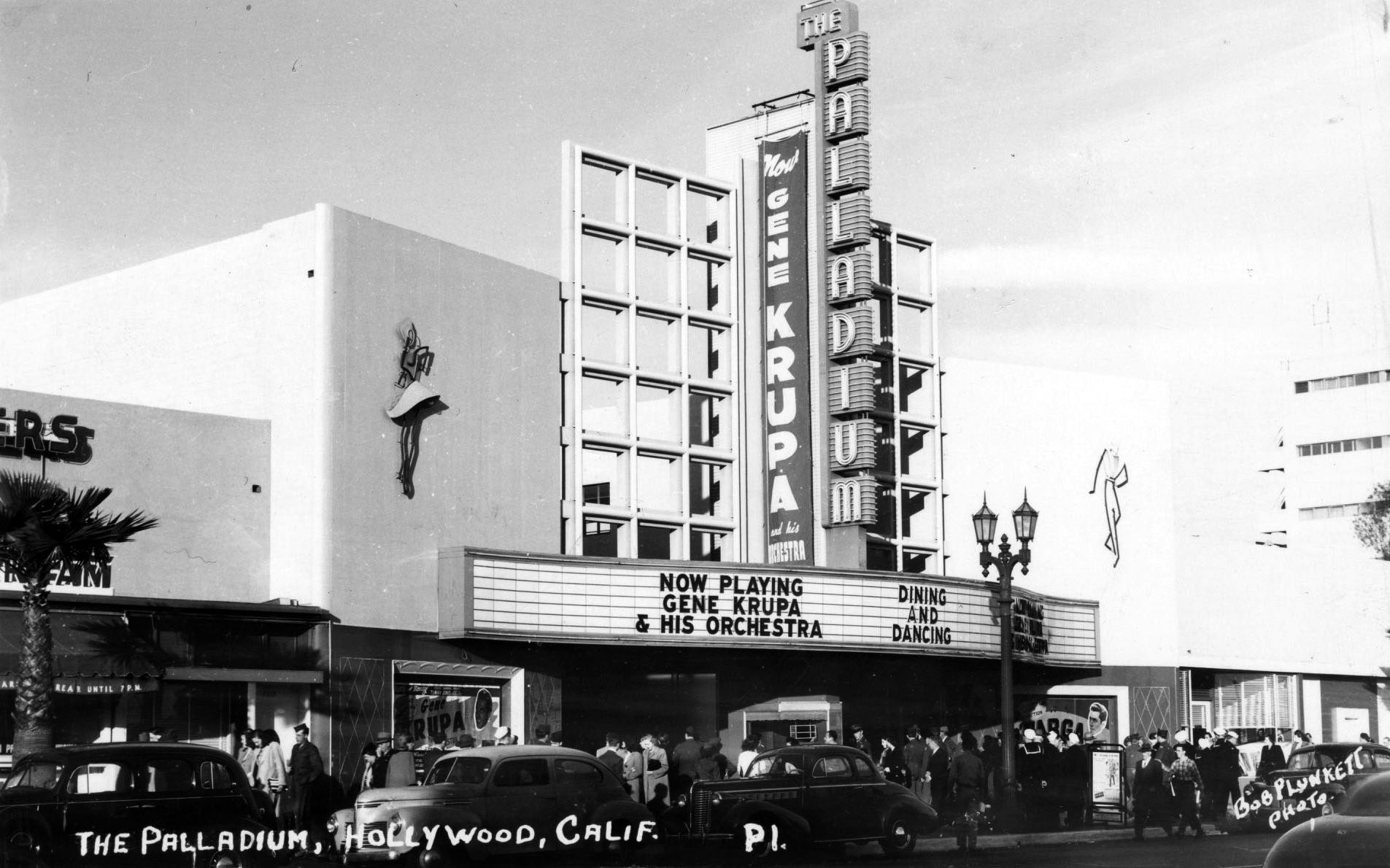 |
|
| (1940s)^ – Postcard view showing the Palladium in Hollywood. Now playing Gene Krupa & His Orchestra. Photo by Bob Plunkett |
Historical Notes Gene Krupa was a jazz drummer, band leader and composer known for his energetic style and showmanship. His drum solo on "Sing, Sing, Sing" (1937) elevated the role of the drummer from an accompanying line to an important solo voice in the band. In collaboration with the Slingerland drum and Zildjian cymbal manufacturers, he was a major force in defining the standard band drummer's kit. Krupa is considered "the founding father of the modern drumset" by Modern Drummer magazine.^ |
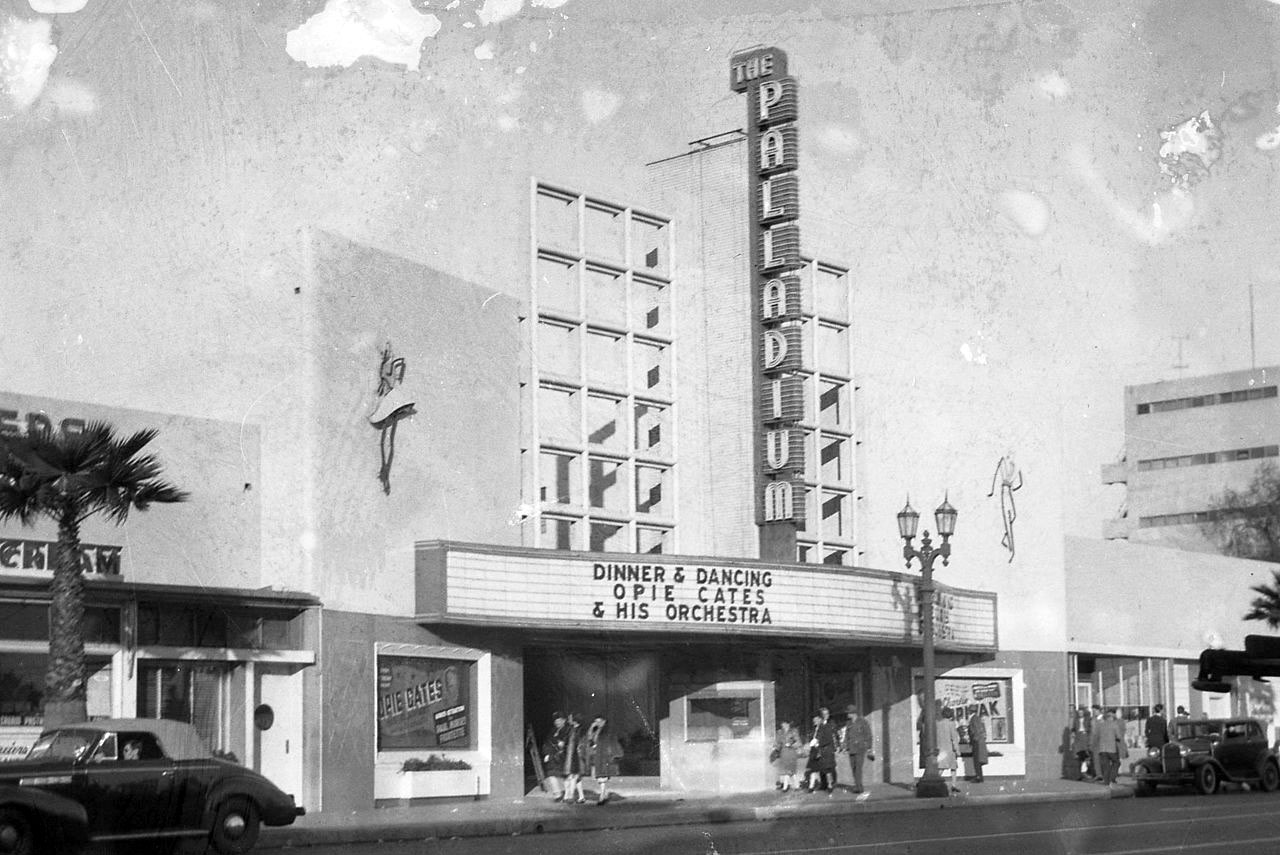 |
|
| (1947)^ - The Hollywood Palladium with Opie Cates and his Orchestra on the bill. |
Historical Notes Opie Cates was a clarinet player and band leader in the 1930s and 1940s, during the swing era, who became a radio actor. |
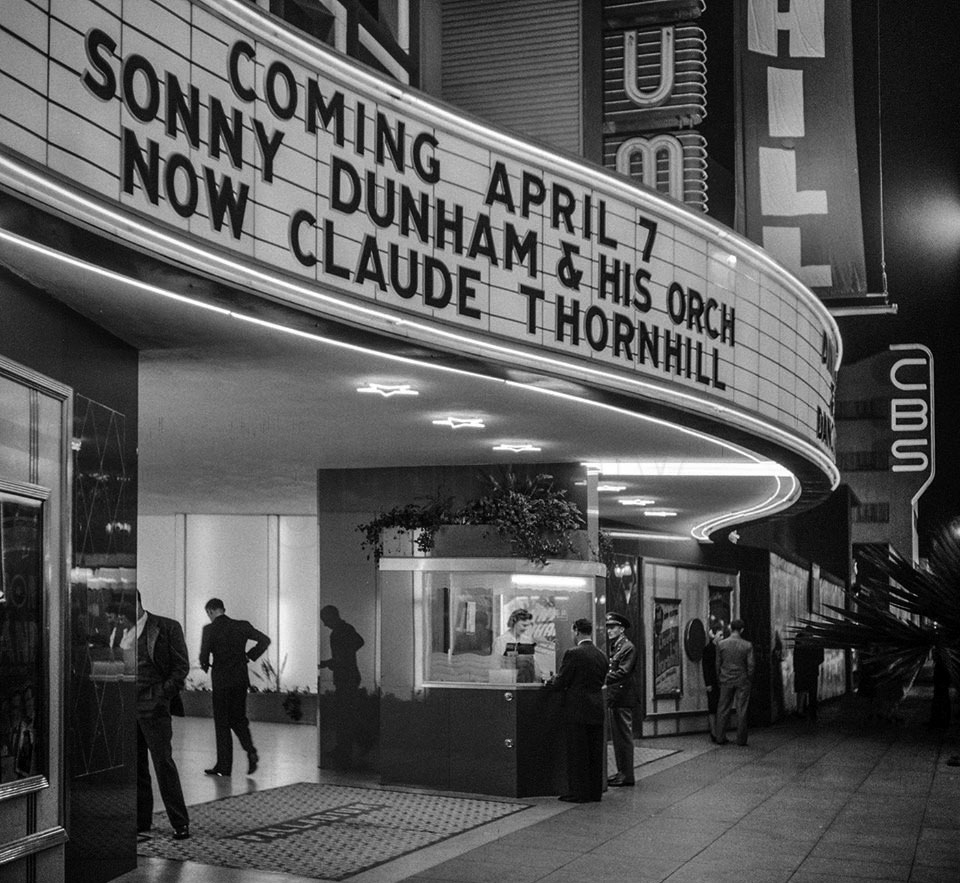 |
|
| (1942)* – Close-up view of the ticket window and marquee of the Hollywood Palladium. Now playing Claude Thornhill with Sonny Dunham & His Orchestra the coming attraction. In the distance can be seen CBS Columbia Square. Photo Library of Congress |
Historical Notes Sonny Dunham was a trumpet player and bandleader. A versatile musician, he was one of the few trumpet players who could double on the trombone with equal skill.^ Claude Thornhill was a pianist, arranger, composer, and bandleader. He composed the jazz and pop standards "Snowfall" and "I Wish I Had You".^ |
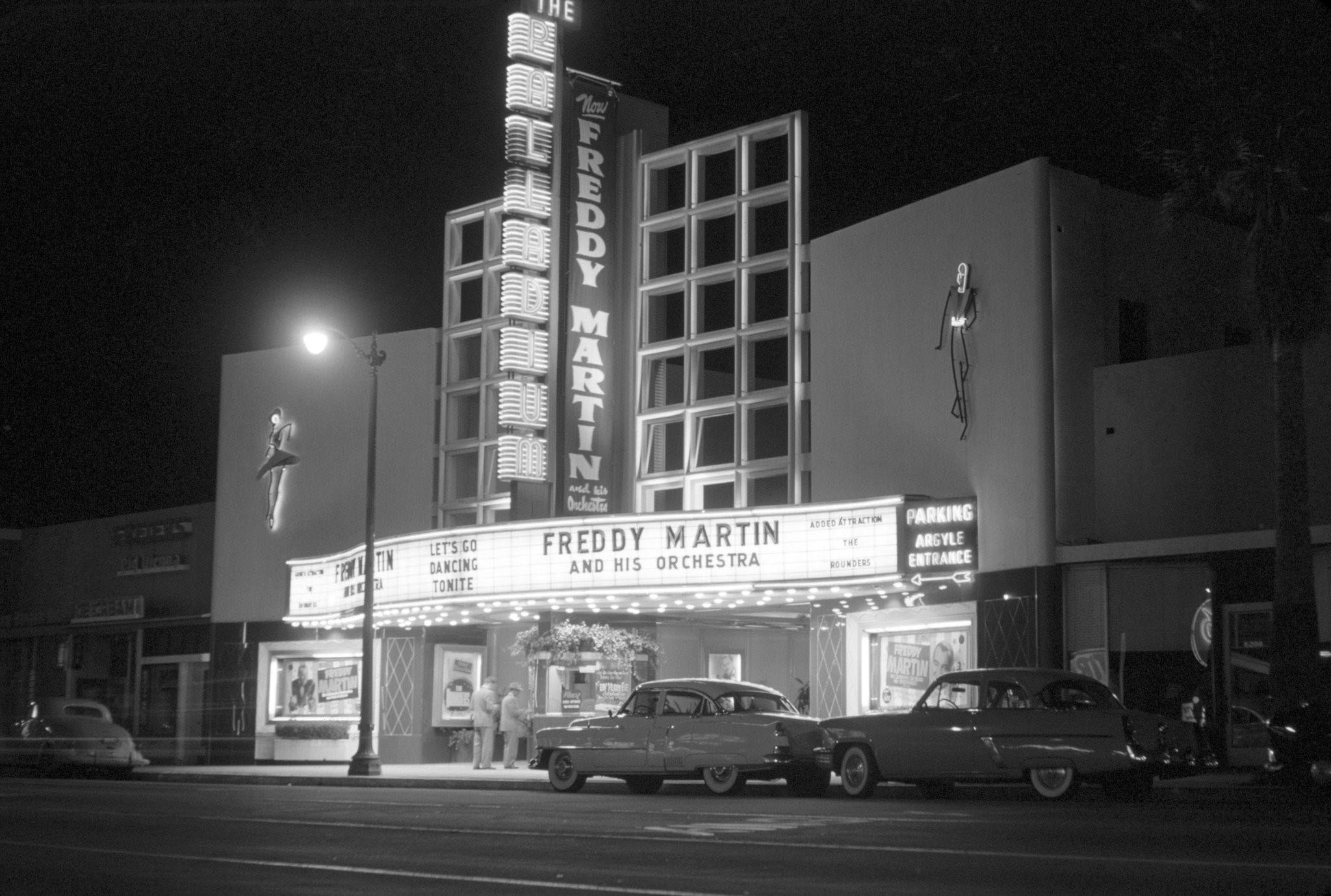 |
|
| (ca. 1950)^ - The Hollywood Palladium featuring Freddy Martin and his Orchestra. Photo LA Times |
Historical Notes Freddy Martin was an American bandleader and tenor saxophonist. |
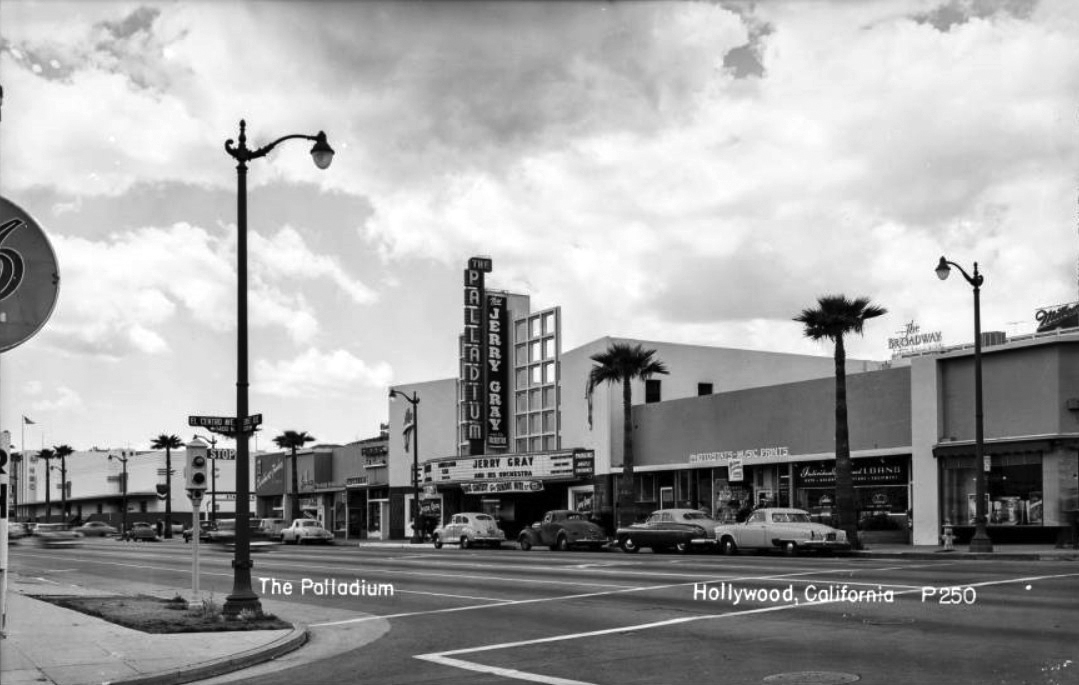 |
|
| (ca. 1950)* – Postcard view looking towards Sunset Boulevard from the intersection of El Centro Avenue in Hollywood, with the Palladium theater at center, Radio City NBC Studios at far left and the Broadway Building in the distance at right. The Palladium marquee reads "Jerry Gray and his Orchestra" next to a storefront with a sign for Photostats - Music Prints" |
Historical Notes Jerry Gray was a violinist, arranger, composer, and leader of swing dance orchestras (big bands) bearing his name. He is widely known for his work with popular music during the Swing era. His name is inextricably linked to two of the most famous bandleaders of the time, Artie Shaw and Glenn Miller.^ |
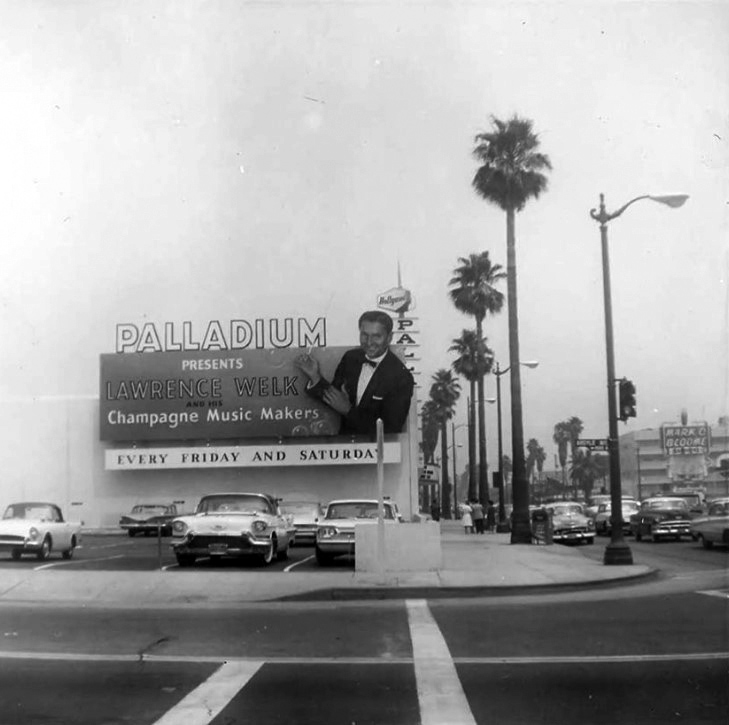 |
|
| (ca. 1961)^ – View looking east toward the Palladium showing an oversized Bilboard for Lawrence Welk and his Champagne Music Makers on the west face of the building. Mark C. Bloome can be seen across the street (south side of Sunset). |
Historical Notes By the early 1960s, swing and the big band sound was out, and on Friday and Saturday nights, from 1961 to 1976, Lawrence Welk and his orchestra played the Palladium, filling the huge place with his special brand of “champagne music.” |
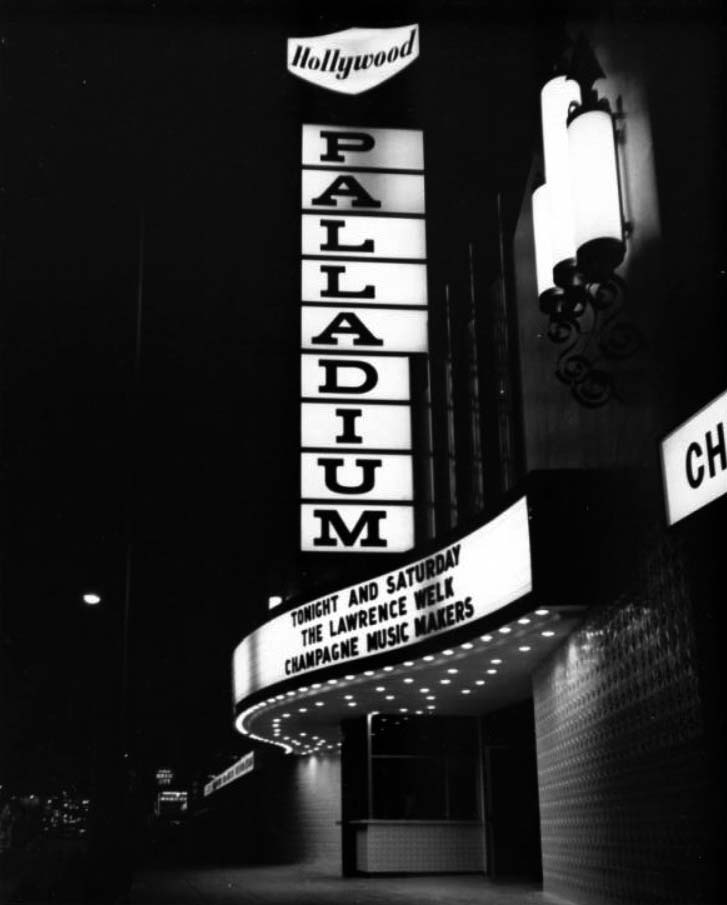 |
|
| (1960s)^^ - Night view of the Palladium Theater located in Hollywood at the corner of Sunset Boulevard and Argyle Avenue. Marquee reads: Tonight and Saturday – The Lawrence Welk Champagne Music Makers |
Historical Notes The Lawrence Welk Show started in 1951 as a local program on KTLA-TV in Los Angeles. The original show was broadcast from the since-demolished Aragon Ballroom at Venice Beach. The show made its national TV debut on July 2, 1955, and was initially produced at the Hollywood Palladium, moving to the ABC studios at Prospect and Talmadge in Hollywood shortly afterwards. For 23 of its 27 years on the air, the show would originate there. The only seasons not produced there were 1965–66, 1976–77 at the Hollywood Palace and CBS Television City from 1977 to 1979.* |
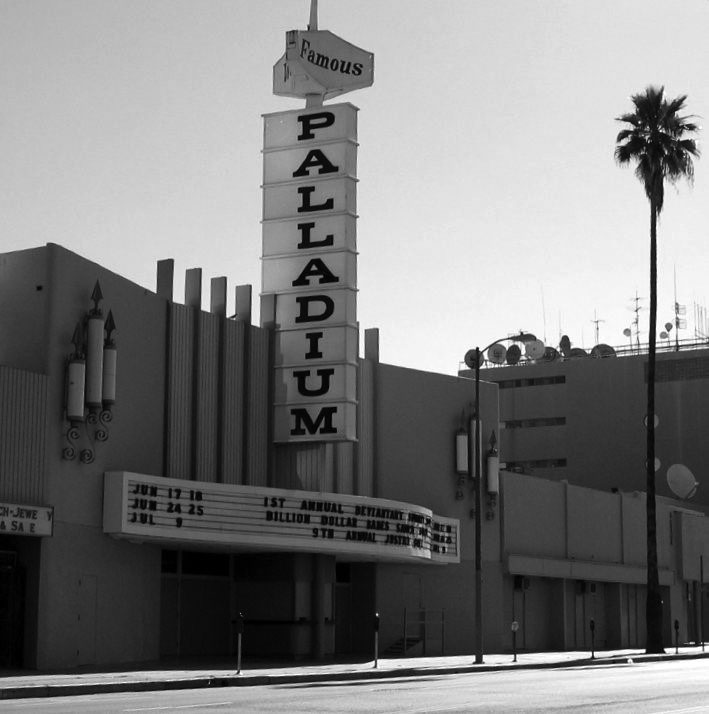 |
|
| (2005)^ - View showing the Hollywood Palladium, prior to 2008 renovation. Wikipedia Commons. Click HERE for contemporary view. |
Historical Notes In 2007, the owners agreed to a long-term lease to operate, manage and exclusively book the Hollywood Palladium with Live Nation, a Los Angeles-based company. |
* * * * * |
Hollywood Bowl
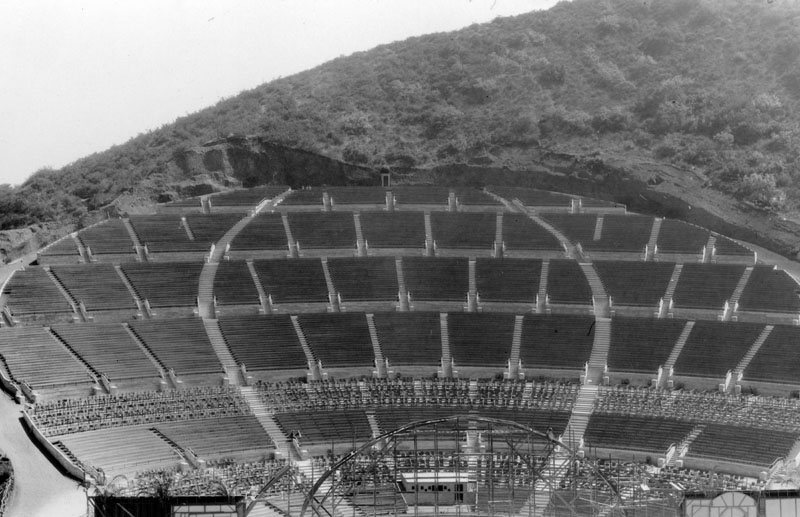 |
|
| (n.d.)* - Postcard view of the Hollywood Bowl showing its shell under construction. |
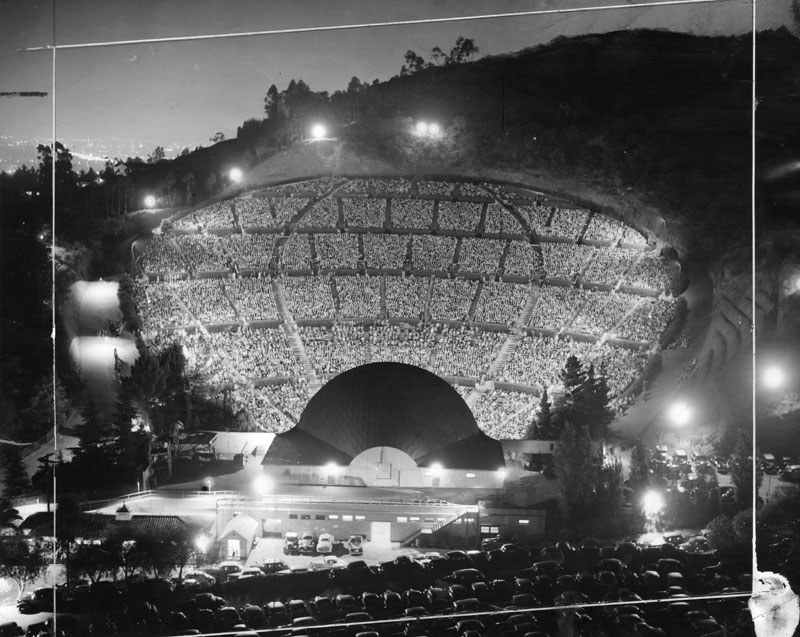 |
|
| (1941)* - Photo captions read: "Hollywood Bowl--getting face lifted for July 14 opener: It's pictured in night scene; Bowl enthusiasts will find new 'Meet Me There' circle and other innovations." "Picturesque Hollywood Bowl, home of the 'Symphonies Under the Stars,' will be the scene of a new series between July 15 and Sept. 7. The bowl is shown above with its beautiful panorama of light, color and music." |
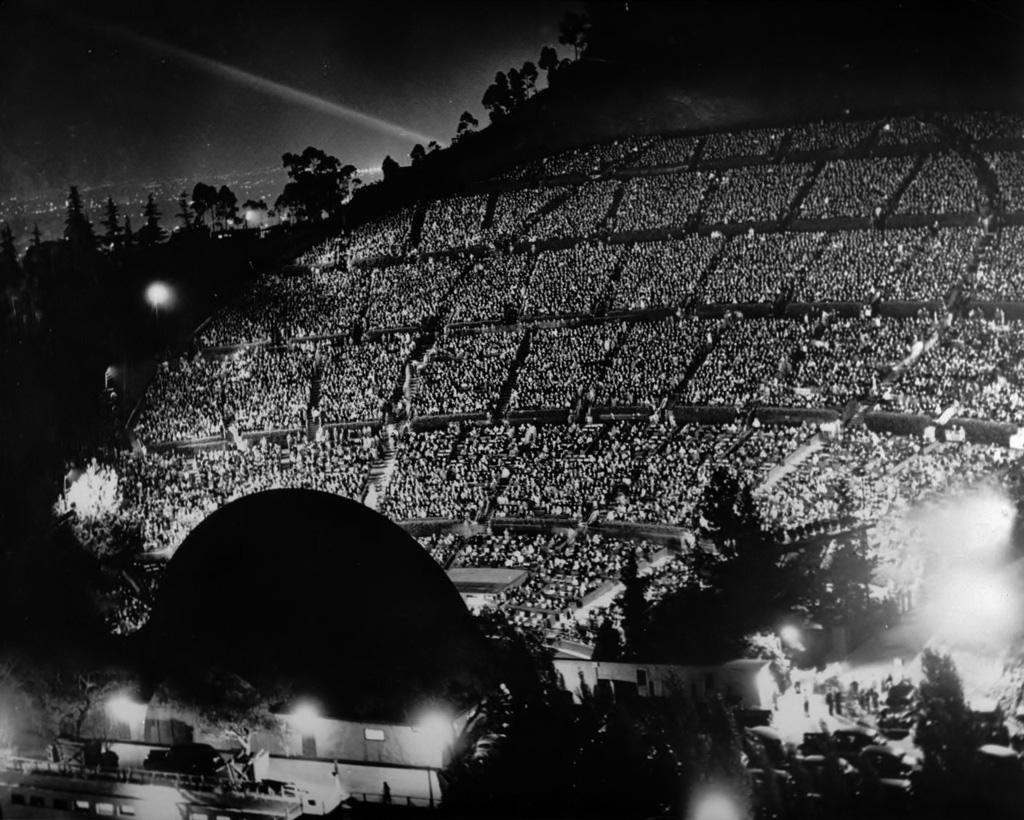 |
|
| (1940)^^ - Panoramic view of the Hollywood Bowl at night, showing spectators. |
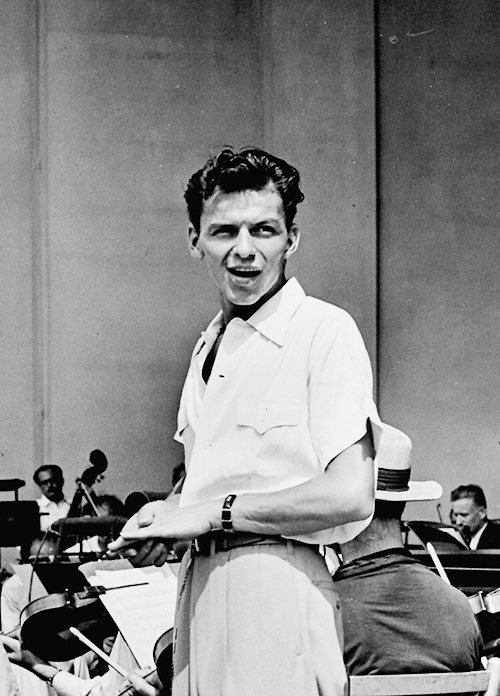 |
|
(1943)**** - Frank Sinatra's Hollywood Bowl debut on August 14, 1943 was the first appearance by a pop singer with the Los Angeles Philharmonic.
|
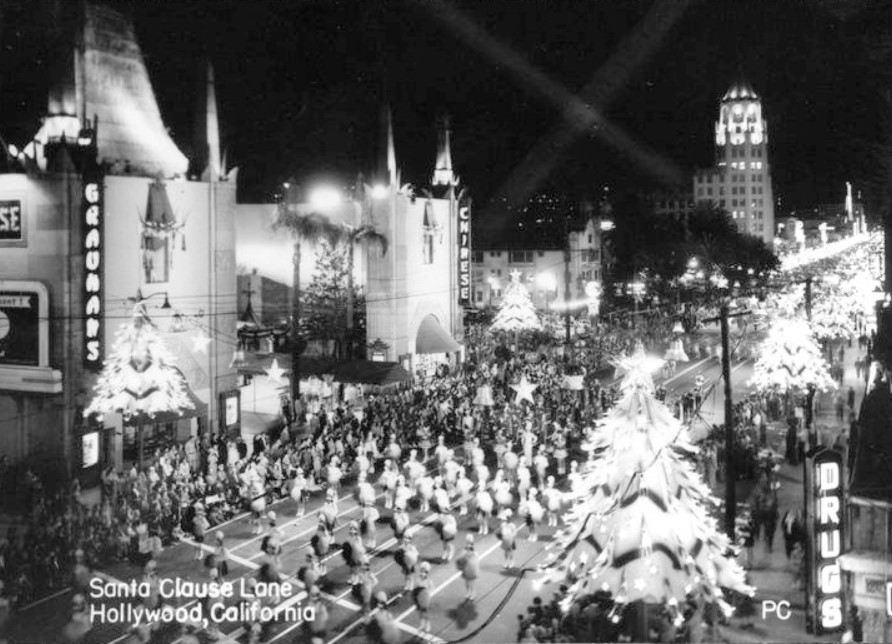 |
|
| (ca. 1940)**** - View of the Santa Claus Lane Parade in front of Grauman's Chinese Theatre. |
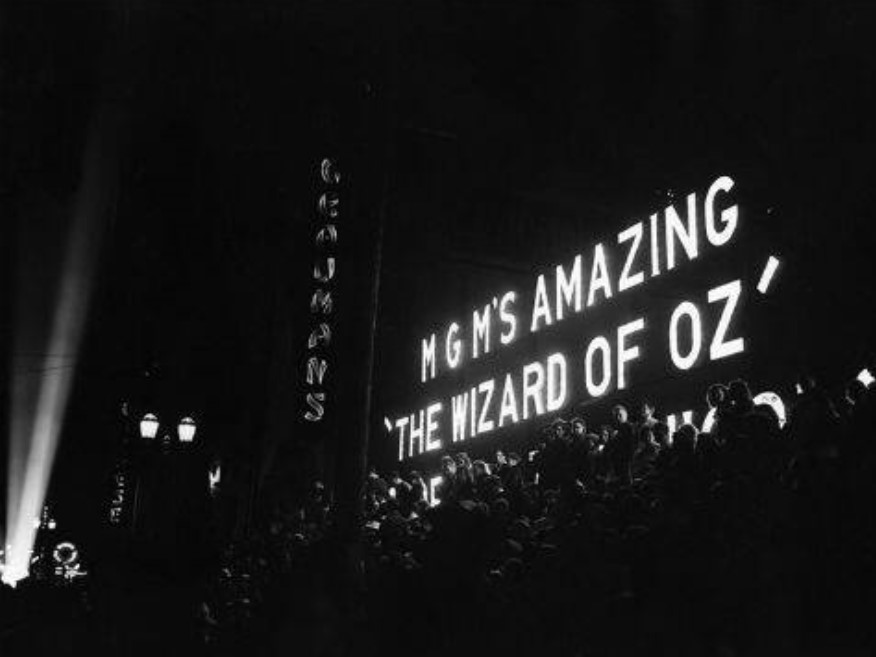 |
|
| (1939)##^* – View of the stands in front of Grauman's Chinese Theatre during the premier of ‘The Wizard of Oz’ on August 15, 1939. |
Historical Notes The Wizard of Oz film was produced by Metro-Goldwyn-Mayer and is the most well-known and commercial adaptation based on the 1900 novel The Wonderful Wizard of Oz by L. Frank Baum. The film stars Judy Garland; Terry the dog, billed as Toto; Ray Bolger, Jack Haley, Bert Lahr, Frank Morgan, Billie Burke, Margaret Hamilton, with Charley Grapewin and Clara Blandick, and the Singer Midgets as the Munchkins, with Pat Walshe as leader of the flying monkeys. Notable for its use of Technicolor, fantasy storytelling, musical score and unusual characters, over the years it has become one of the best known of all films and part of American popular culture. It also featured in cinema what may be for the time the most elaborate use of character make-ups and special effects. It was not a box office success on its initial release, earning only $3,017,000 on a $2,777,000 budget, despite receiving largely positive reviews. The film was MGM's most expensive production at that time, and did not recoup much of the studio's investment until subsequent re-releases. It was nominated for six Academy Awards, including Best Picture but lost to Gone with the Wind. It did win in two other categories including Best Original Song for "Over the Rainbow." The song was ranked first in two lists: the AFI's 100 Years...100 Songs and the Recording Industry Association of America's "365 Songs of the Century".*^ |
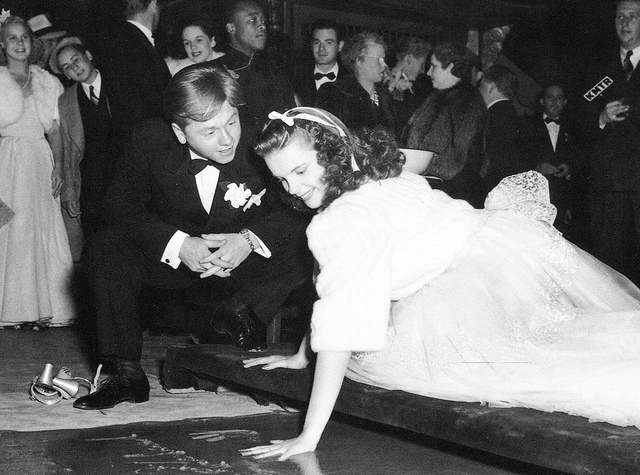 |
|
| (1940)**** - Mickey Rooney and Judy Garland at Grauman's Chinese Theatre in Hollywood. |
Historical Notes When “The Wizard of Oz” (1939) was released, Judy and Mickey toured together to promote that film as well as their “Babes in Arms” musical. Mickey would present Judy with her very special Oscar for Best Juvenile Performance that year. They were at Grauman’s Chinese Theatre together when Judy set her hands and feet in cement in 1940.^#*# |
Seven Seas Restaurant & Nightclub
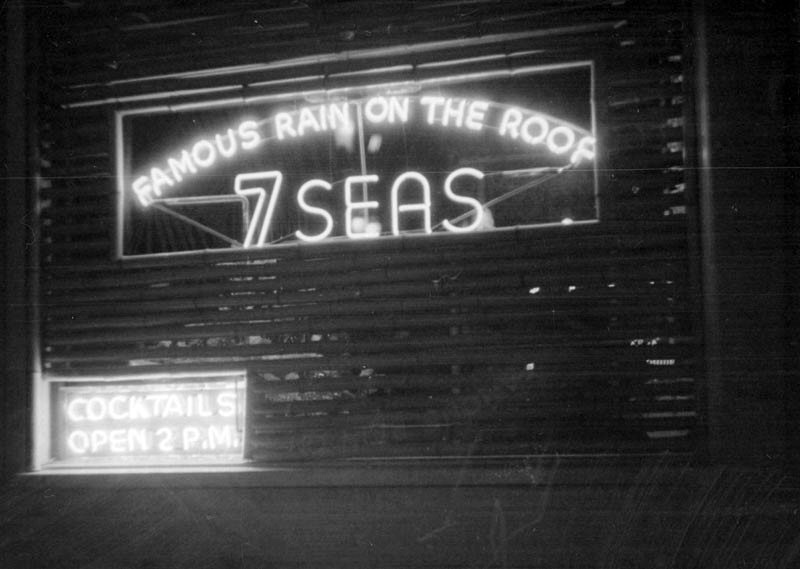 |
|
| (1940s)* – View showing signage for the Seven Seas Restaurant, where the sophisticated dine in an exotic Tahitian atmosphere amidst tropical thunder, lightning and the famous "Rain on the Roof". With world-renowned cuisine and celebrated rum drinks. The famous restaurant / nightclub was located at 6904 Hollywood Boulevard. |
Historical Notes Ray Haller started the Seven Seas in the mid-1930s as a Polynesian bar and soon became a hot spot for Hollywood celebrities as well as the soldiers and sailors stationed in Los Angeles during WWII. The inside was decorated with tropical plants, nautical souvenirs, lava rocks and a faux corrugated metal roof above allowing for its most unique and original feature - a nightly tropical rainstorm inside the bar complete with authentic thunder sounds played from a record player. |
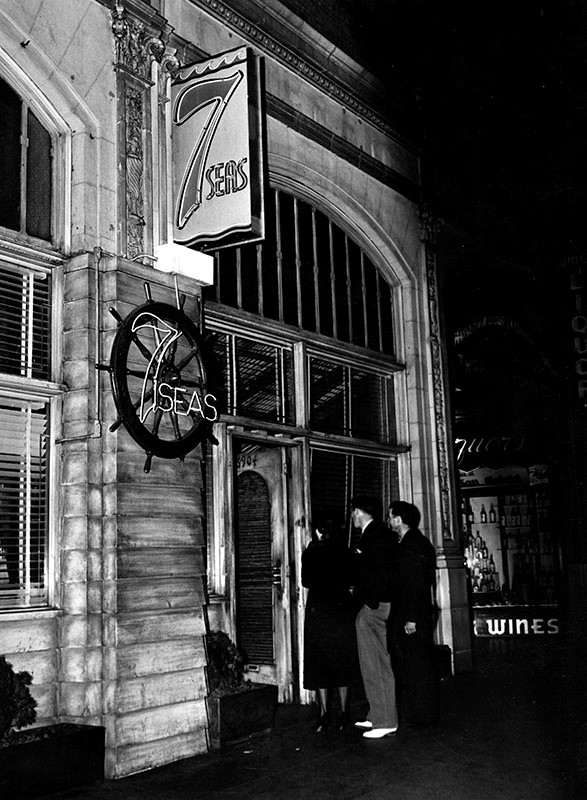 |
|
| (ca. 1950)* - Two men and a woman are shown in front of the Seven Seas Restaurant located at 6904 Hollywood Boulevard, in the Cinemart Building near Highland. The group is standing at the entrance to the restaurant which has a protruding neon sign above the entrance that reads "7 Seas." Below that is a ship's wheel with "7 Seas" in neon. On the right, partially obscured is a building with the signs "liquor" and "wines," and bottles can be seen in the window. |
Historical Notes The first owner, Ray Haller, was inspired when his customers thought the building’s leaky roof during rainstorms was cute. Haller installed sprinklers to create the effect nightly. The next Seven Seas owner, Bob Brooks, added a full Hawaiian show headlined by Jenni “Na Pua” (Little Flower) Wood, the hula comic. Jennie remained here for twenty-five years.^ The Cinemart Building is still there today but now occupied by other tenants including a souvenir store (The Hollywoodland Experience) and a clothing store (Zara). Click HERE for contemporary view. |
Mosher Tire Service
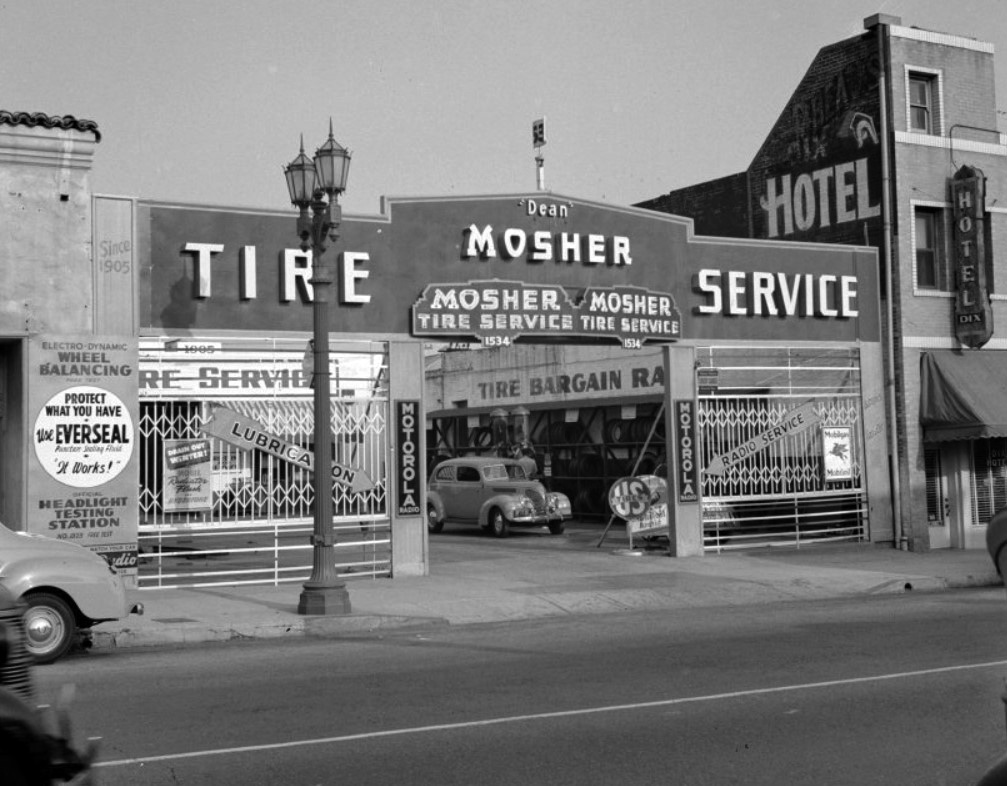 |
|
| (1942)^.^ - Dean Mosher Tire Service located at 1534 N. Cahuenga Boulevard in Hollywood, next to the Dix Hotel. Photo by Russell Lee. |
Historical Notes Lewis Dean Mosher worked here until 1942 when he moved the business to 12117 Burbank Blvd in North Hollywood. Click HERE to see new North Hollywood location. |
'Jimmie' Ervin Jr. Used Cars
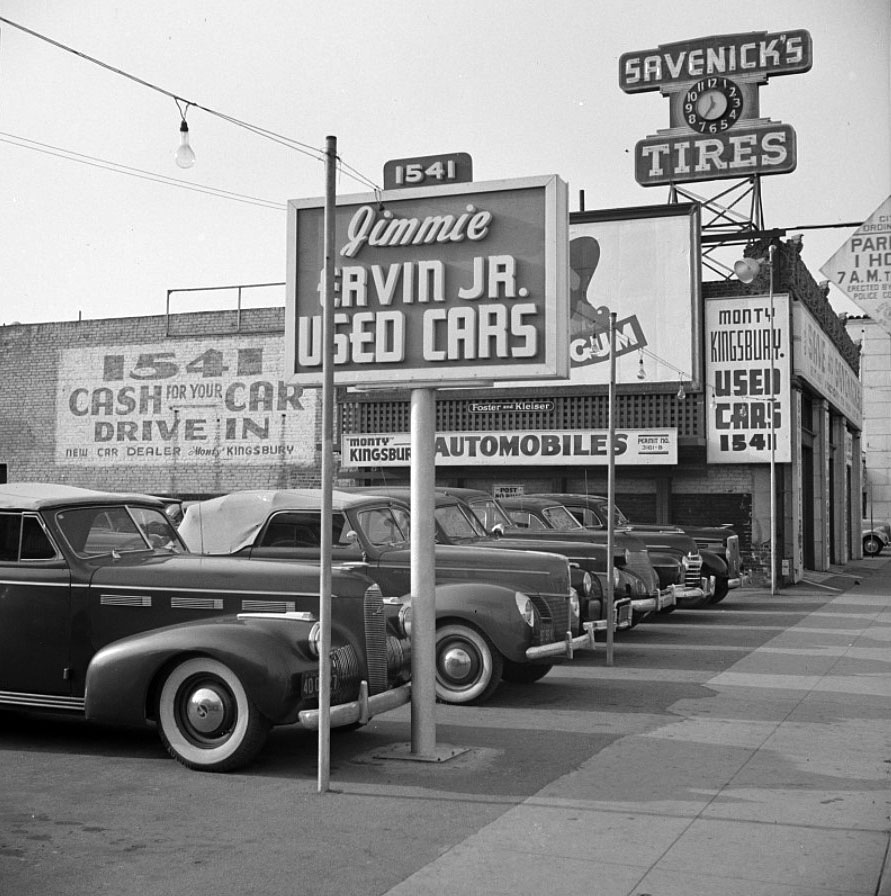 |
|
| (1942)^ - View showing a used car lot at 1541 Cahuenga Boulevard, Hollywood. Cars from left to right include: a LaSalle convertible, a 1940 Ford Deluxe convertible, a 1941 Ford, a late '30s Chevy, an Olds, and a Cadillac. Signs read: Jimmy Erwin Jr. Used Cars, Monty Kingsbury Used Cars, and Savanick’s Tires. |
* * * * * |
Hollywood Canteen
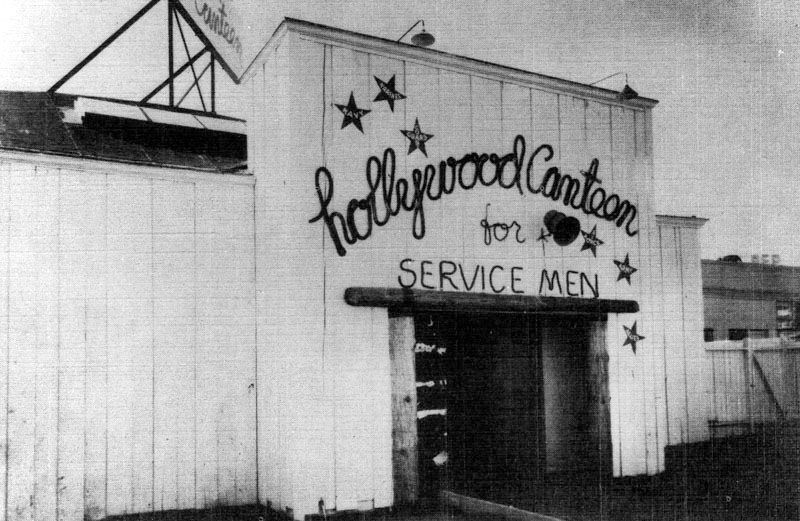 |
|
| (1943)* - Postcard view of the Hollywood Canteen for Service Men, located at 1451 N. Cahuenga Boulevard. |
Historical Notes The Hollywood Canteen operated between 1942 and 1945, as a club offering food, dancing and entertainment for servicemen, usually on their way overseas. A serviceman's ticket for admission was his uniform, and everything at the canteen was free of charge. |
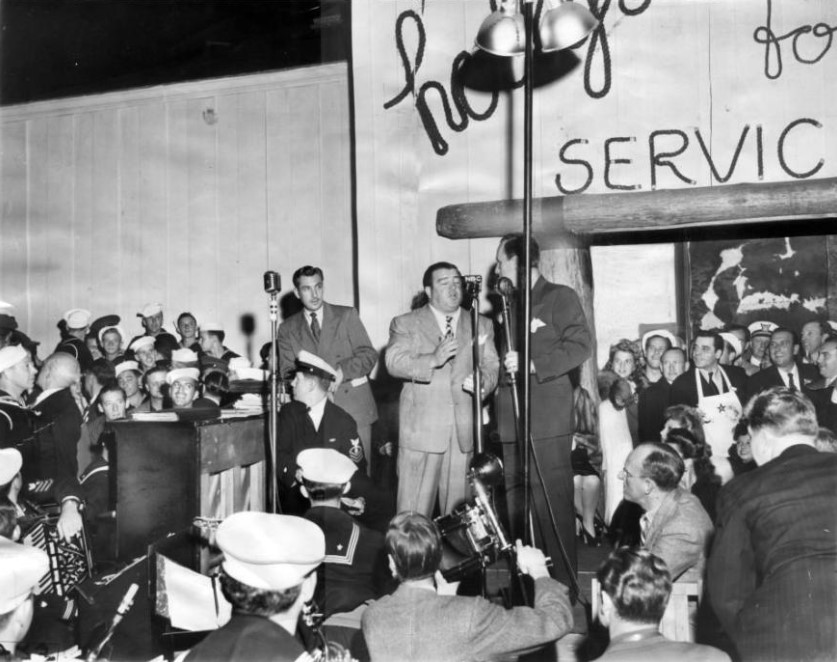 |
|
| (1942)* - Abbot and Costello performing one of their routines at opening night of the Hollywood Canteen. |
Historical Notes The driving forces behind its creation were Bette Davis and John Garfield, along with Jules Stein, President of Music Corporation of America. The Canteen was operated and staffed completely by volunteers from the entertainment industry. Stars volunteered to wait on tables, cook in the kitchen and clean up. One of the highlights for a serviceman was to dance with one of the many female celebrities volunteering at the Canteen. The other highlight was the entertainment provided by some of Hollywood's most popular stars, ranging from radio stars to big bands to novelty acts. |
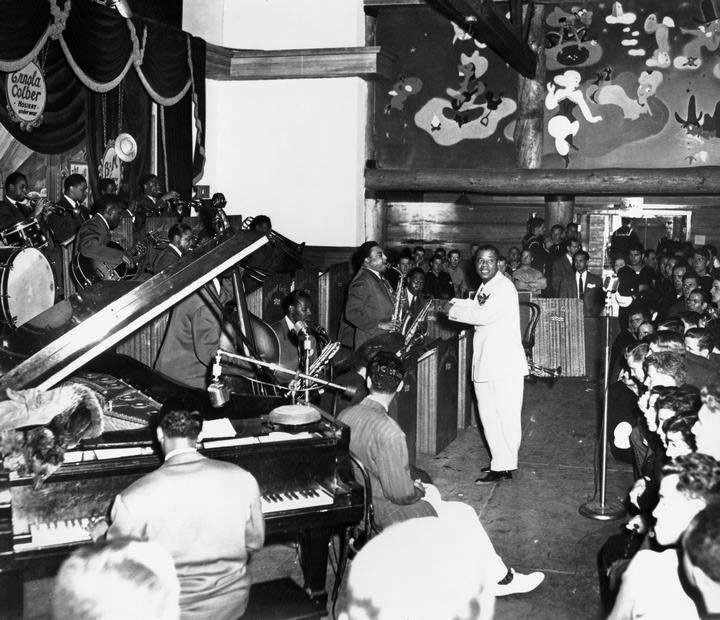 |
|
| (1940s)* - Louis Armstrong entertaining the troops at the Hollywood Canteen during WWII. |
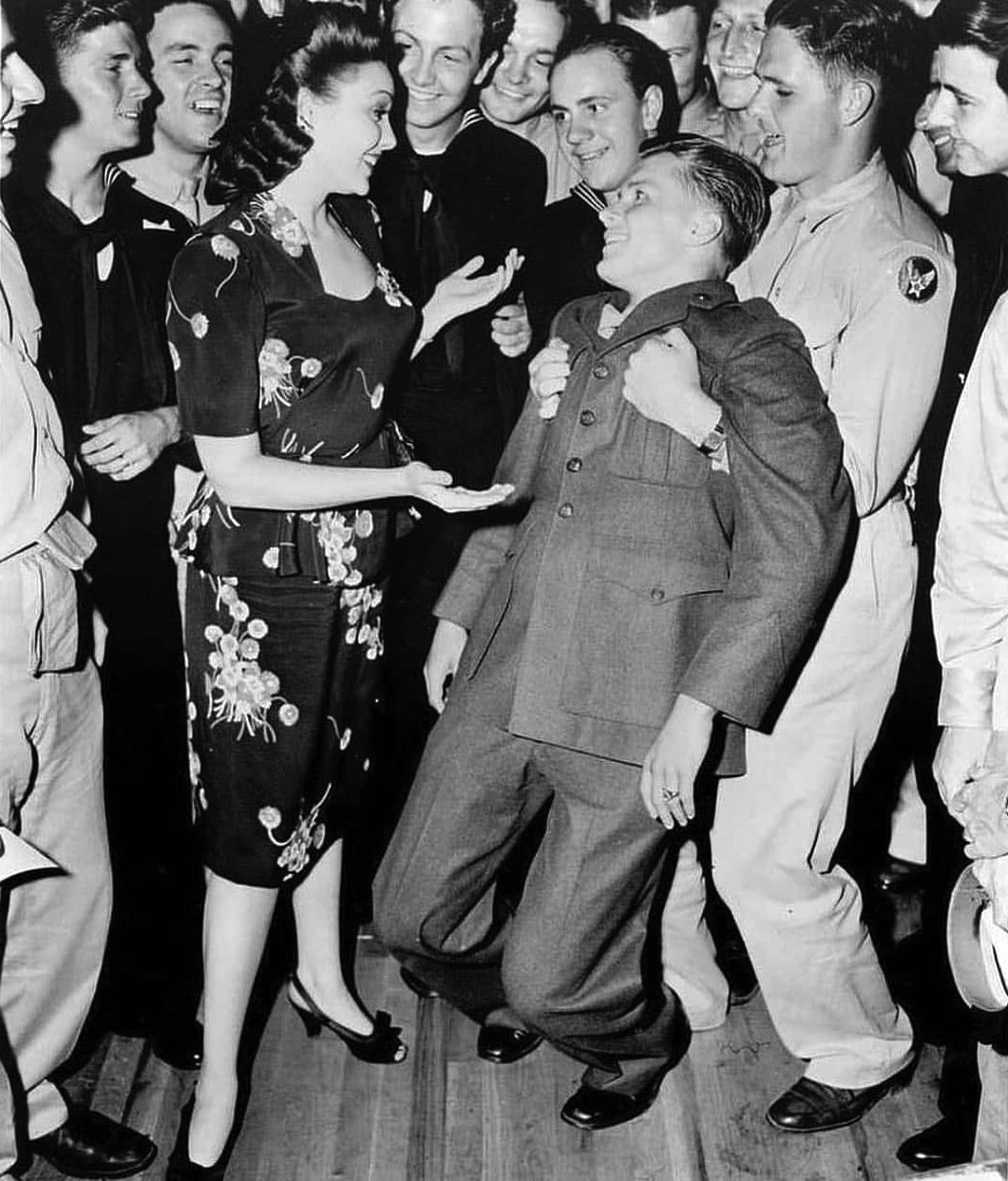 |
|
| (1944)* - A soldier goes weak in the knees after being asked for a dance by Linda Darnell at the Hollywood Canteen. |
Historical Notes The studios loved the Canteen concept because it put them in a good, patriotic light. The stars themselves were keenly aware of the positive PR their evenings at the establishment added to their images. An awful lot of people contributed several evenings of their week, every week for four long years, providing a touch of glamour to the lives of young men far from home and on their way to even farther places, dangerous places, from which many would not return. This kind of commitment from those serving at the Hollywood Canteen was no small thing. They were not donating a few hours to a Telethon and then back to their lives. They were giving of their time continuously without thought of reward or recompense for years! It was a unique moment in history that we shall never see again. |
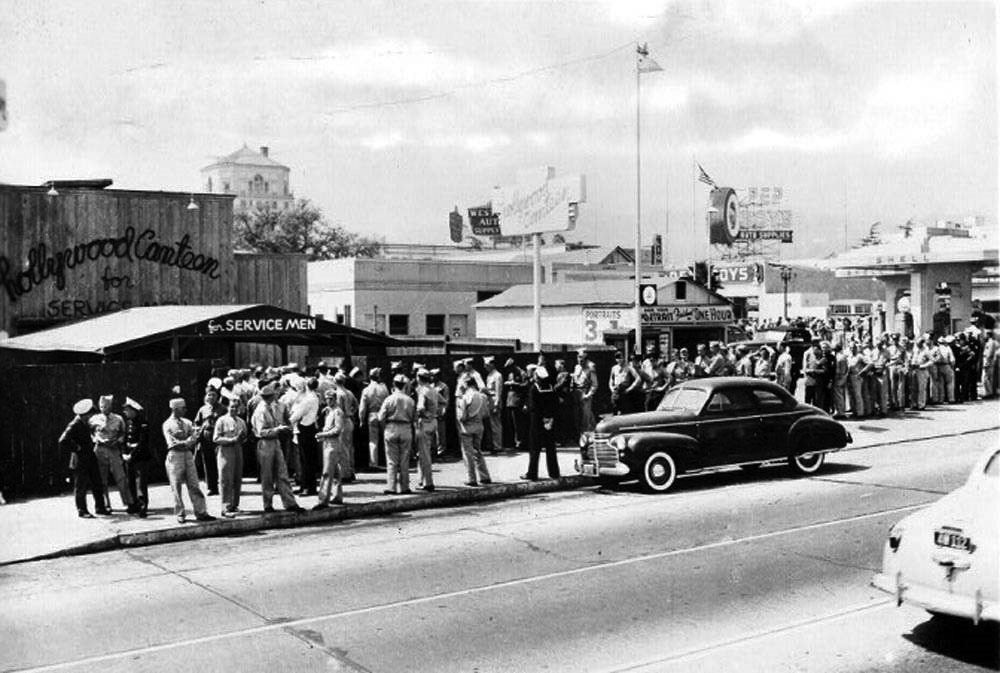 |
|
| (1943)* - View of a long line of servicemen waiting outside the Hollywood Canteen on Cahuenga Blvd. The tall building in the background is the Hollywood Athletic Club on Sunset Blvd. |
Historical Notes On September 15, 1943, the one millionth guest walked through the door of the Hollywood Canteen. The lucky soldier, Sgt. Carl Bell, received a kiss from Betty Grable and was escorted in by another beautiful star, including Marlene Dietrich. |
 |
|
| (1944)* - Looking south on Cahuenga Boulevard at the Hollywood Canteen, showing a long line of servicemen waiting to get in. |
 |
|
| (1940s)* – A group of soldiers hang out in front of the Hollywood Canteen at 1451 North Cahuenga Boulevard. |
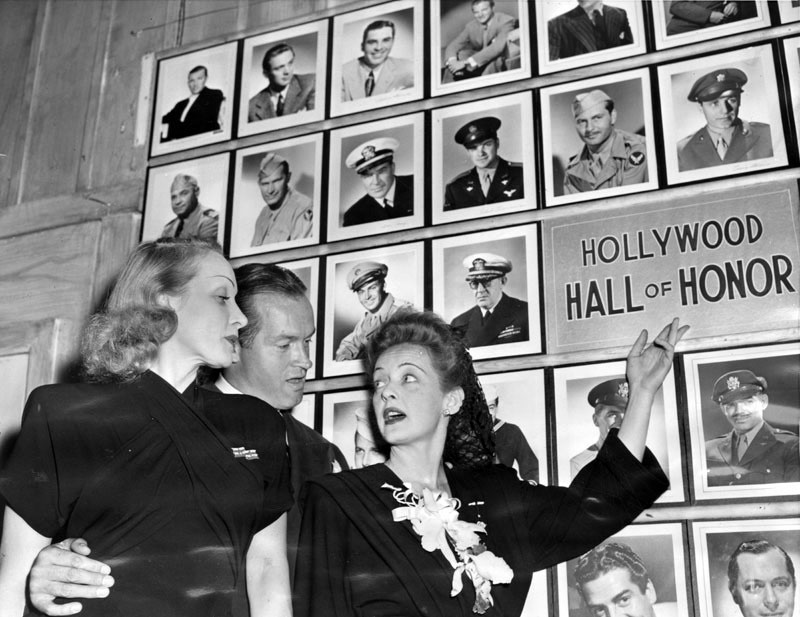 |
|
| (1943)* - Marlene Dietrich, Bob Hope and Bette Davis discuss the Hall of Honor which was unveiled at the Hollywood Canteen's first birthday party. Photo dated: November 3, 1943 |
Historical Notes A Hall of Honor at the Hollywood Canteen had a wall of photos which honored the film actors who served in the military. |
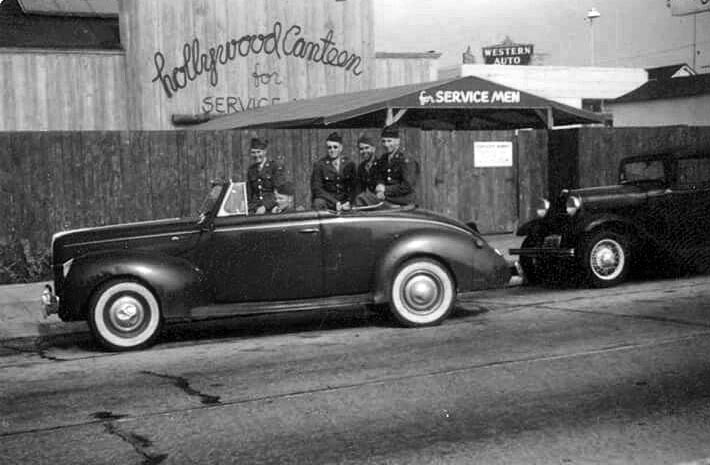 |
|
| (ca. 1943)* – Five uniformed soldiers sit in a car parked in front of the Hollywood Canteen. |
Historical Notes By 1944, the Canteen had become so popular that Warner Bros. made a movie titled Hollywood Canteen. Starring Joan Leslie and Robert Hutton, the film had scores of stars playing themselves. At the time the Canteen closed its doors, it had been host to almost three million servicemen. |
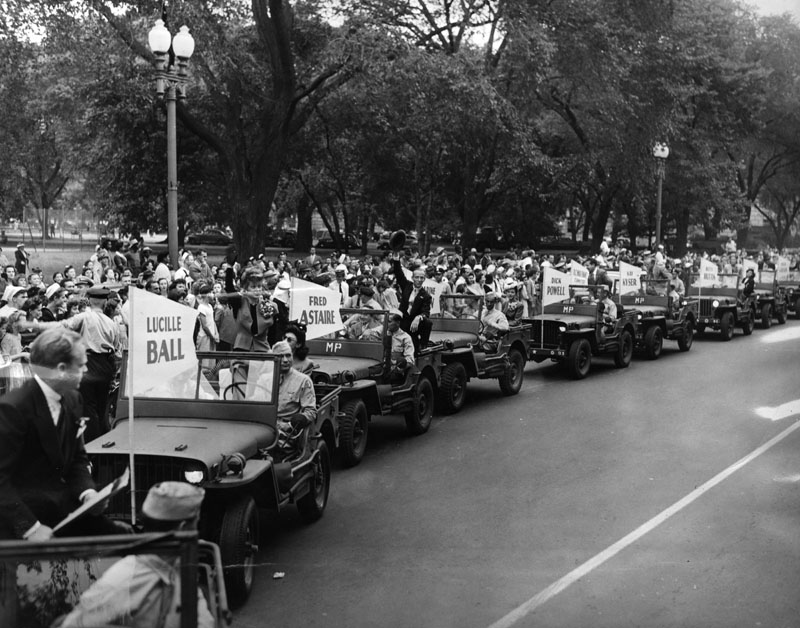 |
|
| (1943)* - Photo of The Hollywood Bond Calvacade parading down the street. A long line of jeeps carries a multitude of stars who wave and smile at the crowds. |
Historical Notes During World War II, major Hollywood celebrities participated in many war bond drives, both in Southern California and on major national tours. The Hollywood Bond Calvacade was a 21 day nationwide tour for the Third War Loan drive. |
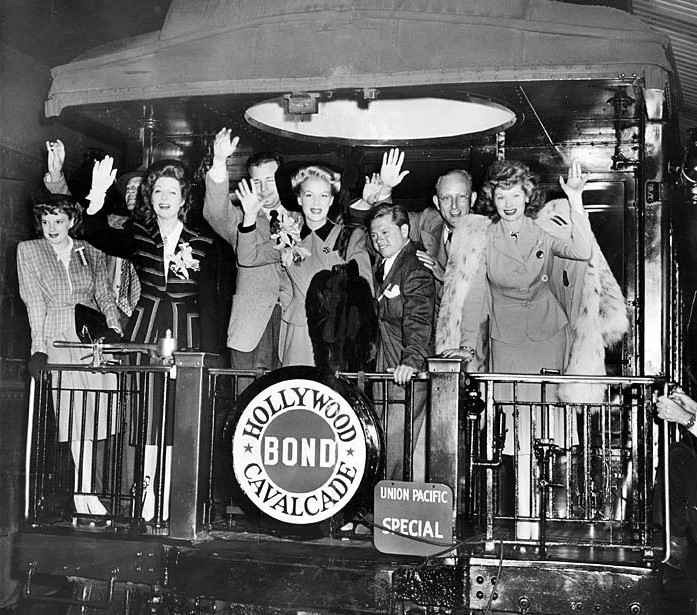 |
|
| (1943)* - Hollywood celebrities leave for Washington to help in the Third War Loan campaign, Sept. 4, 1943. |
Historical Notes From left: Judy Garland, Fred Astaire (face visible), Greer Garson, Dick Powell, Betty Hutton, Mickey Rooney, Kay Kyser and Lucille Ball. |
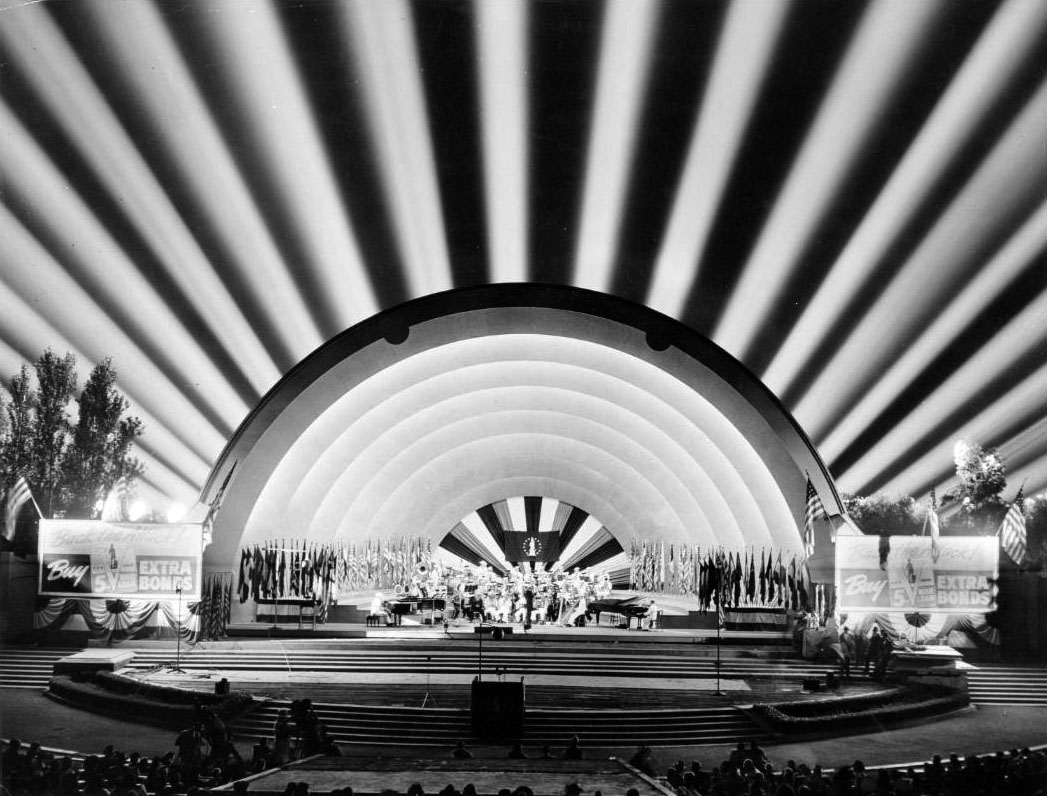 |
|
| (1944)* - Spotlights abound at a War Bonds event at the Hollywood Bowl. |
Historical Notes On June 14th, 1944, radio actors and actresses performed at the Hollywood Bowl during a war bond program. CBS broadcast the event. |
* * * * * |
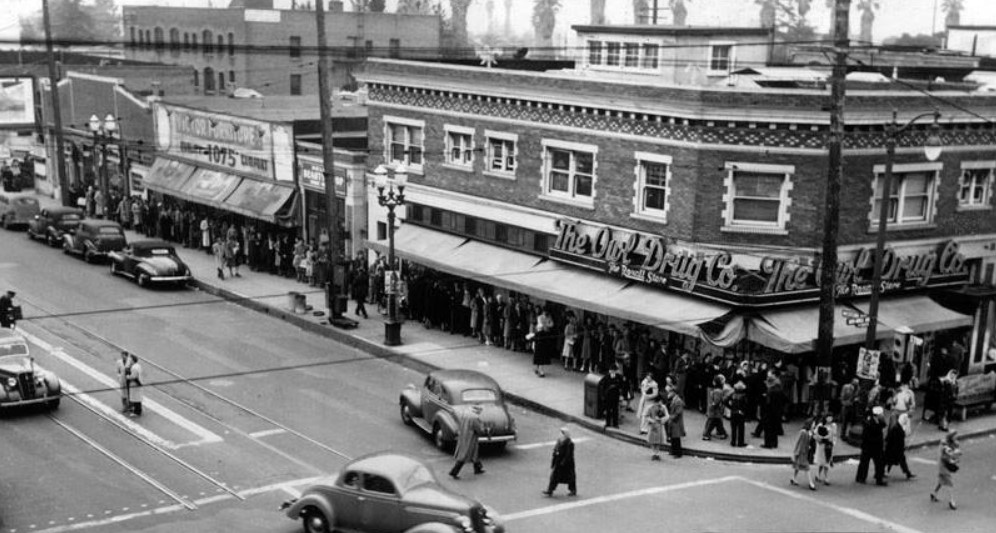 |
|
| (1945)* - Panoramic view showing smokers lined up in front of the Owl Drug store at Santa Monica and Western upon hearing that cigarettes were finally available after a prolonged shortage in March, 1945. |
Historical Notes During World War II, Congress mandated that a certain amount of cigarettes per soldier/sailor/marine be sent to the various military units. Those who didn't smoke usually traded their allotment with others in uniform for food, guard duty, etc. At the same time, the number of people involved in the harvest of tobacco and manufacture of its products was greatly reduced because so many were in uniform. And "Lucky Strike Green has gone to war" was a major advertising slogan promising that when peace was restored cigarettes would again be easily available (until the Surgeon General's report, but the 1940s knew nothing of that). |
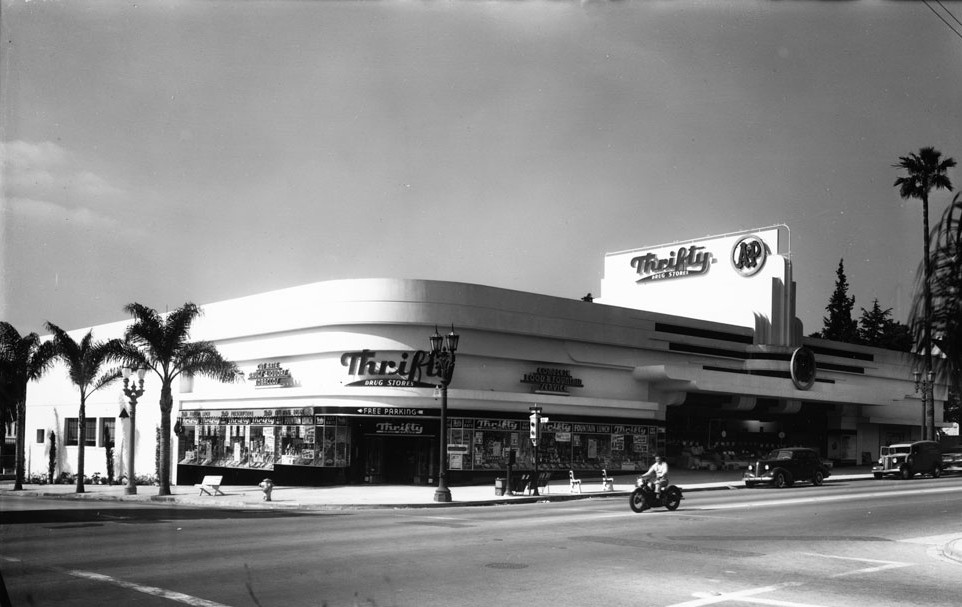 |
|
| (ca. 1940s)^^ - Photograph of an exterior view of Thrifty Drug Store and A&P Market. The one-story Art Deco-style building is pictured on the southwest corner of Sunset Boulevard and Fairfax Avenue. At left, the sidewalk is lined by palm trees. In the right foreground, a motorcyclist makes his way past two parked automobiles. |
Historical Notes Today, a Rite Aid occupies the building on the southwest corner of Fairfax and Sunset. Thrifty PayLess Holdings, Inc. was a pharmacy holding company that owned the Thrifty Drugs and PayLess Drug Stores chains in the western United States. The combined company was formed in April 1994 when Los Angeles-based TCH Corporation, the parent company of Thrifty Corporation and Thrifty Drug Stores, Inc., acquired the Kmart subsidiary PayLess Northwest, Inc. At the time of the merger, TCH Corporation was renamed Thrifty PayLess Holdings, Inc. and Thrifty operated 495 stores, PayLess operated 543 stores. In 1996, Rite Aid acquired 1,000 West Coast stores from Thrifty PayLess Holdings, creating a chain with over 3,500 drug stores.*^ |
 |
|
| (ca. 1940)^^ - Exterior view of the A & P Market and Thrifty Drug Store at Sunset and Fairfax as seen from across the street. This light-colored art deco building has a small overhang with rounded edges below a sign that shows a large "A & P" inside a circle. Above, another large sign faces toward the left with the same A & P sign accompanied by a Thrifty Drug Store sign. At center, the inside of the market is barely visible through the large opening. |
Historical Notes The A&P stores evolved from the Great Atlantic and Pacific (A&P) Tea Company, founded in the 1800s in New York by George Hartford and George Gilman. In 1912, John Hartford, son of the co-founder, came up with the idea of expanding and forming the A&P Econonmy Store chain which would rely on a business model that included standarization of layout and elmination of credit accounts and delivery. The format was wildly successful, and the chain had grown from 585 stores in 1913 to more than 4500 stores by 1920, and to over 15,000 stores all over the east coast and Midwest by 1930. In the early 1930s, the first California stores were opened, adding some credibility to the company name. By the 1960s, A&P stores were stale, sales were flat, and the midwestern and west coast divisions were struggling. A well-publicized corporate reorganization in 1968 and 1969 did little to stem the decline, and the next two decades were defined by declining sales, closing stores, and failed format changes. Among the stores closed were the entire Southern California operation, in 1969, which eliminated A&P as a contender in the fastest-growing market in the country. #^#^ |
Then and Now
 |
|
 |
|
| (1940s) vs. (2018) - Sunset and Fairfax looking southwest. |
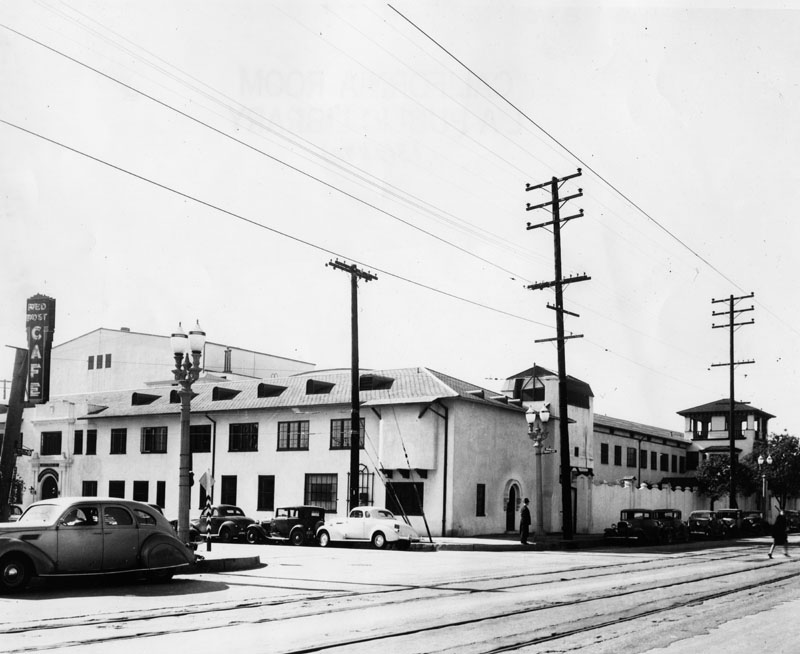 |
|
| (ca. 1943)* - Looking west on Santa Monica Boulevard at Formasa Ave with a view of the Samuel Goldwyn Studios. The Red Post Cafe's sign (later Formosa Cafe) is seen on the southeast corner. |
Historical Notes The 18-acre property on the corner of Santa Monica Boulevard and Formosa Avenue was originally owned by Jesse Durham Hampton, and then became known as the Pickford-Fairbanks Studios. As United Artists began to lure independent producers away from the major studios, many of the producers like Samuel Goldwyn and Joseph Schenck rented offices and stages on the property. In the early 1920s, the “lot” was renamed the United Artists Studio and in 1939 it was renamed again the Samuel Goldwyn Studio.**+ |
Formosa Cafe
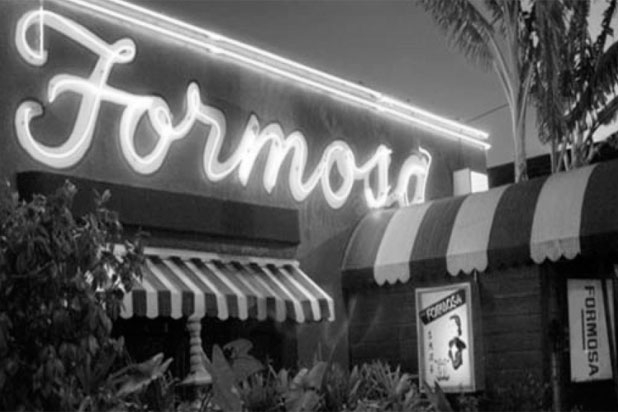 |
|
| (n.d.)*##^ - Exterior view of the Formosa Cafe located on the southeast corner of Santa Monica Blvd and Formosa Avenue. |
Historical Notes The Formosa was founded in 1925 by 1920s prize-fighter Jimmy Bernstein. Bernstein operated his establishment initially in a Red Car trolley located just east of The Lot Studios. In 1945, Lem Quon went into partnership with Bernstein, taking full ownership in 1976 when Berstein died. The restaurant remains in the family with Quom's grandson, Vince Jung, managing it. Generations of movie stars such as Humphrey Bogart and Clark Gable have eaten meals at The Formosa. Frank Sinatra is reputed to have spent many nights at the Formosa in the 1950s, pining over Ava Gardner. In the past, the building housing the Formosa has been described as an "unimpressive, brick-red building with white & black striped awnings, it sits in a particularly faded section of Hollywood, near the corner of Santa Monica & La Brea Boulevards - a corner where hookers have been known to peddle their services even in broad daylight." The City of West Hollywood has since cleaned up the area and a new shopping complex, West Hollywood Gateway, opened in 2004 on the same block.*^ Click HERE to see contemporary view. Click HERE to see more early views of the Formosa Cafe. |
* * * * * |
Please Support Our CauseWater and Power Associates, Inc. is a non-profit, public service organization dedicated to preserving historical records and photos. Your generosity allows us to continue to disseminate knowledge of the rich and diverse multicultural history of the greater Los Angeles area; to serve as a resource of historical information; and to assist in the preservation of the city's historic records.
|
More Historical Early Views
Newest Additions
Early LA Buildings and City Views
History of Water and Electricity in Los Angeles
* * * * * |
References and Credits
* LA Public Library Image Archive
^*California Historic Landmark Listing (Los Angeles)
^ California Historical Society Digital Archive
** Retronaut - Hollywoodland Sign
#* Pinterest - California and DailyBreeze.com; Mid Century Hollywood; Been There: Hollywod Sign
*^#LosAngelesPast.com: Cahuenga Pass
^^#LA Times: 'Swing in, pig out, drive off'; Hollywood Bond Cavalcade; Sunset Vine Tower; Taft Building; Pickwick Bookshop
***The Story of Hollywood by Gregory Paul Williams
**^Table Magazine: LA Observatory
**+Hollywood Renegades Archive: "The Lot"
**#Beguiling Hollywood: The Hollywood Hotel
^**Huntington Digital Library Archive
*^*MTA Transportation and Research Library Archives
*.* Greater Streets: Exploring the Walk of Fame — Heart of Hollywood
^^*Cinema Treasures:Ricardo Montabaln Theater
^^^California State Library Image Archive
^+^Cool Culinaria: Restaurateur Mike Lyman
+^*Jewish Museum of the American West: Restaurateur Al Levy
+^^Don Lee Mutual Broadcasting Building
++#Facebook.com: Photos of Los Angeles
*^^*Photos of Vintage Los Angeles: Facebook.com; Palladium; Capitol Records; Cruising Hollywood Blvd; Masonic Temple; Hody's Coffee Shop
*^#*Calisphere: University of California Image Archive
*^*#Pinterest.com: Favorite Places and Spaces
**^*LA Daily News: Hollywood Sign Celebrates its 90th Birthday
***#Art Deco Architecture: LA Radio City
**##MartinTurnbull: Cross Roads of the World; Biff's Coffee Shop
^^##Alison Martino's Vintage Los Angeles: Wallichs Music City
++##Grauman's Chinese.org: Academy Awards
*#^^Flickr.com - Daniel Pouliot
*##*Squidoo.com: Lawrence Welk
*##^The Daily Meal: Formosa Cafe
^##*Flickr.com: Michael Ryerson; Baytram366; Melody Lane
^###Uncanny.net: Hollywood Pacific Electric Line
^#*#Bellaonline.com: Mickey Rooney and Judy Garland
^#^*Flickr.com: Los Angeles - Back in the Day
^#^^Facebook.com - Vintage LA: Hollywood Palladium; Hollywood and Gower; Hollywood and Vine; Sunset & Vine; Capitol Records Building; United Methodist Church; Hollywood Ranch Market; Wallich's Music City; Tiny Naylors
^^#^History of the Samuel Goldwyn Studio
^^^#KCET's First Hollywood Home: The Historic Mutual-Don Lee Studios
#^**The Go Go's: Local Coffee Shops and Diners
^*#*Pinterest - Memories in the SFV 50's, 60's, & 70's
^*##Vintage Inspired California - marinachetner.com
^*^^Pomona Public Library Poscard Collection
^*^#Facebook.com - Bizarre Los Angeles
#**^Starlinetours.com: TLC Chinese Theatre
#**#Facebook.com: Garden of Allah Novels, Martin Turnbull
#*^#Historic Hollywood Theatres: Warner Bros. Hollywood Theatre
#^*#TheHollywoodMuseum.com: Max Factor Building
#^**The Go Go's: N/W Corner of Hollywood and Vine
#^^^Once Upon a Screen: Hollywood Canteen
#^#^Groceteria.com: A&P History
##**The Story of the Hollywood Sign: allanellenberger.com
##*^The Hollywood Sign: hollywoodsign.org
##*#Flickr.com: Paul Bajerczak
#*##Electric Railway Historic Association: Hollywood PE Line
+###Dear Old Hollywood Blogspot
##^*Facebook.com: Classic Hollywood-Los Angeles-SFV
##^^halfcoastal.com: The Hollywood Sign
***^Pinterest: Travel The World: 'HOLLYWEED'; Los Angeles and Hollywood
*^^ Nuestra Señora la Reina de los Ángeles: Vogue Theater; Hollywood Blvd Night 1930s; Hollywood and Vine ca.56
*^*^#Facebook.com: West San Fernando Valley Then And Now
^^***Pinterest: Diners
^^*^*Los Angeles Magazine: Capitol Records Building Christmas
^^*^^sittininthehills64.blogspot.com: Hollywood Views
*^^**Blogspot.com: Hollywood HoJo
*^#^*Vintage Everyday
^#^#^LA Curbed: Al Levy's Tavern
^###^Flickr.com: timetravelnow
*# Skyscraperage.com. - Griffith Observatory; CBS West Coast Headquarters; LA Fun Map; NBC Hollywood Radio City; Cross Roads of the World; Hollywood and Vine; Orchid Ave and Hollywood Blvd; Max Factor Building; Cahuenga and Yucca St.; Vine and Sunset; Tiny Naylors; Hollywood Frwy Construction at Argyle
*^ Wikipedia: Hollywood; Hollywood Athletic Club; Hollywood Bowl; Grauman's Chinese Theatre; Grauman's Egyptian Theatre; Pantages Theatre (Hollywood); John Hanson Ford Theatre; 20th Century Fox; Samuel Goldwyn.Studio; Barnsdall Art Park; Greek Theatre; Griffith Observatory; Cinerama Dome; Ralphs; Hollywood Palladium; Hollywood and Vine; Hollywood Masonic Temple; Hollywood Pacific Theatre; Max Factor; West Hollywood; Brown Derby; Hollywood Christmas Parade; Tom Breneman; Schwab's Pharmacy; Capitol Records Building; CBS Columbia Square; West Coast Radio City - Los Angeles; Crossroads of the World; Hollywood Sign; Lawrence Welk; Du-Par's Restaurant; Formosa Cafe; Hollywood Walk of Fame; Marilyn Monroe; John C. Austin; KFWB; The Beatles at the Hollywood Bowl; 2005 Hollywood Sign; Rexall - Owl Drug Store; Hollywood Canteen; KABC; Wallichs Music City; Thrifty Drug Stores; Lasky-DeMille Barn; Mt. Lee; The Wizard of Oz ; Hollywood Roosevelt Hotel; Eddie Cochran; Guarantee Building; Hollywood United Methodist Church; Carolina Pines, Jr.; Vista Theatre
< Back
Menu
- Home
- Mission
- Museum
- Major Efforts
- Recent Newsletters
- Historical Op Ed Pieces
- Board Officers and Directors
- Mulholland/McCarthy Service Awards
- Positions on Owens Valley and the City of Los Angeles Issues
- Legislative Positions on
Water Issues
- Legislative Positions on
Energy Issues
- Membership
- Contact Us
- Search Index